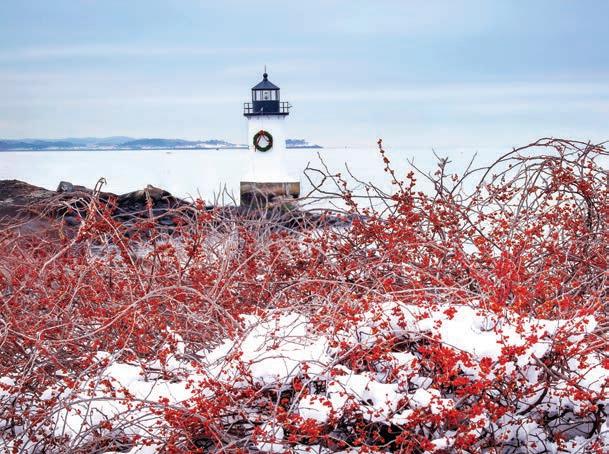HOME & GARDEN

IF THESE WALLS COULD TALK
Step inside the 1851 farmhouse where Russ Morash launched a DIY revolution, p. 74







IF THESE WALLS COULD TALK
Step inside the 1851 farmhouse where Russ Morash launched a DIY revolution, p. 74














62 /// Estates of Grace
Cultivate your sense of wonder amid New England’s historic garden landscapes. By Kim Knox Beckius
74 /// Master of the House
When it came to building a new genre of television, This Old House creator Russ Morash went DIY all the way. By Bruce Irving
80 /// Silent Witness
Seeing the Bunker Hill Monument soaring skyward,
we’re reminded that it holds national memories that run incredibly deep. By Howard Mansfield
84 /// The Lobster Trap
When you grow up with generations of tradition, change can be both welcome and feared. By Ian Aldrich
92 /// Blast from the Past
Nearly 90 years after Mount Washington was struck by world-record-setting winds, one writer heads to the summit to conjure up that historic day. By Rachel Slade







On this enchanting 9-day cruise from Charleston to Amelia Island, experience the charm and hospitality of the South. In the comfort of our modern fleet, travel to some of the most beautiful historic cities in America. The fascinating sites you visit, the warm people you meet, and the delectable cuisine you taste, come together for an unforgettable journey.
Small Ship Cruising Done Perfectly







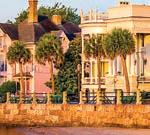


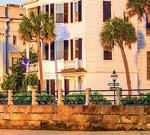












26 /// Rock Stars
How a 19th-century masonry technique from Scotland created a treasure trove of rare buildings in Vermont. By Bruce Irving
32 /// Feats of Clay
In the home or in the garden, the whimsical creations of D. Lasser Ceramics lend a welcome jolt of color. By Bill Scheller
36 /// Lessons of a Very Old House
What a three-century-old Colonial taught its owner about his place in the world today. By Lee McColgan

10
INSIDE YANKEE
On the eve of retirement, our editor looks back on his own long stretch of Yankee ’s 90-year history.
16
PERSON
40 /// Season’s Greetings
A food-forward preview of Weekends with Yankee season 9, premiering on public television stations this spring. By Amy Traverso
46 /// In Season
Maple syrup shines in these sweet and savory recipes. By Amy Traverso

One last ski day reminds a father how quickly children grow up. By Brian Kevin
18
Tracing a maple syrup empire back to a boyhood dream. By Annie Graves
Fenway Park’s eye-catching tribute to Ted Williams’s record-setting home run. By Todd Balf
120
LIFE IN THE KINGDOM
Some places we never leave, but instead carry with us all our lives. By Ben Hewitt
50 /// Weekend Away
A proud history of invention meets a thoroughly modern mix of art, culture, and dining in Worcester, Massachusetts. By Annie Sherman
58 /// Flair Fresheners
Our roundup of New England home and garden shops that are worth the drive. By Elyse Major
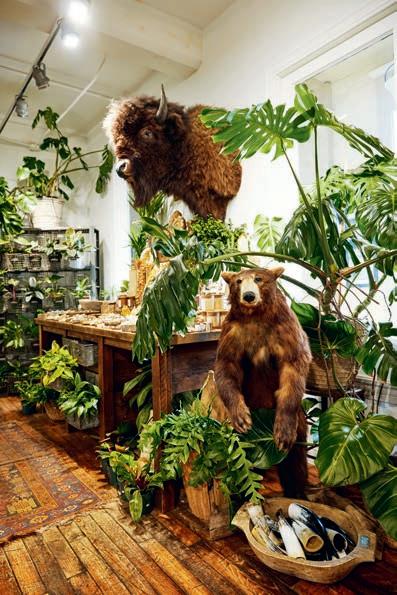
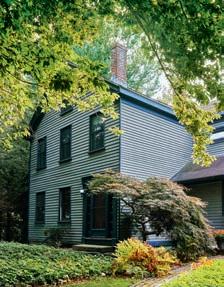




Artists from around the world will convene in South County, RI this May to compete in a sand sculpture competition for a cash prize. Come watch, them work, see live music, shop, eat, and play! May 30 - June 1 in Ninigret Park. Learn more at SouthCountyRI.com










Publisher Brook Holmberg
Editor Mel Allen
Senior Managing Editor Jenn Johnson
Executive Editor Ian Aldrich
Senior Food Editor Amy Traverso
Senior Digital/Home Editor Aimee Tucker
Travel/Branded Content Editor Kim Knox Beckius
Associate Editor Katrina Farmer
Contributing Editors Ben Hewitt, Rowan Jacobsen, Nina MacLaughlin, Bill Scheller, Julia Shipley, Kate Whouley
ART
Art Director Katharine Van Itallie
Senior Photo Editor Heather Marcus
Contributing Photographers Adam DeTour, Megan Haley, Corey Hendrickson, Michael Piazza, Greta Rybus
PRODUCTION
Director David Ziarnowski
Manager Brian Johnson
Senior Artists Jennifer Freeman, Rachel Kipka
Vice President Paul Belliveau Jr.
Senior Designer Amy O’Brien
E-commerce Director Alan Henning
Digital Manager Holly Sanderson
Marketing Specialist Jessica Garcia
Email Marketing Manager Eric Bailey
Customer Retention Marketer Kalibb Vaillencourt
E-commerce Merchandiser Specialist Nicole Melanson
ADVERTISING
Vice President Judson D. Hale Jr.
Media Account Managers Kelly Moores, Dean DeLuca , Steven Hall
Canada Account Manager Cynthia Fleming
Senior Production Coordinator Janet Selle
For advertising rates and information, email sales@yankeepub.com or go to newengland.com/adinfo.
ADVERTISING
Director Kate Hathaway Weeks
Senior Manager Valerie Lithgow
Marketing Assistant Natalia Rivera
PUBLIC RELATIONS
Roslan & Associates Public Relations LLC
YANKEE PUBLISHING INC.
ESTABLISHED 1935 | AN EMPLOYEE-OWNED COMPANY
President Jamie Trowbridge
Vice Presidents Paul Belliveau Jr., Ernesto Burden, Judson D. Hale Jr., Brook Holmberg, Jennie Meister, Sherin Pierce
Editor Emeritus Judson D. Hale Sr.
CORPORATE STAFF
Vice President, Finance & Administration Jennie Meister
Human Resources Manager Beth Parenteau
Information Manager Gail Bleakley
Assistant Controller Nancy Pfuntner
Accounting Associate Meg Hart-Smith
Accounting Coordinator Meli Ellsworth-Osanya
Executive Assistant Christine Tourgee
Maintenance Supervisor Mike Caron
Facilities Attendant Ken Durand
BOARD OF DIRECTORS
Andrew Clurman, Renee Jordan, Joel Toner, Jamie Trowbridge, Cindy Turcot
FOUNDERS
Robb and Beatrix Sagendorph
NEWSSTAND
Vice President Sherin Pierce
NEWSSTAND CONSULTING
Linda Ruth, PSCS Consulting
SUBSCRIPTION SERVICES
To subscribe, give a gift, or change your mailing address, or for any other questions, please contact our customer service department:
Mail: Yankee Magazine Customer Service P.O. Box 37900, Boone, IA 50037-0900
Online: newengland.com/contact-us
Email: customerservice@yankeemagazine.com
Toll-free: 800-288-4284
Yankee occasionally shares its mailing list with approved advertisers to promote products or services we think our readers will enjoy. If you do not wish to receive these offers, please contact us.


Yankee Publishing Inc., 1121 Main St., P.O. Box 520, Dublin, NH 03444 / 603-563-8111 / editor@yankeepub.com Printed in the U.S.A. at Quad Graphics
Hosts Amy Traverso, Richard Wiese
Directors of Photography
Corey Hendrickson, Jan Maliszewski
Editor Travis Marshall
Executive Producer Laurie Donnelly
Senior Producer Mercedes Velgot
Associate Producer Nora Kirrane
American
Massachusetts
New
Country
Grady-White Boats












he first time I knew the feeling of leaving home I was a month shy of 11, though what I felt then was home leaving me. My mother, sister, and little brother went to spend the summer on the island of Jamaica, where my mother had grown up and where her parents still lived. I stayed home to play Little League. A strange sense of loneliness soon settled in, as I waited all day in the unfamiliar quiet for my dad to come home to take me to practice or a game, and afterward we’d go to a diner or simply open a carton of ice cream. I never forgot what I learned that summer: Home did not just mean a roof and walls and familiar rooms, but the people you lived with inside.
Since then, I have left numerous homes: off to college, leaving college, leaving the Peace Corps, leaving Maine. Then I came to Yankee in October 1979—and never left. I have been part of more than 400 issues of this magazine. I have lived tens of thousands of hours inside this sprawling red building, have worked alongside so many people here, have known and published so many writers. There has been little distance for me between home with family and my second home here with another family— one where day after day we talk ideas, plan issues, look at layouts, meet in hallways and offices, look after each other.

My coworkers have been part of my life for so long that I’ve been here when their children were born and I’ve seen those kids grow up and have their own children. I have lost colleagues I will never forget, and I have welcomed new ones I will never forget.
For the past few years, when people asked me when I was going to retire, I replied by saying they don’t understand the feeling of holding a new issue in their hands, or of finding a story that arrives unassigned, like a stranger knocking on the door asking to come in, and then
beginning to read it and knowing Yankee ’s readers will want to read it, too. They don’t understand what it’s like to get a phone call from a friend to say she’s seen a Facebook post about a Maine lobsterman named Joel Woods who takes photos of a life that few of us ever know. And then to sit in Woods’s cottage on the Maine coast and see his work, and then publish it, and then enter it in the annual City and Regional Magazine Association contest to be judged against photos by professionals across the country. (Joel Woods took first place.)
And then there is that hard-to-define connection with readers, so strong at times I can almost hear their voices when they write. I have kept hundreds of their cards and letters and several thousands of their emails, which speak to a bond that runs deeper than just editor and subscriber. They want me to know how much Yankee means to them. They tell of losses in their lives and how Yankee kept them grounded, how we have kept New England alive for them no matter where they live. They talk about their family as if we here at Yankee all belonged, too.
They write things like this: Dear Mel, I think I can be so familiar as to call you by your first name though we have never met in person; we have known each other for decades, though only through Yankee.
Or this one, a nod to my long-standing editor’s photo: Check your closet, Mel. Caught between all those red shirts must be one navyblue or forest-green shirt you could don for Yankee issues. Please?
But there is always an end time. There is always a sense that if not now, when?
In early January, our conference room filled with everyone who works here in Dublin as well as former colleagues who had left or retired. We all enjoyed some good food, and then I told them what they
had meant to me, and they told me what I had meant to them. And I am 78 but I felt like a boy as I tried, not always successfully, to choke back tears when a colleague was doing the same.
If you were in the room with us, I would have wanted you to know this: Many days I walk with several editors to a dirt path that runs past a pretty cemetery and ends at a spot where we gaze out upon lake and mountain. And each time I say, “Can you believe how lucky we are to see this where we work?”
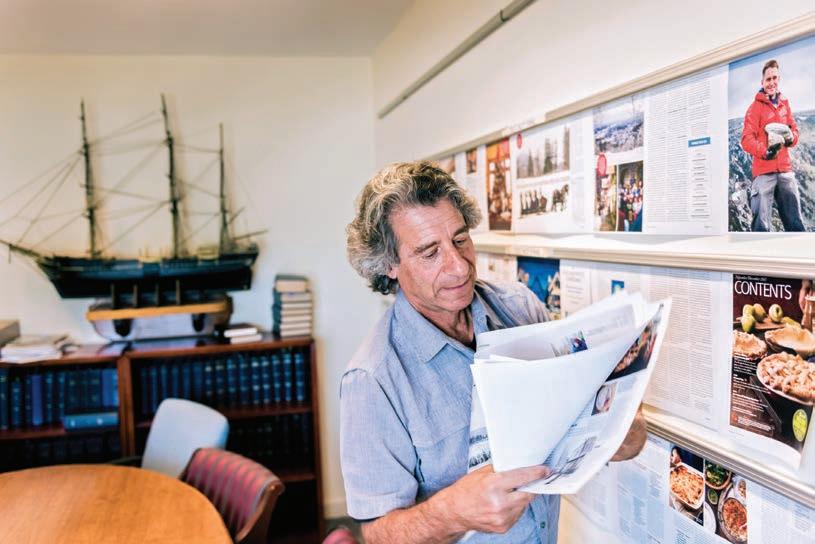
I’d want you to know how we pulled together during the pandemic and saw one another only on a screen, and we still put together issues that made us all proud.
I’d want you to know about the time Rudy, my Jack Russell, escaped from my car in the Yankee parking lot and I was certain I’d lost him forever. But within an hour my staff had made “Lost Dog” posters, and everyone fanned out to distribute them and to look for Rudy. And late that night, as I lay in the back of my car at Yankee, hoping somehow Rudy would find his way back, my colleague Joe arrived at the parking lot. Driving once more along the darkened roads, he’d found Rudy walking along the highway and called him into the truck. Now, he held Rudy out to me.
I’d want you to know about working alongside Jud Hale, the former editor in chief whose uncle Robb Sagendorph started Yankee in 1935, and hearing him walking to his office calling hello to everyone he passed. And how Sarah, an editor with The Old Farmer’s Almanac, whose offices are just down the hall, always bakes me a chocolate zucchini bread for my birthday because she knows it’s my favorite.
I’d want you to have seen me this past New Year’s Day, alone in my office, stepping over the plastic crates I’d brought to fill
with what I had saved all these years— which seems to be nearly every manuscript, notebook, calendar, magazine, and newspaper clipping, plus enough odds and ends to fill my newly rented storage unit a few miles away. When I took down all the cards from readers and photos from my bulletin board, I remembered the boy from a long-ago summer who had the sensation of home changing right then and there, and I was glad I was alone on New Year’s in my office.
So this is the last issue of Yankee with my name at the top of the masthead. For 90 years, Yankee has evolved, always changing, because times and challenges change. But this remains: We are New England’s voice, whether in this magazine in your hands, or our Weekends with Yankee TV show, or our website and newsletters, or even our online New England Store.
Now, I will be working on a collection of my stories, and I will continue looking for new ones to write. You can find me at melallen716@gmail.com. I leave knowing that the people I have worked with for so long, who care about this region so deeply, will continue to do the work they do so well. I will always hold them close. I will still come by and join the walk on the dirt path to where lake and mountain appear. And I am certain that if I ever lose my way, they will find me and bring me home.
After becoming editor in chief in 2006, Mel continued to report and write stories for Yankee even as he shepherded the work of countless other storytellers— both seasoned journalists and first-time authors—into the magazine’s pages. This photo of Mel reviewing proofs for an upcoming issue is taken from a 2015 New York Times article about Yankee’s 80th anniversary (and yes, Mel’s famous Jack Russell terrier, Rudy, managed to get a mention, too).
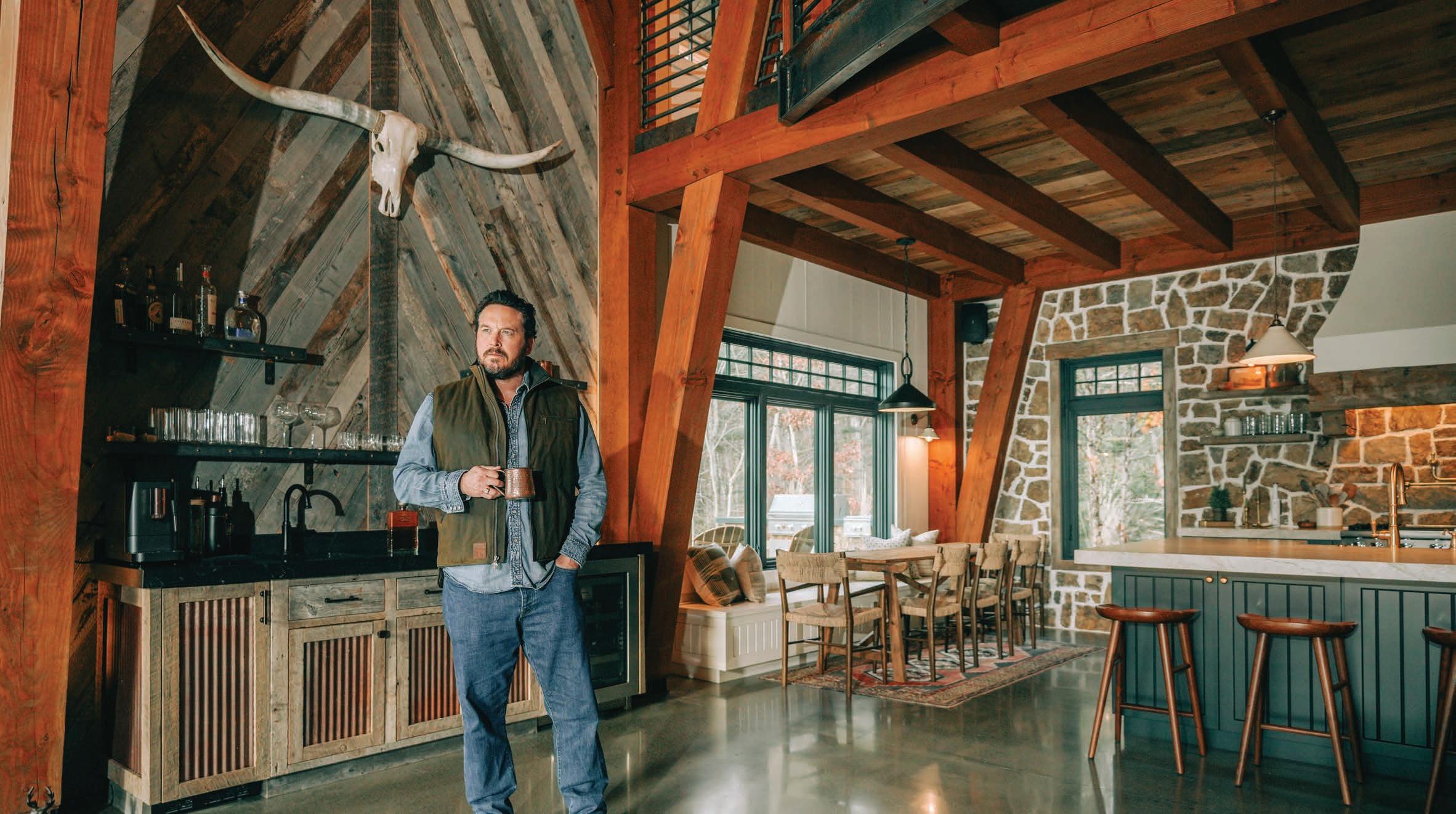
[ COLE HAUSER × THE BARN YARD ]
AUTHENTIC POST & BEAM BARNS








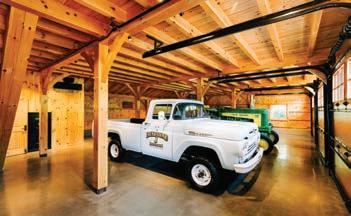
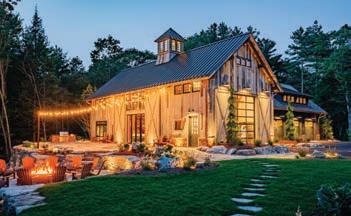
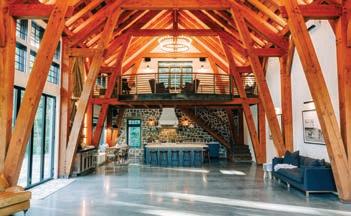







Eleven generations of Sherman’s family have called Rhode Island home, creating deep New England roots that influence her work today as an independent journalist and editor. In writing about Worcester, Massachusetts [“Weekend Away,” p. 50], she was initially drawn to the city’s industrial history but was pleasantly surprised by the contemporary creative undercurrents running through its museums, music venues, and public art installations. “That its food scene is so vibrant was another perk!”
In photographing the coastal town of Stonington, Maine [“The Lobster Trap,” p. 84], Spinski was reminded that while the culture, the beauty, and the fishing economy of such a community can feel as though they’ve always existed, “it’s the hardworking folks who live there who make it possible through vision and enormous effort…. It’s a place to be treasured.” A resident of midcoast Maine, Spinski has also had his work published by The New York Times and National Geographic, among others.
Building lean-tos, damming up streams to make swimming holes, sculpting everyday objects from hand-dug clay—having done all these things as a boy in the Vermont woods, McColgan finds they have resonance in his life today [“Lessons of a Very Old House,” p. 36]. “In doing historic preservation work, which requires the use of minimally processed materials—dry-laid stone, hewn timbers, putty for glazing windows—I see an extension of the activities I loved as a kid. A more refined version, anyway.”
“I loved the opportunity to shoot really delicious recipes—since not all recipes are!” says Barboza of photographing our Weekends with Yankee food feature [“Season’s Greetings,” p. 40]. Food is a subject in which she has more than dabbled, having shot threedozen-plus cookbooks and collaborated with several food brands; she’s also a photo instructor with a focus on food photography. Barboza lives in southern Vermont, where she and her husband run Poppy Bee Surfaces, a photography supply specialist.
While no stranger to visiting Worcester, Massachusetts, on photo assignments, Campos says “Weekend Away” [p. 50] was her first chance to explore the city from a traveler’s perspective. “I hit the ground running each day because there was so much to see and do,” says Campos, a Massachusetts-based photographer whose client list includes Bon Appétit and Edible Boston. Delighted by her visits to places like the Worcester Art Museum and the EcoTarium, Campos is looking forward to returning soon
Yankee’s go-to architecture writer has not one but two bylines in our Home & Garden issue, with a deep dive into a historic masonry technique [“Rock Stars,” p. 26] and a feature on the late Russ Morash, a giant in the public television world [“Master of the House,” p. 74]. As a longtime producer on Morash’s This Old House and its sister shows, Irving found writing the latter story to be especially meaningful: “Russ was a mentor, an inspiration, and one big reason I came to love the history of New England.”
My January/February issue of Yankee magazine arrived last night, and I am mesmerized by the cover. Having grown up in Russell, Massachusetts, it was always heartwarming when I could visit a tavern that had a flickering fire to enjoy a meal and beverage. The Publick House in Sturbridge was always a favorite day trip; so was the Red Lion Inn in Stockbridge.
Since relocating to Florida almost six years ago, when I see photos like the one on your cover it takes me back to my time spent with friends at places like these. Thanks for the memories.
Lori Szepelakl Ocala, Florida
As always, the latest issue of Yankee has warmed my heart and informed me of so many wonderful New England people and places. I read Ben Hewitt’s offering [“Force of Nature,” January/ February] with a lump in my throat, as I, too, am a parent. Please pass along to him these words of wisdom from a mother and grandmother: The best and most important gifts we can give our children are love and wings. He has given his son Rye both, and father and son will survive and young Rye is sure to thrive.
Sandy Couture Brookfield, Massachusetts
Readers of our museum-themed feature “The Great Indoors” [January/ February] had to rely on the art of deduction to puzzle out the photos for Connecticut’s Florence Griswold Museum on pages 62 and 63, as the caption was inadvertently dropped from the layout as we were going to press. To see that caption alongside images of Florence Griswold’s muralfilled dining room, Everett Warner’s Winter on the Lieutenant River, and Mark Dion’s New England Cabinet of Marine Debris (Lyme Art Colony), check out the January/February Yankee online at issuu.com/yankeemagazine






Last call has come and gone at Bullwinkle’s, the mid-mountain saloon at Sugarloaf where better skiers than me gather to sneak in cold ones before the day’s final run. I am, uncharacteristically, sticking to water, rehydrating and resting my shaky legs as my son builds tiny snowmen on the railing of the outdoor bar. It’s been a long day on the slopes.
Otis and I weren’t expecting to sneak in one last ski day. Then the weather app chimed to say that the mid-March storm dumping freezing rain on our local hill, on Maine’s midcoast, had blessed the state’s western high country with a few inches of fresh powder—just in time, wouldn’t you know, for an in-service day at the elementary school.
So I played hooky. We got up before
dawn, ate gas-station donuts, and were in line for the SuperQuad by 8:30.
Now we’re skiing up to the lip of a mildly precipitous trail called Scoot. The day’s stubborn gray skies have finally cleared, and the views of Bigelow Mountain and the Carrabassett Valley are the stuff of alpine reverie. For hours, we’ve been skiing through a pleasantly otherworldly fog, tracing line after wavy line down the sockedin cruiser trails of Sugarloaf’s West Mountain—green trails all of them, on a newly opened section billed as family-friendly.
The upper part of Scoot, however, is a blue trail: intermediate. But unlike Otis, I am not yet an intermediate skier. What’s more, the two of us can see—not 50 yards ahead and dismayingly far below—a pair of patrollers
lifting an alert but injured woman onto a litter. Otis senses my hesitation.
“Are you ready, Dada?” he asks.
At 10, he still calls me “Dada,” a habit I don’t imagine he’ll nurse much longer. I am relishing its last gasps, because I know—have spent the past decade being told, by parents of older and even grown children—that it goes by so fast. This is one of a thousand clichés about parenting that turn out to be indisputably true. Yesterday, I was taking a 5-year-old to the Snow Bowl for his first Stump Jumpers lesson. Tomorrow, he’ll be a teenager skiing black diamonds with his daredevil friends.
It took Otis learning to ski for me to finally learn. I grew up on the glacial plains of the Midwest, where the ski hills were few and forgettable. Not until my 40s, when the kiddo needed a lift buddy, did I tepidly take to downhill. Now, middle-aged beginner though I am, it’s one of my favorite things about a New England winter.
Ending our season at a megamountain like Sugarloaf feels like a milestone. For the past few years, we’ve stuck to Maine’s mom-and-pop hills, sharing T-bars and aging double chairs and dollar cocoas in the lodge. Otis, increasingly competent, was ready to level up. He isn’t fearless, but he’s brave—and patient with his dad. When I fall, he stops and asks earnestly, “Are you all right, Dada?” I don’t dismiss his concern or hide how cautiously I probe my body for the answer.
It won’t be long before I can’t keep up with him. Or, of course, before he’d rather hit the lifts with his buddies than with his old man. And so I will happily sneak in all of the one last ski days I can get.
We stare down the snaking trail in front of us, dappled with late-day sun filtering through the trees. “Do you want me to go first?” Otis asks. And I do.
“OK,” he says. “Here I go, Dada!” He leans forward, gets a good push, and lets out a small, jubilant yelp as he whizzes past me. He goes by so fast.









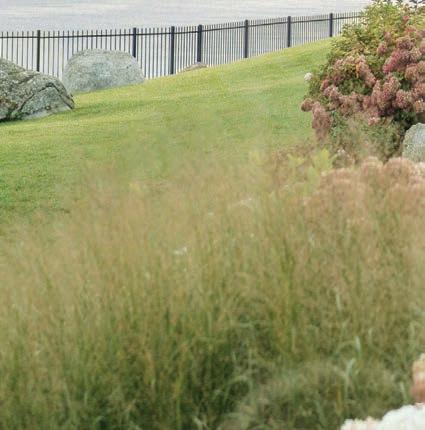





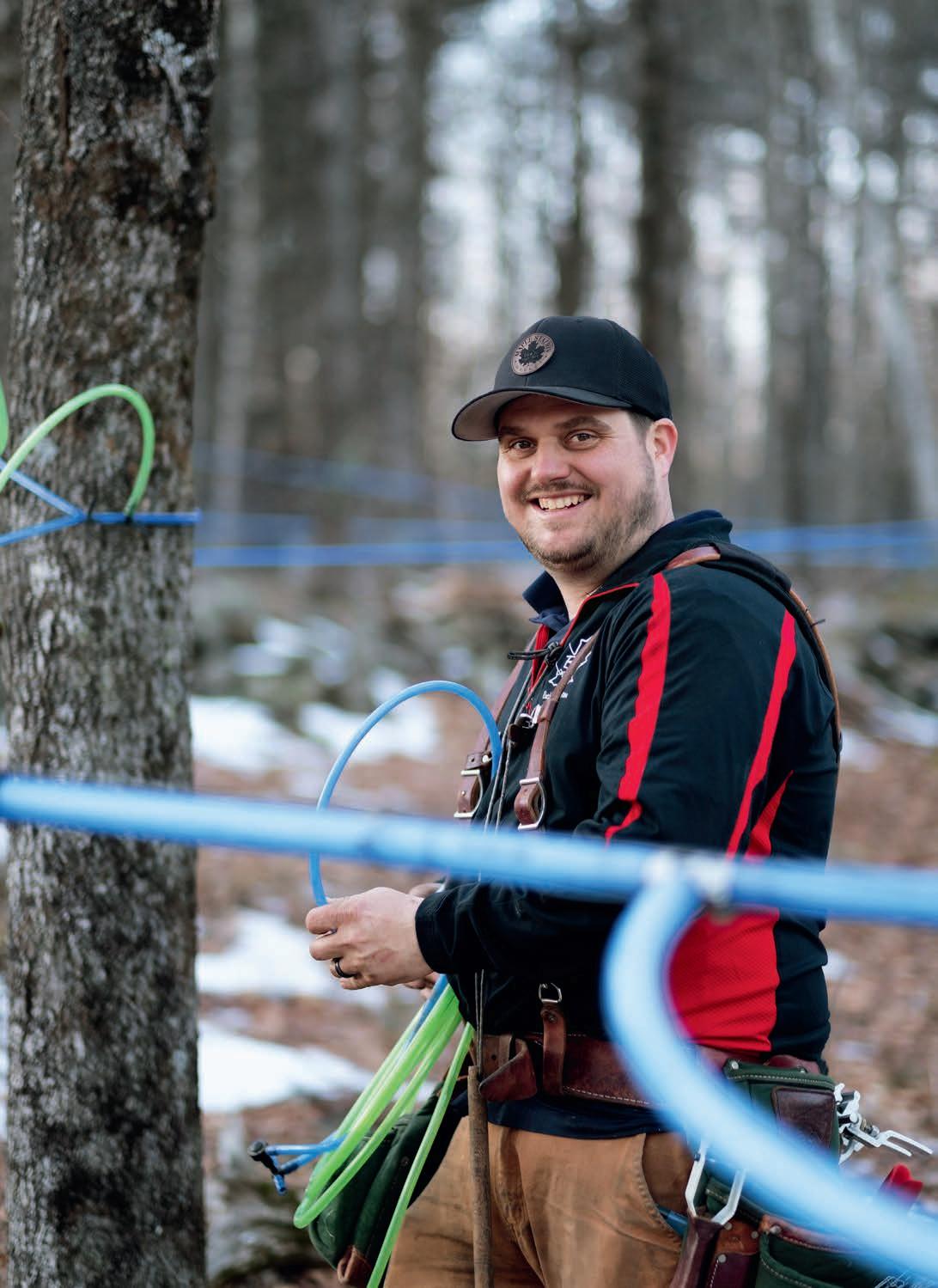

For New Hampshire’s Ben Fisk, a childhood dream has become a maple empire.
BY ANNIE GRAVES
n 1993, when he was 5 years old, Ben Fisk took a field trip to a sugarhouse with his Temple, New Hampshire, preschool class. It’s not hard to imagine the excitement of these little kids, taking their first deep dive into the alchemy that winds up as a delicious puddle on pancakes. And it’s easy to conjure their delight in coming in from the cold and being enveloped in clouds of moist, fragrant steam. To picture the sticky fun of sampling different grades, from light to dark; the magic of sugar on snow; the sugar high that followed. Maybe they got to take samples home. Maybe they thought a little
harder about what they were pouring onto their pancakes the next time.
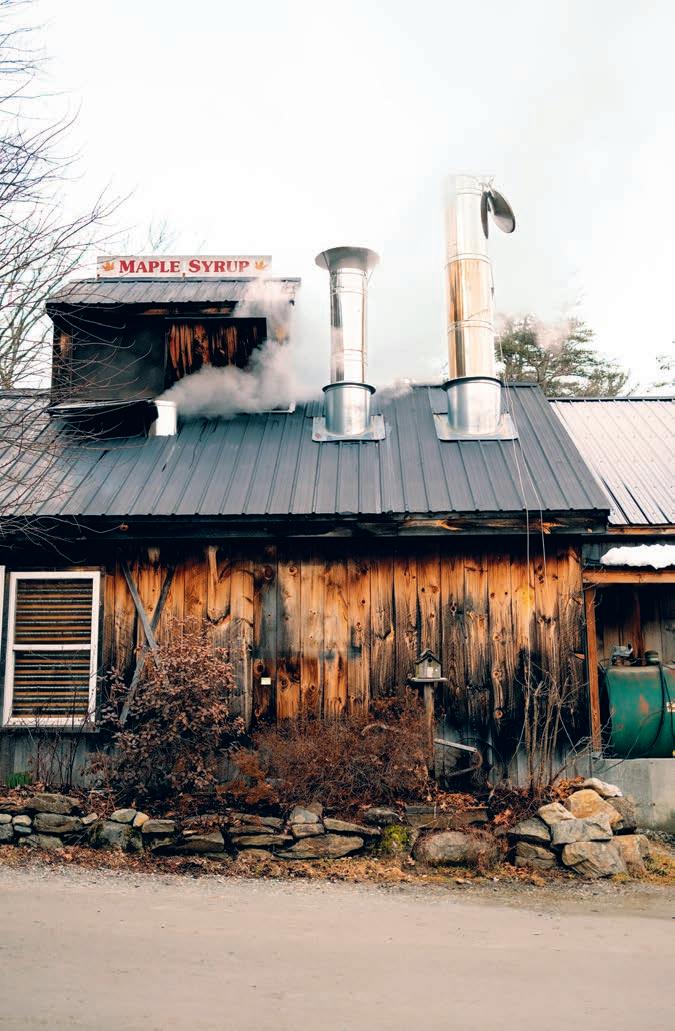
What’s less predictable is obsession. Passion. Because at the age of 5, Ben Fisk could not stop talking about syrup. He’s a fifth-generation maple maker, so it was only natural that his dad knew how to make it and his grandparents had the tools to get him started. “We borrowed 13 sap buckets from my grandfather and asked the neighbor if we could tap their trees,” he says. That year he produced less than a gallon, but he admits he talked about it “nonstop.” For a Christmas present, his parents bought him an evaporator. Now he was 6.
Fisk’s genial bearded face, outdoorsy demeanor, and ready laugh belie the seeds of intensity and focus that were surely there even three decades ago. When he thinks back on what hooked
At the age of 5, Ben Fisk could not stop talking about syrup. For Christmas, his parents bought him an evaporator.
him about sugaring, he confesses, “I was so young, I don’t remember all of it, but it was probably the process.” Then he grins. “It’s an open flame! You’re getting to play with fire! The sap is coming out of trees! It was all interesting to me.”
Back then, everyone in the area knew about the whiz kid from Temple, the eventual owner and founder of Ben’s
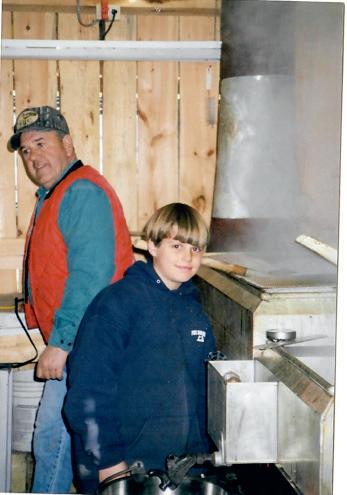
Sugar Shack. After that first year, he tapped 200 more trees, and then kept adding. In the summer, he sold lemonade and maple syrup outside the Temple Store, in the center of this small, historic town. His dad built a sugarhouse that still sits on the family property. Someone had to drive him around to collect the sap, until he was old enough to get his own license. And still he kept adding trees. You’d read about him in the local papers, charting his growth by taps and awards, rather than years. When he was 15, he won the coveted Carlisle award from the New Hampshire Maple Producers Association for the best maple syrup in the state—and was the youngest ever to win.
He hit the big time when he launched his first website in 2003 and the Associated Press got wind of it. “They wrote this great article, everyone published it, and our website blew up,” Fisk remembers gleefully. “I had to take a few days off from school to fill the orders that came pouring in.” Which is funny, because he’d always told his teachers he was going
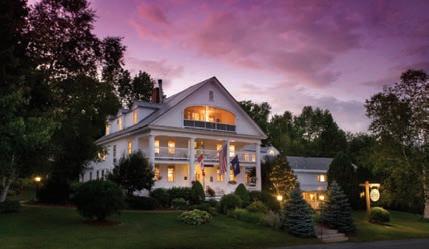
An adults-only haven in Vermont’s Northeast Kingdom. Enjoy luxury accommodations, High Tea with pastries, Stave Puzzles, ne dining at 24 Carrot, and cocktails at the Snooty Fox Pub.
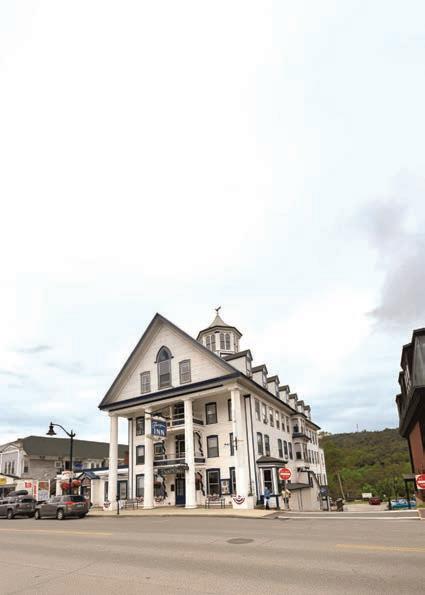
rooms, and savor tapas and cocktails at Sour’s Taverna. Explore nearby trails, bridges, and the famous Chutters candy counter.
Stay at one of the Jackson Collection inns and enjoy access to amenities at all three. A complimentary shuttle connects you to dining, pools, spas, tness centers, and more for a complete Jackson experience.
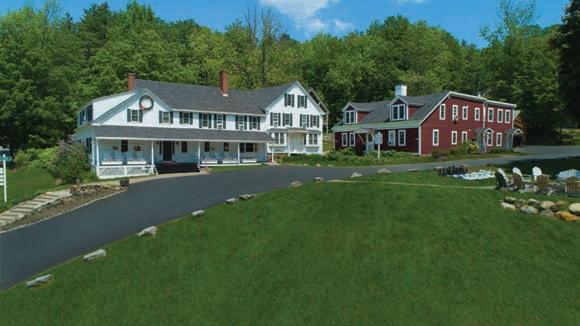
your body and mind at the Aveda Spa, or dine at 3North Restaurant.

An adults-only retreat combining elegance and warmth. Relax at the Aveda Spa, savor ne dining at Forty at Thorn Hill, or unwind with a glass of wine in the intimate Forty Below Wine Lounge.
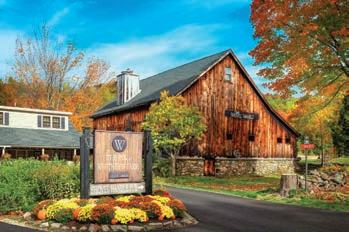
Ideal for families and adventurers, with easy access to Black Mountain’s slopes, hiking trails, paddle boating, and rustic fare at the Shovel Handle Pub.







to sell maple syrup for a living.
I should mention that right now it’s mid-February, and we are standing in the Maple Station Market, a handsome building on Route 101 in Temple that opened in December 2023. It houses Fisk’s sugaring operation, Ben’s Sugar Shack, along with a bustling country store and deli that keeps the maple theme front and center. He bought the original 15-acre property when he was in his mid-20s, but then it took years to get to this point.
Fisk boiled this morning and made 330 gallons of syrup; he’ll boil again later this afternoon and probably make another 330 gallons. He’s got sugarbushes scattered over five different towns, over 28,000 taps, all within an hour’s drive; blue tubing snakes through the surrounding woods like rugged spider webs, delivering precious drops to collection tanks. There are five guys working the woods in November, checking the lines and
doing maintenance, and they start tapping the day after Christmas. It is literally his dream come true.
The waxing light of February feels like a New England miracle when it finally comes. By March, it’s incontrovertible, a fact. There are no dog days of winter, but if there were, they might be now, when we’re crawling toward spring. It’s all about the light, and change, and sap is a gravity-defying proof of this metamorphosis. Syrup feels like boiled light. We may be able to explain it scientifically, but it’s still one of earth’s happy mysteries. Why does it taste so good?
In the end, Fisk tells me, it’s about weather. If the 10-day forecast stays like this for the rest of the month, it will be a terrible season, he says. You have to have nights below freezing and days around 40 to 50 degrees. If all goes well, it’ll take 40 to 60 gallons of sap to make one gallon of syrup—that’s according to the signs handily posted
along Fisk’s popular maple tours. A tree can produce more than a gallon of sap a day, there’s another tidbit. Ben Fisk knows as much as anyone about this ebb and flow.
He tells me he’s excited every day when he gets up. Sure, maple syrup may be the stuff of kids’ dreams, but it’s more than that, too. In the end, for him, it’s about being out in the woods.
“You’re out there by yourself listening to the birds and the trees, looking at different things. The earth always grows in different ways. And you’re trying to figure out how to bring the sap out of the tree, this tiny drop of maple sap.”
It’s a unique job, he admits. The tree produces this one drop. And then Ben Fisk brings it home. bensmaplesyrup.com


















Step back in time with a visit to Plymouth, Massachusetts. The past comes to life in this coastal community, where beautifully preserved historical homes tell the story of America’s settlers. Learn about architecture, art, period design and the people who lived here. Whether you’re a history enthusiast or a curious traveler, unexpected stories await you.
Discover the Secrets of the Massachusetts South Shore.


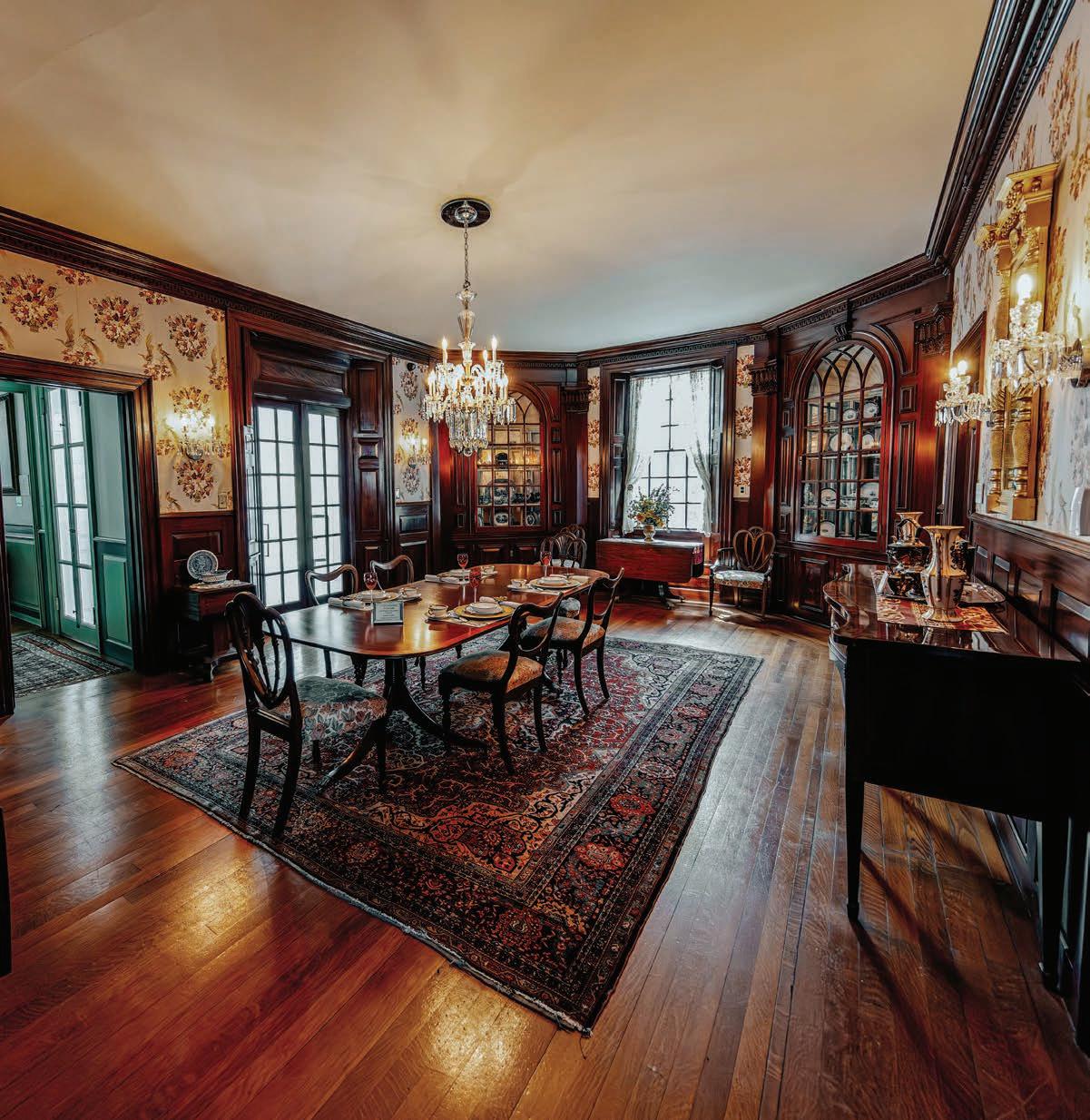




















Park’s eye-catching reminder of Ted Williams’s record-setting home run.



actually touch a ball.
s a lifelong Boston sports fan, I’ve sat in my share of unforgettable stadium seats. Fenway Park’s Field Box 81, Row C, Seat 1—along the oddball juncture of the left-field wall and third-base line—might be my favorite, since it makes me feel I could seat in Boston sports, which is distinguished among Fenway Park’s forest of green bleacher seats by its flash of Red Sox red. Located 502 feet from home plate, the “Ted Wil-
But I’ve never sat in the of feet liams seat”—Section 42, Row 37, Seat 21—was painted red in 1984 to memorialize the mighty bomb that Williams launched on June 9, 1946, still the longest home run at Fenway.

We don’t have to guess where that first-inning homer landed, because it thunked off the noggin of ticket holder Joseph Boucher. published a photo the next day showing the hole the ball had made in Boucher’s fine straw boater, and quoted the exasperated Fenway first-timer saying, “How far away must one sit to be safe in


He’s not alone in thinking that. Some are skeptical that Williams’s travel 502 feet, and even Red Sox home run bashers like Mo Vaughn and Big Papi have expressed doubt. (It’s said that Big Papi tried to hit the seat in batting practice using an aluminum bat—to

The Boston Globe ball this park?”

Today, many fans make pilgrimages to the Ted Williams seat, both with tickets and without. My friend John, a season ticket holder with seats elsewhere in the park, went through the turnstiles extra-early one game to sit in the fabled chair. His first thought, he says, was, the hell did he hit it this far?!



How ball actually did aluminum no avail.)

Last year an MLB stats analyst named Mike Petriello published an exhaustive report that evaluated launch angles, exit velocity, and jet stream behavior before and after the Fenway Park redesign. In 1946, winds of 20-plus mph were blowing to right field. His judgment? Not only was the distance possible, but Teddy Ballgame probably hit it even
farther. —Todd Balf




How a 19th-century masonry technique from Scotland created a treasure trove of rare buildings in Vermont.
BY BRUCE IRVING
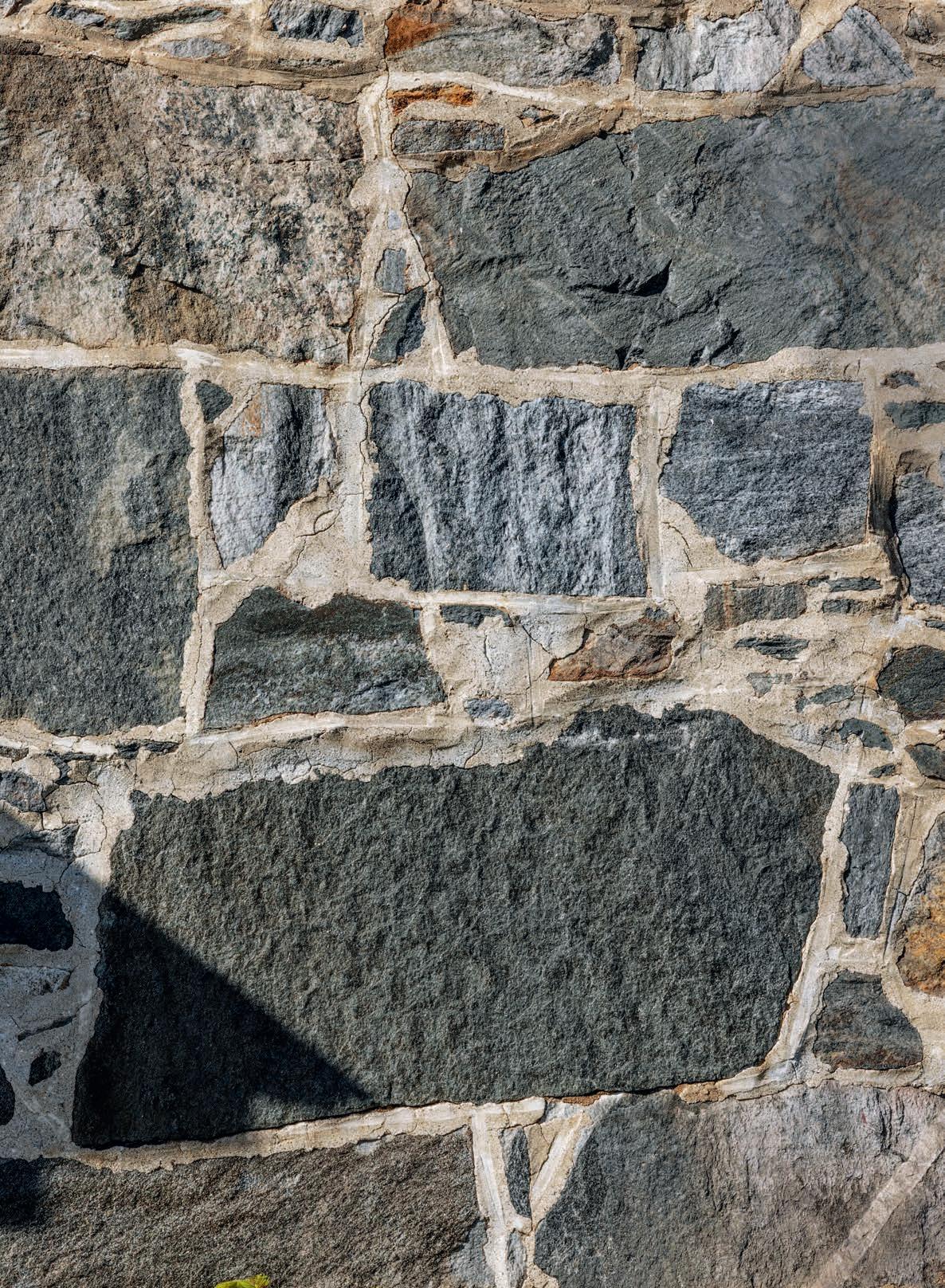
An exterior detail of the Stone Church, officially known as the First Universalist Parish of Chester, Vermont. Built in 1845, it shows how masons fit together irregularly shaped stones with the help of smaller pieces called “snecks.”

hen it comes to building houses, you don’t have to be a little pig or a big wolf to know that wood beats straw and brick beats wood. But for the lucky folks of Chester, Vermont, there’s something even better than brick: stone. The town is home to a unique collection of snecked ashlar buildings, whose aesthetic qualities elevate them beyond simply being well-built and strong and into the realm of folk art. Composing the Stone Village Historic District, 10 of them line Route 103, known locally as North Street, with another 40 or more scattered throughout the surrounding area of south-central Vermont.
First, some definitions. “Ashlar” is cut and dressed stone, and it makes sense that the word comes down from the medieval Latin arsella , meaning a little board or shingle, since ashlar
stones are usually laid up in horizontal bands. “Snecked” is a bit funkier, if Scottish dialect can bring the funk. In Scotland, a sneck is a latch or small bolt used to secure a door. In a snecked ashlar wall, relatively thin stones of different sizes make up the exterior surface pattern. The smallest ones—the snecks—serve both to fill in the gaps left by the bigger ones and, crucially, to penetrate through to an interior rubble wall, not unlike a series of bolts, acting the way metal ties do in a modern brick veneer wall.
But what, pray tell, is a Scottish word doing in Vermont? Like so many American things, the word and the building technique it describes came in thanks to immigration. Snecked ashlar construction is common in Scotland and the border lands with England, where tough weather and a relative lack of trees make it a natural choice. Scottish masons first arrived in Canada in the early 1800s, bringing their skills to bear on forts and canals, where
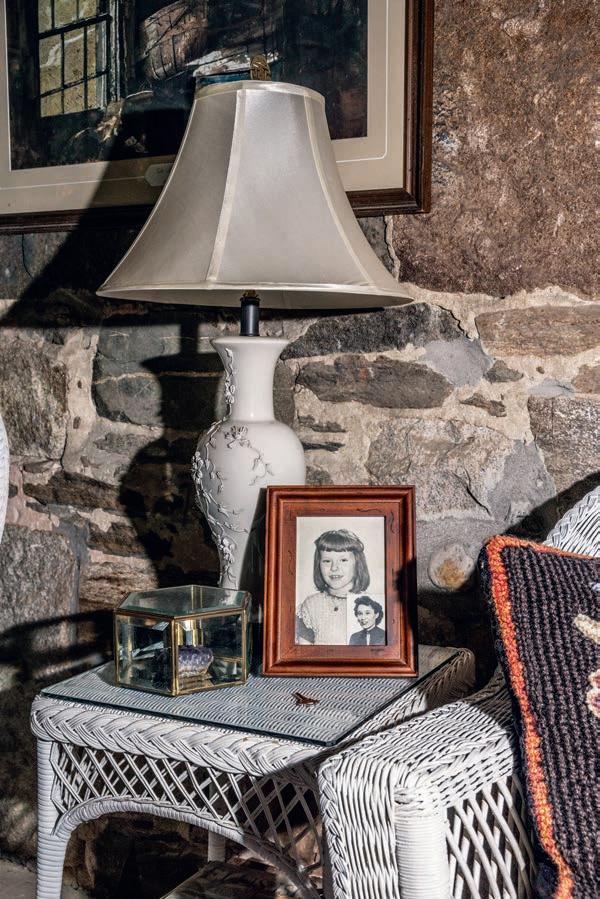
ABOVE LEFT: Possibly the most unusual Stone Village home is the converted one-room schoolhouse where Joanne and Mike Young reside. Joanne actually attended the school in the 1950s, and the frame on this side table displays portraits of both a young Joanne and her teacher, Idamae Laitinen.
ABOVE RIGHT: As a child, Joanne always dreamed of ringing the schoolhouse bell—and today she can ring it whenever she likes.
stone outdid wood. In the early 1830s, some of them were hired to build a large stone factory in Cavendish, Vermont, just north of Chester.
Word must have spread quickly, because in 1834, Dr. Ptolemy Edson, a forward-minded leading figure in Chester, hired local brothers Addison and Wiley Clark to build him a Federal-style home using the new (to the Vermonters) technique. The brothers, part of a family with Scottish roots that had been in Vermont since the 1700s, likely learned snecked ashlar construction from their overseas kinsmen, possibly even on the Cavendish job. It’s been said that Edson paid each of his masons $5 a week, along with a gallon of good rum.
It’s not known whether Edson was taken by the technique’s novelty, its looks, its snugness
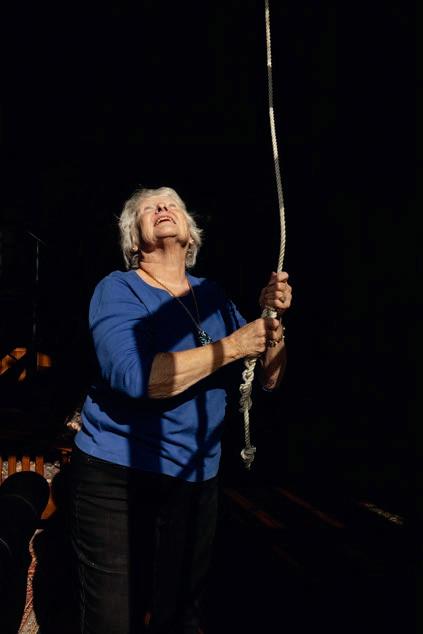
against the huff-and-puff of Vermont winters, or something else, but he became a snecked ashlar booster to his neighbors. Addison and Wiley Clark—joined by a third brother, Orrison, as well as Arvin Earle and other colleagues—built stone buildings at about a one-ayear clip for the next decade, lining a half-mile stretch of North Street with Federal and Greek Revival residences, a one-room schoolhouse, and the village’s centerpiece, the First Universalist Church of 1845, which seats 300.
The Clarks surely must have appreciated the economic advantage of a building material that was literally underfoot and more or less free for the taking. Nearby Mount Flamstead, where they lived, is rich with gneiss and schist, metamorphic stone that splits relatively easily into angular pieces, better for facing a building than for wall-building. They and their farmer neighbors took it from the surface or from shallow quarries, harvesting it off-season and transporting it over the snow by sled in preparation for the summer construction season.
Modern renditions of snecked masonry adhere to a strict protocol using three sizes of stone. The Scottish master stonemason Bobby Watt describes them as “jumpers” or “risers”



you expect and so much more. 17 inspiring showrooms in New England With thousands of products from Kohler, House of Rohl, BainUltra and many other world-class brands, our showroom associates will help you find the perfect selections for your home.



Another view of the First Universalist Parish of Chester. Originally, the first floor was used for worship, while the basement held the town offices. (It’s been noted that church and state were kept separate thanks to the lack of an interior staircase joining the two levels.) Along with the rest of the buildings in the Stone Village, the church was added to the National Register of Historic Places in 1974.
(square, or almost square, or up to three times as long as they are high); “levelers” (usually at least twice as long and up to five times as long as they are high); and “snecks”(smaller pieces that enable the mason to make up the differential in height between the top surfaces of the levelers and the risers). Laid up horizontally, the different-height stones key the rows together to make a strong wall.
The work of the Clarks and their friends is far looser and free—and sometimes downright exuberant, with huge risers surrounded by a bevy of attendant levelers and snecks, a pair of triangular stones kissing to form a vertical bow tie, and parallelogram levelers interlocking in a line. Everywhere is the interplay of the stones’ color and texture, with glimmers of mica across every facade. You can almost hear the delight of the crew as they grabbed the perfect next stone from the various piles they’d assembled. (Maybe the rum helped.)
Holding it all together was the mortar, apparently a secret recipe. Some reports have
it containing moss; others describe slaking the lime slowly over fires of green wood. Whatever the trick, it worked, as most is still sticking strong after nearly two centuries. When the exterior walls were complete, carpenters moved in to hang timber joists from wall pockets in the interior. Walls were furred out, providing some insulative air space, and lath and plaster made for smoothly finished rooms befitting a prosperous town such as Chester.
Like ardent art enthusiasts, today’s residents cherish and celebrate their pieces of folk sculpture. Nicholas Boke, former minister of the First Universalist Parish, happily shows the spot in the side pews where a farmhand used to lean his freshly bear-greased head against the stone wall. A square piece of wallpaper would be put up to cover the stain, only to be quickly soaked through. It took a full renovation to conquer the problem.
In 2019, Joanne Young and her husband, Mike, moved into the belfried schoolhouse at 186 North Street that she had attended back in the 1950s, converted to a home by a previous owner and complete with the 48-star flag she pledged allegiance to as a first-grader. Just across the street, at 189, Polly and Ian Montgomery have restored the Gideon Lee House into a five-star Airbnb outfitted with solar panels and Tesla batteries.
And at 146 North Street, Jon Clark, president of the Chester Historical Society, shows off the room where the original owner once sold sheepskin boots and moccasins he made on-site, his sheep on the hillside behind the house. The 14-stone arch over the front door commemorates Vermont’s place in the Union.
“I love the Stone Village,” Clark says. “And my next project is to finally figure out if I’m related to the guys who built it.”
Exploring on foot: Walking-tour brochures created by Chester Townscape, a committee of the Chester Community Alliance, can be found at many locations around town as well as by going to: chestervt.gov
Staying overnight: The writer and the photographer for this story each stayed in a historic stone building in Chester: the Gideon Lee House and the Cairn of Vermont cottage, both of which can be found at airbnb.com.






In the home or in the garden, the whimsical creations of D. Lasser Ceramics lend a jolt of color.
BY BILL SCHELLER
BAmong D. Lasser Ceramics’ newest offerings are these “baby bowls,” sized a bit smaller and taller than dinner bowls and offered in all 48 of Lasser’s vibrant glaze patterns.

lues like the deep sea, greens like the shallows. Dinner plates done in explosively imaginative designs you’d almost hate to hide with food. Vases prettier than the flowers they’re made for.
The pottery at D. Lasser Ceramics in Londonderry, Vermont, ranges from functional to purely decorative, from a full line of tableware to outdoor sculptural ceramics and even glazed garden orbs that make glass glazing balls look staid and old-fashioned. And through it all, color with a generous dollop of whimsy reigns.

“My personality is playful,” says founder Daniel Lasser, “and my personality is all over these things. You’re going to get a playful product.”
Every piece sold at D. Lasser Ceramics is made on the premises. The showroom fronts a workspace dominated by two enormous kilns, one for firing and the other for glazing, and displays of finished work spill out across the lawns. Situated on a gently rolling hillside, it’s an impossible place to miss on a drive along Route 100.
It’s surprising to learn that Lasser, 63, has been making ceramics for more than 50 years—but he got a grade school start. “When I was 11, an art teacher brought in a wheel one day so the class could try it out,” he recalls. “I never looked back. From then on, I knew just what I wanted to be.” He’s proud to show two cups he made back when he was that boy, and both look as if they’d find buyers in no time at all.
Lasser studied ceramics at Alfred University, home of the New York State College of Ceramics, and he went into the business soon after graduating. Although he’s a veteran of the trade show circuit and formerly sold at several outlets, he’s sold his work exclusively at the Londonderry location and via his own website for the past 20 years. “I used to make things with a commercial purpose, repeating designs that were geared to sales,” he says. “But I wasn’t really in it; it was just copying. I went back to being myself.”
For Lasser, that means being focused on all the possibilities of color and on the pigments that potters use to achieve them. “My work is defined by an exploration with color,” he says. “It’s all about the chemistry, exploring what the colors can do. It’s like playing in your backyard—with a purpose.”
D. Lasser Ceramics isn’t a oneman shop. “There are usually four or five [artisans] working here, sometimes more,” he explains, “but they’re not necessarily trained in ceramics.” Lasser does the training, and all of the

shop’s artisans work from his designs and color schemes.
The shop’s bestsellers are mugs and dinnerware. Pottery meant for outdoors might be second, including purpose-made large sculptural pieces—maybe even a fountain—sure to add a vibrant touch to patios or garden borders and backdrops. Decorative platters 24 inches across, too large for any but a baronial dining room, are perfect for wall mounting in a sunroom or along a piazza.
Lasser’s customers are as playful as he is. “People mix and match,” he says. “We seldom see them buying whole
ABOVE LEFT: Almost any day of the week at D. Lasser Ceramics, visitors can see founder Daniel Lasser busy at his wheel. While he creates his collection with a team of artisans, it’s still his hand that shapes most of the larger pieces.
ABOVE RIGHT: Lasser’s showroom extends outdoors to include displays of dramatic garden accents such as these pedestal planters in Sand Dollar, Blue Moon, Ocean, and Teal glaze patterns.

dinner sets with each place setting in the same pattern and colors—they buy different patterns, in different colors, and mix them up.” It’s easy to imagine a Lasser-enhanced dinner party, with guests taking seats where the table settings most intrigue them.
It’s just as easy to suppose there are households bursting with enough Lasser ceramics to host dinners for dozens. “We meet people in the shop who tell us they’ve been buying our work for years,” Lasser says. “We’ve been here long enough that by now we have second-generation customers.”
On any given Saturday or Sunday
at D. Lasser Ceramics, the number of browsers and buyers usually runs to a hundred or more. And if they miss the weekend, there’s almost every other day in the year: The business closes on just three holidays—Thanksgiving, Christmas, and Easter, all days when countless feasts might boast a certain special splash of D. Lasser flair.
Looking back on his love affair with clay and color that dates to that day in grade school, Lasser sums up what has mattered most in his career: “My favorite thing here is sitting at the wheel. I’m a potter by nature.” lasserceramics.com
Five more New England artisans to whet pottery lovers’ appetite.
Lucy Fagella | Greenfield, MA
The bucolic surroundings of Fagella’s studio—a popular stop on the Asparagus Valley Pottery Trail, which she helped found—are reflected in her line of mugs, lidded urns, and vases decorated in flowers and leaves that seem to live on the surface of the clay. lucyfagella.com
Salmon Falls Stoneware | Dover, NH
For nearly 40 years, Salmon Falls has been turning out the kinds of classic salt-glazed pieces with hand-drawn patterns that have long been staples of the farmhouse kitchen. At the heart of the collection are ovenware and place settings, but you’ll also find lamps, vases, planters, and even birdbaths. salmonfalls.com
Sheepscot River Pottery | Edgecomb, ME
Sheepscot’s artisans create pottery that could come only from Maine. Lobsters, pine trees, loons, and coastal scenes adorn dinnerware, mugs, and, of course, chowder bowls. Even in non-pictorial pieces, the colors of sea and forest are pure Down East. Satellite locations in Damariscotta and Portland; sheepscotriverpottery.com
Tim Scull Ceramic Studio | Canton, CT
Scull’s work reflects the remarkable variety of glazes and surface textures that traditional wood-fired kilns can produce. A specialty is raku-fired pottery, made using Japanese fastfiring, fast-cooling techniques that create signature crackled glazes. cantonclayworks.com
Pottery Wheel | North Kingstown, RI
Elegantly simple designs and soft, harmonious colors characterize the stoneware by potter Mike Chatterley. His collection honors function as well as form, featuring practical pieces such as casserole dishes, soup crocks, chips-and-dip platters, and a clever corkless salt shaker. Visit by appointment, or shop at the nearby Honey Gallery. potterywheelri.com
In understanding my three-century-old Colonial, I also came to understand a little more about my place in the world today.
BY LEE MCCOLGAN

One summer day my car rolled down a winding road that followed the waves of the Atlantic in the town of Duxbury, on the South Shore of Massachusetts. Tossed stone walls rambled along windswept hills. Behind the walls stood solemn rows of wooden houses, their simple rectangular elevations backlit by the sun. Battered by salt air, weathered shingles had turned from the blond of fresh-cut cedar to a silvery gray, that way that locks of hair change color with time. The jumble of a construction site encroached upon one of the homes, a fine example of early American architecture. In front of it, leaning against a telephone pole, lay a stack of old windows. Beside them, scratched crudely on a torn piece of cardboard, bold black letters proclaimed “FREE.”
The wood from these antique window frames had come from old-growth forests. Tightly clustered together, the trees had grown slowly, competing for water, nutrients, and sunlight. That struggle made the wood dense, less prone to rot than trees that shoot up quickly from clear-cut ground, as in
In 2017, Lee McColgan (RIGHT) left a career in finance to learn how to preserve historic homes and buildings, starting with his own 1702 Colonial in Pembroke, Massachusetts. The home’s original details—such as its painted staircase (LEFT) and seven fireplaces, including this hearth with Georgianstyle paneling (TOP RIGHT)—had been left virtually untouched over the course of its long life.
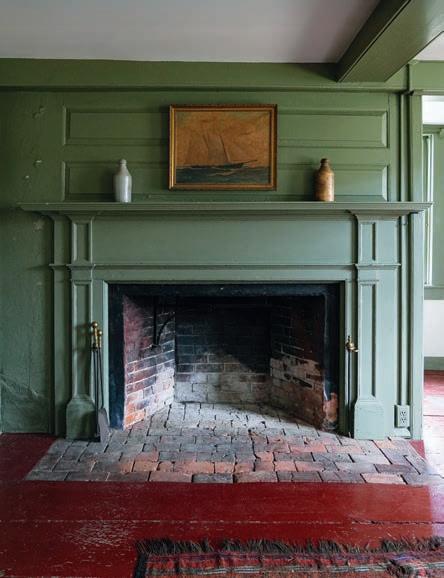
A joiner had planed the profile on the muntin bars, the thin strips of wood that form the grill within the window frame. Sleek and curvy, the plane iron itself mirrored the pattern that it left in its wake. Then the joiner fit the pieces together with mortiseand-tenon joints. Through a long hollow tube, a glassmaker had blown molten silica and spun it on a gaffer’s chair, like a throne, until the glass spread into a large disc. Its finished surface rippled
with tiny grooves like a vinyl record. He cut the disc into small rectangular panes. From powdery chalk dust and cold-pressed linseed oil, a glazier mixed a doughy putty. He sliced a pristine bevel of it around each pane, securing the glass in place.
When properly maintained, these windows lasted for centuries. Knowing all the skilled work that had gone into them made leaving them on the side of the road anathema to me. To abandon them, like so much fly-swarming garbage, felt wrong. I pulled over and loaded them all into my car.
I understood the skills required, could count the hours of labor, because I’d learned to do what those long-gone workmen had done. My own house had taught me. Fortune had brought me into possession of a three-centuryold Colonial that needed restoration. Hewing as closely as possible to 18th-century building techniques had taught me arduous lessons. But within them, hidden like a secret room, lay a deeper lesson. In understanding my
house, I came to understand a little more about my place in the world.
It began with a book. Large and rectangular itself, The Framed Houses of Massachusetts Bay, 1625–1725 by Abbott Lowell Cummings has a bright red cover like that of a children’s storybook. Given to me as a gift, it thoughtfully catalogs a handful of the earliest surviving houses in the Bay State, detailing exteriors and interiors, floor plans and framing. An entire chapter describes the builders and their resources. It immediately drew me in and compelled me to seek out these structures, one by one.
Most of the houses had survived and were operating as museums. My original interest focused on timber framing. As tour guides spoke about generations of occupants, my eyes fixed on the large beams that ran overhead, studying, analyzing, piecing together how the craftsmen had fashioned and assembled them. Months of poking around these ancient treasures convinced me that I wanted one of my own.
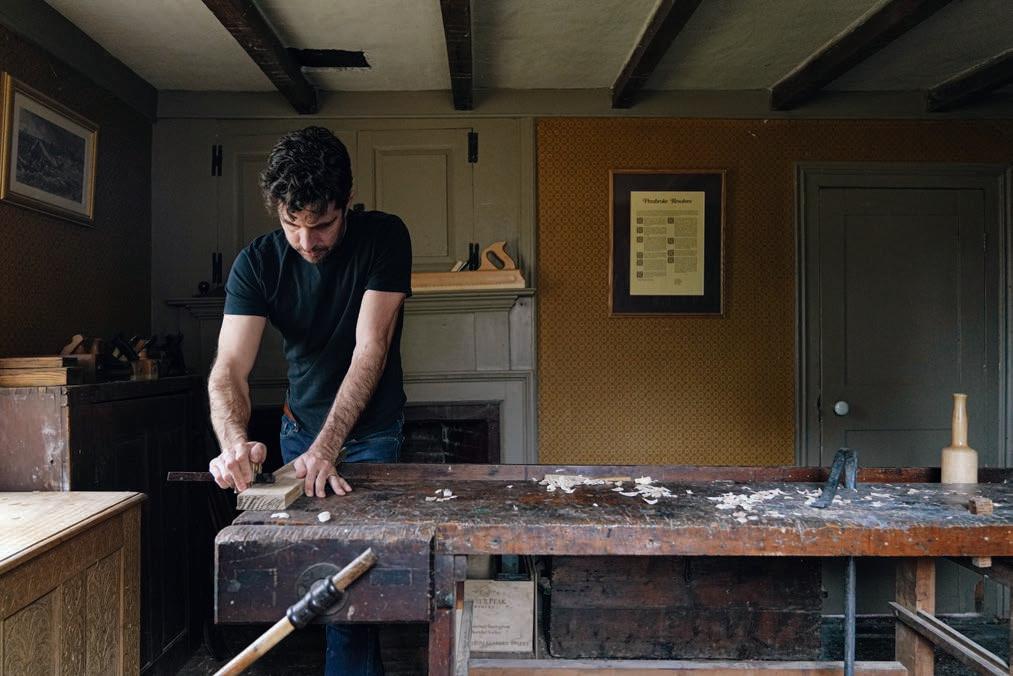
In 2017, real estate listings led me to the Loring House. Built in 1702 in what would become Pembroke, Massachusetts, it stood frozen in time. Most Colonials on the market have endured numerous remodeling jobs over the centuries, but not the Loring House. It felt like digging up a house-size time capsule buried deep in the earth.
The house clearly needed work, though, and I needed to figure out how to do it. In my research, an account of an 18th-century master builder named Richard Macy that I’d stumbled across in Nathaniel Philbrick’s book Away Off Shore provided my path. A passage in the book recounts Macy’s grandson writing: His practice was to bargain, to build a house, and finish it in every part, and find the materials. The boards and bricks he bought. The stones he collected on the common land, if they were rocks he would split them. The lime he made by burning shells. The timber he cut here on island. The latter part of his building, when timber was not so easily procured of the right dimensions, he went off-island and felled the trees and hewed the timber to the proper dimensions. The principal part of the frames were of large oak timber, some of which may be seen at the present day. The iron work, the nails excepted, he generally wrought with his own hands. Thus being prepared, he built the house mostly himself.
Builders—some skilled, some unskilled, some free, some indentured—lived hard lives. They toiled, raised families, and died in comparative obscurity, most now forgotten. But the simplicity of what they did appealed to me. A dozen basic hand tools could do most of the work. Richard Macy captured my imagination, and the decision came almost immediately: Following in those footsteps, I would restore the Loring House myself using period methods and materials. How hard could it be?
Like a mad scientist, I found out. I stumbled through acquiring tools and sourcing supplies. I tracked down living builders using traditional techniques

to learn the tricks of their trades. I performed my own sometimes demented experiments with the materials to encourage them to yield to my demands. Through it all, house museums continued guiding the way. The more I learned, the more those relics revealed. After a summer working with a traditional plasterer, I saw anew the rich textures and details of walls and ceilings. In sections abutting wood or brickwork, where the plaster was crumbling, tufts of fur sprang from the chalky white material like coastal sea grass.
Blacksmiths had forged the iron hardware of latches, hinges, and door handles, heating them until they glowed orange and bent to their will like clay. Hammer blows flattened and fanned the metal into simple shapes—circles, triangles, rectangles, spades—that they finished with delicate file work. Where they had welded two pieces together, subtle lines called “peen marks” remained evident.
Swinging too close to the ground, my broadax once caught a small rock, nicking the blade. As it sliced through
the fibrous cellulose of new wood, that nick left a small track in its wake, a tiny arch like a rainbow. The old wood in some of the house museums revealed similar marks. “That carpenter’s ax had a small nick in it,” I announced to no one in particular. Macy deserved far more credit for what he had done.
But as the restoration progressed, a simple question pulled at me. Why did it matter? Saving an old house doesn’t save lives. On a long-enough timeline, I will go, and so will the structure. Finding an answer to that deceptively straightforward question felt like trying to dislodge a splinter from my brain.
Our possessions reflect us. I began to understand what my house said about me. Living in an untouched three-century-old house was not ordinary, and this spoke to my eccentric nature. Working with minimally processed materials—wood, lime, stone, iron, glass, brick—held an allure, too. These materials live in better harmony with the natural world than most modern building supplies, full of petrochemicals and plastics that destroy untouched landscapes and eventually gorge landfills. On my watch, the Loring House would age with grace, but even when it finally crumbles beyond repair, its materials can return to the earth with a calm magnanimity. In its way, the house itself had become an environmentalist, too.
In the meantime, the work grounded me, made me happy. Our relationship, the house’s and mine, became symbiotic. It provided shelter for my family and me, and my efforts kept it standing and functioning as intended. In it, so many of the people in my life had converged. The hardships and triumphs of the restoration eventually made it clear that the work was less about the building itself than about all the people whom it had protected. It always had been. Beneath an old, weathered roof, we told new stories and made new memories to fill our own lives and others’. What better to do with our time than that?














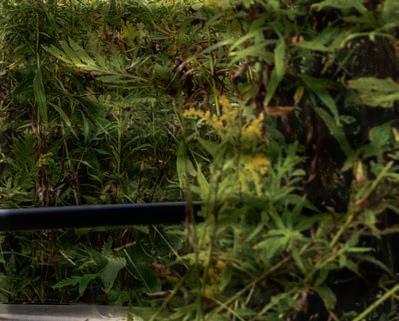










































Our food-forward preview of Weekends with Yankee season 9, premiering on public television stations this spring.
BY AMY TRAVERSO | PHOTOS BY CLARE BARBOZA | STYLING BY GRETCHEN RUDE
n early July, I was rowing a dory in Maine’s Belfast Harbor with Nicolle Littrell just as the bright disk of the sun began to penetrate the upper layers of fog.
As we reached the outer harbor, Nicolle, a Registered Maine Guide who leads excursions through her company DoryWoman Rowing, pulled out a thermos of tea and fluffy biscuits seasoned with finely chopped seaweed. While we snacked, a harbor seal swam over to say hello. If mermaids or selkies were real, that would’ve been my cue to roll overboard and find my pod. Instead, we picked up our oars and made sure the camera crew in the chase boat had gotten enough good shots of the moment that everyone watching Weekends with Yankee, the public television show we produce with WGBH, could enjoy it, too.
The ninth season of the show, which premieres in early April and rolls out over the course of 13 weeks, is full of memorable moments like that one. We comb Connecticut’s coastline with chef and forager Chrissy Tracey as she sources a meal from the small miracles growing all around her. At Newport’s Castle Hill Inn, we enjoy a lobster bake on top of a bluff so gorgeously lit by nature’s golden hour you might think our camera crew used filters. We meet the Old Ladies Against Underwater Garbage, who patrol nearly 1,000 ponds on Cape Cod to clean these beloved waters with humor and spirit. We experience the beauty of a New Hampshire lavender farm in full flower, a cozy afternoon on a Maine houseboat, a bike trip to find the best fried clams on Boston’s North Shore, and a maple farm in Vermont where a “happy” (aka group) of golden retrievers welcomes guests for playtime and snuggles. And we visit Mashpee Wampanoag tribal lands in Massachusetts to cook squash stew in


a traditional hut called a wetu with James Beard Award–winning chef Sherry Pocknett.
It’s our best season yet, and we hope you’ll tune in. In the meantime, here are five recipes that we prepare on the show, along with the stories that inspired them. To find all the recipes from our new season, go to newengland.com/ season-nine-recipes.
After decades spent in restaurant kitchens, Sherry Pocknett came to national
attention when she won the 2023 James Beard Award for the Northeast’s best chef. Her food reflects both Wampanoag and European influences, emphasizing the former, and we were honored to cook with her in the Mashpee, Massachusetts, wetu where her tribe still conducts official business. You can visit her restaurant, Sly Fox Den Too (it’s named after her father, tribal leader Vernon “Sly Fox” Pocknett), in Charlestown, Rhode Island—but until then, here’s a recipe to make at home.
The method Sherry used (“the Wampanoag way,” she called it) was new
to me. By long-simmering the squash until the cooking water was reduced by about half, you end up with a very concentrated squash-enriched base; from there, you incorporate additional flavors. As much as possible, Sherry uses ingredients indigenous to the Northeast, like sunflower oil instead of butter. While shallots are not native to this region, they are far easier to source than wild onions. The cream is optional (but delicious). Note: Sherry uses all kinds of cranberries in this soup—fresh, dried, sweetened, unsweetened. You can choose any type, or go for a combination.

2 large butternut squash, peeled, seeded, and cut into medium chunks
3 tablespoons sunflower oil
2 large shallots
1 teaspoon plus 2 teaspoons kosher salt
1½ teaspoons fresh thyme leaves or chopped fresh sage
²⁄ 3 cup dried or fresh cranberries, sweetened or unsweetened
1 teaspoon freshly ground black pepper
3–4 cups chicken or vegetable stock, or water
3 tablespoons heavy cream (optional)
Sunflower oil, cream, pepitas, and flaky sea salt, for garnish
Put the squash in a large soup pot and cover with water. Set the pot over high heat, cover, and bring to a boil. Remove cover and reduce heat to an active simmer. Continue simmering until the squash is very tender and the water is reduced by half, which will take anywhere from 30 to 45 minutes, depending on the size and shape of your pot.
Want to know where to watch the brand-new season of Weekends with Yankee? Go to weekendswithyankee.com, where you’ll also find full episodes from past seasons and 200-plus snackable segments—many of which are available @yankeemagazine on YouTube, too.
Meanwhile, in a small skillet, heat the sunflower oil over medium heat. Add the shallots and 1 teaspoon salt and sauté, stirring often, until translucent, about 5 minutes. Add the thyme or sage, and sauté briefly.
Roughly mash the cooked squash and add the shallot mixture and cranberries to the pot. Add the remaining 2 teaspoons salt and the pepper, then add 3 cups of the stock or water and stir. Use an immersion or standing blender to puree the mixture until very smooth (if using a standing blender, you’ll need to do this in batches). If the soup is still too thick, add more stock or water until you get the texture you like. Add heavy cream (if using) to taste. Taste and add salt if needed. Serve hot, garnished with a drizzle of sunflower oil and/or cream, some pepitas, and a pinch of flaky sea salt. Yields 8 to 10 servings.
After a morning of rowing in Belfast, I headed to one of the town’s newest and best restaurants: Dos Gatos Gastropub, where tequila and mezcal reign supreme and where the tacos are inspired by co-owner Jesse Soto’s memories of growing up in Texas. Using modern Tex-Mex as a culinary framework, chef Gary Cooper works wonders in dishes like this one: scallop tacos topped with crunchy pico de gallo flavored with cucumber, lime, tomatillo, and cilantro. We recommend using natural or “dry” sea scallops, which

are not treated with phosphates and have a pale tan color. These not only taste better, but also let you achieve that delicious caramelized crust. The recipe also works beautifully with sautéed shrimp and seared salmon.
Note: The chili pepper known as aji amarillo is a foundational ingredient in Peruvian cooking. Look for the jarred puree (as well as the Tajín seasoning) in the Latin American section of your supermarket, or use a chili sauce of your choosing.
FOR THE PICO DE GALLO
2 limes
1 European (seedless) cucumber, finely diced
1 small red onion, finely diced
1 large jalapeño, seeded and finely diced
1 tomatillo, finely diced
¹⁄
3 cup minced cilantro
½ teaspoon ground cumin
1½ teaspoons Tajín seasoning, plus more for sprinkling
Heavy pinch of kosher salt
FOR THE AIOLI
1–2 tablespoons aji amarillo puree
½ cup mayonnaise
FOR THE TACOS
1¼ pounds natural sea scallops
Salt and freshly ground black pepper, to taste
2 tablespoons vegetable oil
12 taco-size corn or flour tortillas
First, make the pico de gallo: Zest and juice one of the limes into a medium bowl. Using a knife and working from top to bottom, carefully cut the peel off of the second lime, then cut the flesh segments out, leaving the membranes behind. Chop the lime segments and add to the bowl. Add the cucumber, onion, jalapeño, tomatillo, cilantro, cumin, and Tajín seasoning. Check flavor, then add salt to taste. Set aside.
Next, make the aioli: Stir the aji amarillo puree into the mayonnaise until evenly combined. Then, make the tacos: Dry the scal-
lops with paper towels, then lightly sprinkle one side with a bit of salt and pepper. Set a medium pan on high heat to warm up, then add the oil and heat until shimmery. Swirl the pan to coat, then place half the scallops into the pan. Cook without moving them until you see the edges turn brown, 2 to 3 minutes. Reduce the heat to low, flip the scallops, and cook until just done at the center, 1 to 2 minutes more. Let the scallops rest on paper towels while you cook the second batch.
To assemble the tacos, slice the cooked scallops in half crosswise. Fill each tortilla with a few scallop slices, then top with pico de gallo, a drizzle of the aioli, and a sprinkle of the Tajín seasoning. Serve warm. Yields 12 tacos.
We spent a sunny day with chef Michael Serpa biking along the coast of Ipswich
(Continued on p. 98)
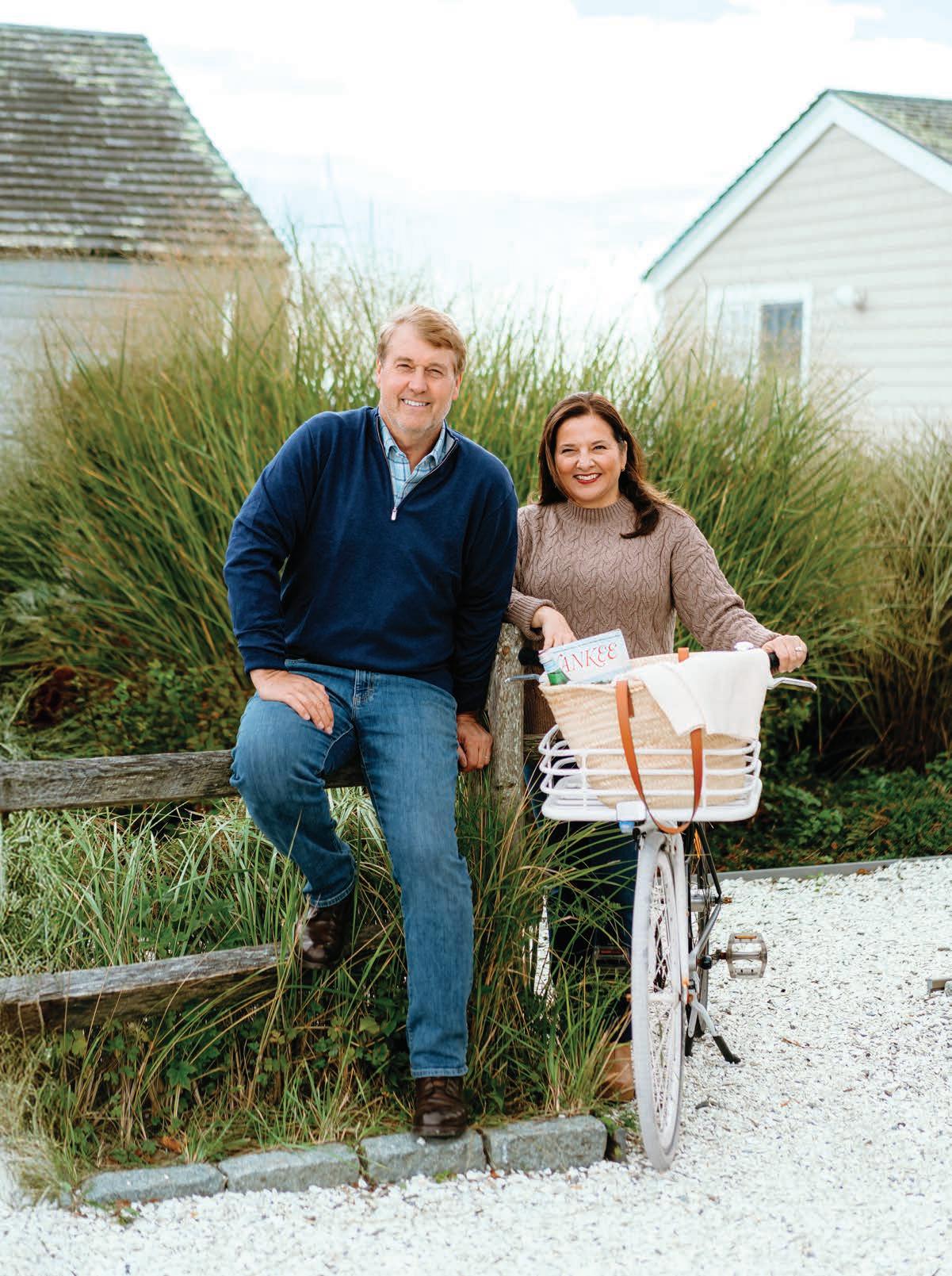


Two recipes that celebrate maple syrup, including one my friends rank among the tastiest things I’ve ever made.
BY AMY TRAVERSO
STYLED AND PHOTOGRAPHED BY LIZ NEILY

n his 1923 poem “Maple,” Robert Frost wrote of “when the maples / stood uniform in buckets, and the steam / of sap and snow rolled off the sugarhouse.” It takes you right there, doesn’t it? I like to think of the maples as uniformed in buckets, a thicket of worker trees in full production mode. Twenty years ago when I lived in New Hampshire, I drove around the bend of Highway 101 one late winter day and was confronted with a sugar shack in full boil, fresh clouds of steam roiling out of the cupola and into the bluebird sky. It still remains my reference point for a perfect March day.
To celebrate the return of this glorious season, here are two recipes. The first is a sweet-savory all-in-one dinner of maple-glazed sweet potatoes stuffed with chorizo and spinach and topped with a dollop of maple-sweetened sour cream. When I served the rustic dish to two friends, each told me separately it was one of their favorite things I’d ever made for them. Take that as your invitation to give it a try.
The second recipe is inspired by our neighbors to the north, the Québécois, who celebrate le temps des sucres with an enthusiasm that puts even New England to shame. Entire families gather around giant picnic tables at sugar shacks and eat multicourse meals of ribsticking fare doused in syrup. If you’ve never visited the region in March or April (or sometimes early May), here’s your invitation to try that, too.
You can use orange, red, or white (Japanese) sweet potatoes here. What’s most important is that they be wide enough to stuff—think of the size being somewhere between a soda can and a one-pint mason jar.
1 tablespoon plus 3 tablespoons olive oil, plus more for the baking sheet
3 large chunky sweet potatoes, sliced in half lengthwise

1 tablespoon plus 3 tablespoons maple syrup (any grade)
1 cup sour cream
1 pound chorizo sausage (pork, chicken, or vegan), removed from casing
10 ounces fresh baby spinach
1 large garlic clove, very thinly sliced
½ teaspoon kosher salt
½ teaspoon freshly ground black pepper
Cilantro and thinly sliced scallions, for garnish
Preheat your oven to 400°F and set a rack to the middle position. Generously grease a large rimmed baking sheet with olive oil. Lay the potatoes cut side down and slide them around in the oil to prevent sticking. Roast until fully cooked and tender when pierced with a sharp knife, 40 to 50 minutes.
Meanwhile, in a small bowl, stir 1 tablespoon maple syrup into the sour cream. Cover and refrigerate.
Next, set a medium skillet over medium heat until hot. Add 1 tablespoon oil, then the chorizo, using a spatula to press it into a large patty. Cook, without stirring, until browned on one side, 3 to 4 minutes. Flip the patty, then use a wooden spoon to break the chorizo into small pieces and continue to cook
until there are no raw pieces left.
In a large skillet over medium heat, warm the remaining 3 tablespoons oil. Add the spinach and garlic, then use tongs to turn the leaves over in bunches until they begin to soften. Add salt and pepper, stir, then reduce heat to low and cover. When the spinach is all wilted, remove it from heat and set aside.
When the potatoes are done roasting, turn them over with tongs. Scoop out just enough of the potato flesh to create a small well in the center of each potato half. Brush each potato generously with the remaining 3 tablespoons maple syrup. Fill the wells with equal portions of spinach and then the chorizo. Top each potato with a dollop of maple sour cream, cilantro, and sliced scallions. Yields 6 servings.
This Depression-era dessert (whose name roughly translates as “poor man’s pudding”) is a type of upside-down cake that yields two layers: one cake, one sauce. The toasted walnuts are optional, but I love how they balance the cake’s sweetness.
1 cup maple syrup (any grade)
1 cup heavy cream
½ teaspoon plus ½ teaspoon kosher salt
²⁄ 3 cup salted butter, softened, plus more for greasing ramekins
¾ cup granulated sugar
2 large eggs, at room temperature
1½ cups (210 grams) all-purpose flour
1½ teaspoons baking powder
1 teaspoon ground cardamom (optional)
½ cup milk
½ cup chopped walnut halves Whipped cream, for garnish
Preheat your oven to 350°F and set a rack to the middle position. Grease 8 ramekins with butter and arrange them on a rimmed baking sheet. Set aside. First, make the sauce: Put the maple syrup, cream, and ½ teaspoon salt in a medium saucepan over medium-high heat. Bring to a boil, then remove from heat. Set aside ⅓ cup sauce in a small bowl. Divide the remaining sauce evenly among the 8 ramekins.
Next, make the dough: Using a stand or handheld mixer, beat the butter and sugar on high speed until fluffy, about 3 minutes, scraping down the sides of the bowl halfway through. Add the eggs, one at a time, beating well and scraping down the bowl after each.
In a medium bowl, whisk together the flour, baking powder, ½ teaspoon salt, and cardamom (if using). Add the dry ingredients to the wet and beat on low speed until blended. Scrape down the sides of the bowl. Add the milk and beat on low until evenly combined.
Divide the dough evenly among the prepared ramekins and transfer the baking sheet to the oven. Spread the chopped walnuts in a single layer on a small baking sheet or pan and put it in the oven. Toast the walnuts until golden brown, about 5 minutes, then remove. Bake the cakes until they are browned on top and puffed in the center, 20 to 25 minutes total. Let cool for 20 minutes. Serve warm with a dollop of whipped cream, a drizzle of the reserved sauce, and a sprinkle of toasted walnuts. Yields 8 servings.




In Central Florida, you hold the keys to unexpected vacation memories.

There’s your luggage, already on the carousel. There’s your rental car, right outside the door. Lakeland Linder International has just two gates, so when you land at Central Florida’s airport—a competitively priced direct flight of about three hours from New Haven or Manchester-Boston thanks to new Avelo routes—you won’t waste precious vacation time getting on your way.
On your way to Tampa or Orlando, perhaps. Both are about an hour’s drive. But that would be
soooo predictable. And you and your beloveds deserve a trip that’s uniquely unforgettable and as easybreezy as jetting to this land of citrus and sunshine and Old Florida allure. Which of these worlds will you explore together on your first visit … and on your next?
A Garden of Musical Enchantment
By March, it’s full-on springtime at Bok Tower Gardens in Lake Wales, as thousands of azaleas and camellias erupt in magentaand-white bloom blasts. On
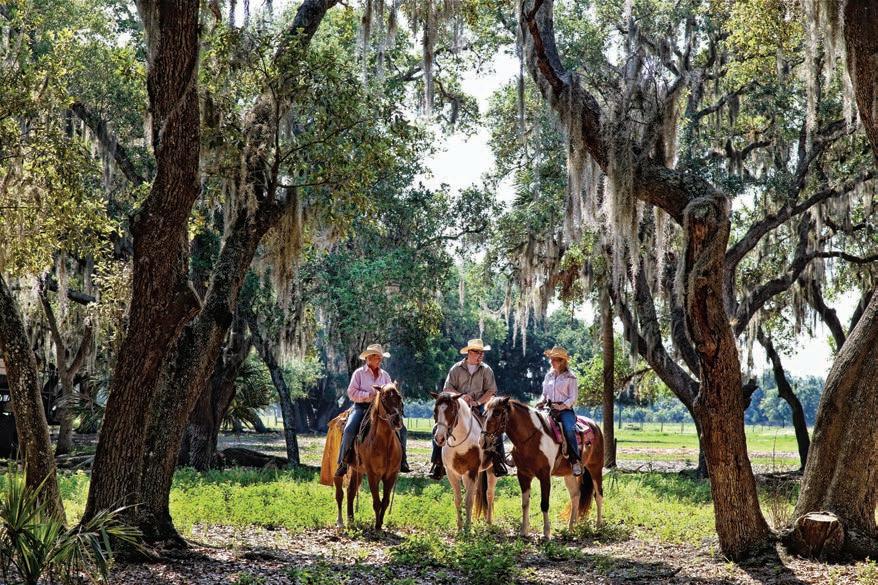

this perpetually colorful hilltop, wildscapes converge with cultivated landscapes in what is considered one of Frederick Law Olmsted Jr.’s supreme achievements. Kids have their own garden, Hammock Hollow, for digging and climbing and learning through play.
Longtime Ladies’ Home Journal editor and world-peace advocate Edward Bok (an interesting guy; you’ll want to read his autobiography) left us this soulsoothing sanctuary, but that’s not

all. Built of pink marble and the seashell rock coquina, and ornately embellished by some of the best artisans alive in 1929, the Singing Tower soars 205 feet above it all. It looks like a castle, but it’s actually an instrument: one of the most impressive carillons in the world. The reverberation of 62 tons of five-octave bells will stop you in your tracks, then pull you toward the tower’s reflecting pool for the listen of your life.
A walking tour of Florida Southern College in Lakeland isn’t just for prospective students. The campus is home to the largest collection of Frank Lloyd Wright–designed buildings in the world. Usonian House, designed in 1939 but built in 2013, is a model of the famed architect’s vision for minimalist living. A dozen other midcentury buildings, which still appear futuristic, are very much in use. You’ll be shaded by Wright’s mileplus-long Esplanade as you hear about his organic inspiration and the unique construction methods he employed. Danforth Chapel, with its Wright-designed stained glass, is a photogenic highlight. You might be accompanied on your walk by one of 36 campus
cats, although only two, Dexter and Gilbert, are super friendly.
A Genuine Dude Ranch
They’re not herding cats at Westgate River Ranch, an authentic, Western-themed resort that’s the largest of its kind east of the Mississippi. So pack your faded jeans and cowboy boots (you can buy a wide-brimmed hat at the general store), and fill your days with horseback and mechanicalbull rides, archery, fishing, hearty meals, and a few thrills you won’t find in Montana like loud-and-fast and totally exhilarating airboat tours. Gator sightings are routine. You don’t have to stay or “glamp” here to attend Saturday-night rodeos with their intoxicating blend of wild action and Americana pageantry you can only experience when bull riders and barrel racers give it their all.
A LEGO Lover’s Dream (with a Dash of Peppa)
Discover several worlds wrapped up in one at LEGOLAND Florida Resort in Winter Haven. Leave it to LEGO to engineer an attraction that’s sized just right and keeps everyone—little kids to grandfolks— smiling. For wee ones, the world’s first Peppa Pig Theme Park is the perfect introduction to amusement rides, shows, character photo ops, and simple pleasures like tricycling around a track. LEGOLAND offers 50 more rides and experiences like MINILAND USA with its detailed cityscapes, plus a water park for warm days. You’ll marvel at life-size (and larger!) creations. Sit behind the wheel of a red-brick LEGO Ferrari, then build and test your own race car.
Save time for a nostalgic stroll through the botanical wonders of Cypress Gardens, Florida’s original tourist attraction, or see them from the water with local guide
Rue Denton’s The Living Water Boat Cruises. Two hotels with LEGO activities galore, including in-room treasure hunts and exclusive workshops, are a few blocks from all the fun.
Swan City
Don’t overlook downtown Lakeland when you crave an elevated escape. The largest city in a county that’s a bit bigger than Rhode Island is nicknamed for its myriad swans, all descended from a mated pair gifted by Queen Elizabeth II. The century-old Terrace Hotel is the grande dame here, and it’s steps from shopping, events in Munn Park, Revival’s sophisticated cocktails, and a superb brunch at Nineteen61 (the pastelitos will spoil you for any other guava pastries). The stress-free airport’s less than 20 minutes away, so linger and squeeze every drop of juice out of your time away.
Begin planning your Central Florida vacation at




New England’s second-largest city marries a legacy of invention to a thoroughly modern mix of art, culture, and dining.
BY ANNIE SHERMAN | PHOTOS BY LINDA CAMPOS



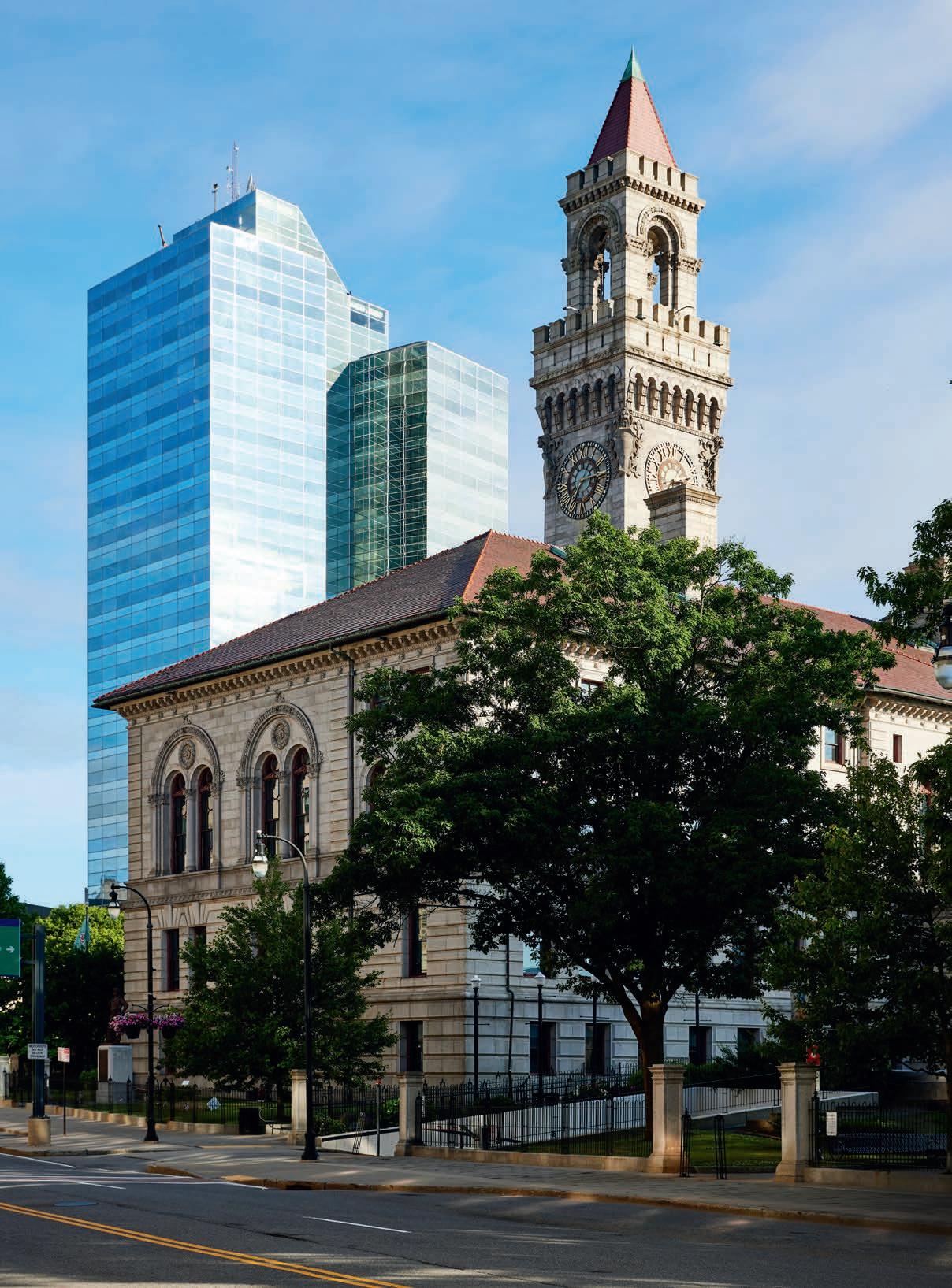
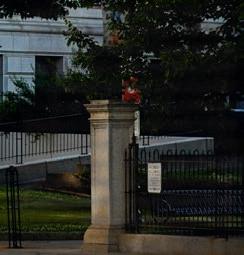

Did you know that the monkey wrench was born in Worcester, Massachusetts? The first Valentine’s Day card, too. The birth control pill, the space suit, the liquid-fuel rocket—yup, all invented in the Woo. Even modern-day emojis can be traced back to this city, with the creation of the smiley face in 1963 for an insurance company’s marketing campaign. ¶ Worcester rose to fame as a 19th-century manufacturing epicenter, which when paired with its diverse, modern identity may spark a “Wait, Worcester has that?” moment—especially if you’ve only driven through on your way somewhere else or parachuted in for a concert at the DCU Center. But Worcester’s legacy of invention brought with it a surprisingly contemporary joie de vivre that has endured as the city’s character evolved over the decades.

Sitting almost smack-dab between Boston and Springfield, Massachusetts, the second largest city in New England boasts a population of more than 205,000, including academics and students coming from around the world to the eight colleges and universities here. Its Union Station, a stunning transportation hub built in 1911, affords easy access, too, with Amtrak, MBTA commuter rail, and city and regional bus service.
As with many New England manufacturing towns, Worcester saw its share of hard times when the industrial revolution met the Great Depression. But what drew folks to the city in the first place created a melting pot of diverse food, art, culture, and music that still percolates today. So much so that stories of laborers and craftspeople seem to ooze as much from historic stone structures in the city’s central business district as they do from its more modern Canal District or verdant green spaces that dot the City of Seven Hills’ outskirts.
Even the “Wormtown” nickname reflects this cocktail of identities. Flash back to 1978, amid the neon haze of the pseudo-underground
LEFT: A sampling of the 40-plus small plates to be had at Bocado Tapas Wine Bar.
OPPOSITE: Among the Canal District’s eclectic retail offerings is Seed to Stem, a boutique filled with wow-worthy plants and one-of-akind home decor.

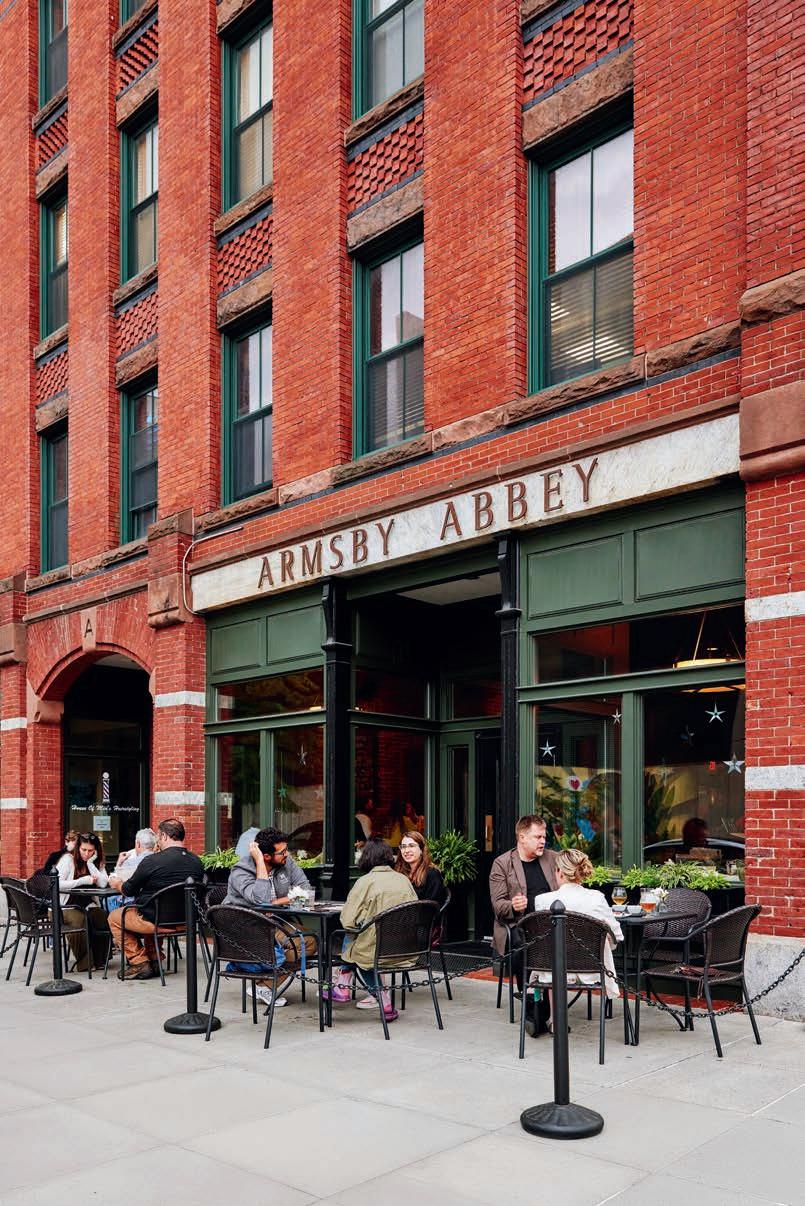
the scene needed a little love, so he published a handwritten one-sheet fanzine whose title, “Wormtown Punk Punk Press,” derived from his own moniker. After other businesses and events adopted the name, too, “Wormtown” stuck.
Perhaps only in Worcester would the origins of such an irreverent-turned-affectionate nickname be remembered in a museum. The Museum of Worcester, which recently celebrated its 150th anniversary, has a library archive of written material that tells the tale (research buffs should call ahead, though, to ensure it’s available for viewing). Meanwhile, at the Worcester Art Museum just down the street, visitors can walk through part of a 12thcentury Benedictine priory as well as 2,000 years of global history in one afternoon.
It seems like everything here is “just down the street,” because Worcester is such a blissfully walkable and approachable city. At the restaurant Deadhorse Hill, solo diners bump elbows with their neighbors while relishing a glass of natural wine and perhaps some local pork chops with spring ramps that chef
Sidewalk seating adds people-watching to the lures at Armsby Abbey, a gastropub that’s become widely known for its farm-totable fare and stellar lineup of craft beers since opening on Main Street in 2008.
Jared Forman harvested just the day before. A transplant to Worcester, Forman describes his adopted city as having a large-town feeling in a small space, where strangers can become friends in a New York minute.
Nowhere is this amalgamation of cultures, centuries, and attitudes more evident than in Worcester’s vibrant architecture and public art. Walk in almost any direction from historic City Hall on Main Street and you’ll find soaring edifices of 19th- and 20th-century design, many of which remain open for public appreciation. Take in a tribute to Aretha Franklin at the famed Hanover Theatre, which first opened in 1904, or listen to the Worcester Symphony Orchestra perform a springtime concert of music from American wartime films amid the dreamy acoustics of the 1857 Mechanics Hall.
Outside, multistory murals decorate buildings around the city, offering messages of love and nature and spotlighting the region’s indigenous roots and its Black sports stars, including
Armsby Abbey: The place to go for a pint, weekend brunch, and the city’s best sharing and grazing menu. armsbyabbey.com
Bocado Tapas Wine Bar: Spanish flamenco style rules here, with favorites like paella, grilled octopus, and sugar-dusted churros with chocolate sauce. bocadotapasbar.com
Crust Bakeshop: Look no further for fresh breads, croissants, sandwiches, and the perfect latte to start your day. crustbakeshop.com
Deadhorse Hill: Expect a delicious but everchanging seasonal menu at chef Jared Forman’s hot spot. deadhorsehill.com
Havana Nights: Treat yourself to some mouthwatering chicken mofongo and churrasco skirt steak at this Cuban home-cooking specialist (and look for its spinoff, Little Havana, in Worcester Public Market). havananightsrestaurant andlounge.com
Worcester Public Market: The food and market stalls here take you from Tokyo to New Delhi, while shared tables create a jovial atmosphere. worcester publicmarket.org
Wormtown Brewery: Come for a seasonal Irish Red Ale, stay for the tacos. wormtown brewery.com
STAY
AC Hotel Worcester: Rest and rejuvenate at this contemporary spot that’s conveniently located behind City Hall. marriott.com
Beechwood Hotel: Lovely stained glass windows and vintage




















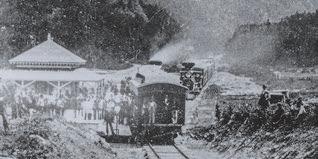
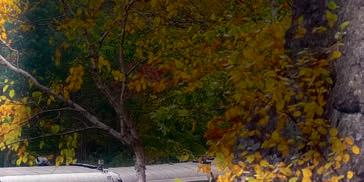







the 1899 world cycling champion Major Taylor. Over the past several year, the Pow! Wow! Worcester mural festival has led to the decoration of the library and the YWCA, public housing, a parking garage, multiple elementary schools, and even centuries-old buildings with large-scale paintings to show that art can be— and should be—representative of the community and for everyone to enjoy.
The spirit of inclusivity here can feel almost like a citywide family-friendliness policy, too. On sunny, warm spring days, Worcesterites flock to the city’s abundant green spaces for a hike up to the Cascades waterfall or to picnic, fly kites, and fish in the wide-openness of Green Hill Park. And from spring through summer, future MLB stars show off their talent at Polar Park as members of the Boston Red Sox’s top farm team, the Worcester Red Sox. What might seem like a collection of cold, gray stone, steel, and brick buildings when you first arrive downtown quickly transforms into a warm and welcoming civic hub, thanks to the people inside those buildings sharing their cultural energy. So next time, rather than driving through it, maybe drive to it—and you’ll be wooed by Worcester, too.
posters lend extra personality to this welcoming, familyowned establishment. beechwoodhotel.com
The Canal District: This charming neighborhood features Worcester Public Market and shops such as Seed to Stem, a gallery of botanicals and home decor; the Crompton Collective, for secondhand goodies; and Bedlam Book Café. thecanaldistrict.com
EcoTarium: Kids can touch everything at this science museum as they explore wind patterns on Mount Washington, discover secrets of the forest, and more. ecotarium.org
Hanover Theatre: Live performances in this stunning historic venue include Broadway shows, the Boston Pops, and Led Zeppelin tribute concerts. hanovertheatre.org
Mechanics Hall: Come experience the finest acoustics in any pre–Civil War building in the country—and don’t miss the iconic portrait gallery in the Great Hall. mechanicshall.org
Museum of Worcester: Featuring rotating exhibits on Worcester inventions and landmarks, with a permanent gallery devoted to the city’s industrial past. worcesterhistory.org
Worcester Art Museum: Discover art and artifacts from across the centuries, including the secondlargest collection of arms and armor in the U.S. worcesterart.org
Worcester Red Sox: Bring the whole family to a game at Polar Park, where seating on the grassy outfield berm is a popular option for youngsters. milb.com/worcester
Share the transformative power of Canyon Ranch with someone you cherish.
BY KIM KNOX BECKIUS
We were first-timers at Canyon Ranch last spring, my daughter and me— satisfying so much more than our curiosity about the Berkshires’ original wellness escape. I was freshly finished with cancer treatment; she’d just graduated from college. We were redefining our relationship. Celebrating our bond. And we’d found the most nurturing environment in which to strengthen mind, body, and connection.
Wellness is personal, sure. And from the moment we signed into the Canyon Ranch app on our phones, we were eagerly anticipating journeys all our own. The breadth of offerings elevates the resort to a league all its own.
Who knew? Guests drive through the gracious estate gates with intentions to

do so much more than spa. Yes, spa is a verb here: treatments are immersive, providers are expert, the menu is extensive. But each hour of a Canyon Ranch day is unlike an hour anywhere else. It’s loaded with options for learning, stretching, selfexamining, and encountering the calmest, best version of yourself. And when you share the experience with a partner, best friend, or loved one, it’s like turning every hour into two because robust relationships are essential to wellbeing. And self-care is selfless when you’re focused on being around for each other for a very long time.
Before and during a stay, guests receive thoughtful personal guidance. It’s

clutch for navigating options that range from nutrition counseling to couples coaching, from sound healing to DEXA body composition scan and analysis, from tarotcard readings to hypnotherapy.
Join Yankee Aboard the Bestie Bus from Boston to Canyon Ranch!
This spring, make time for wellness together with a best friend, loved one, or partner. We’ll leave Boston on May 1 and return May 4: refreshed and ready to live our best New England lives. Visit canyonranch.com/bestie for package details.
Zentangle and mocktail-making workshops were fun to indulge in together. We went our separate ways for workouts, healthy snack breaks, and facial and acupuncture massage services. We reconvened for abundant, all-you-can-savor meals, playfully competing to see how much goodness we could pile on salad-bar plates. Pairing entrees like grilled shrimp and Moroccan beef tagine with fruity, bubbly spritzers. We applauded a Broadwaycaliber live performance. Tried our luck at DJ-pumped Bingo. Melted at yoga class. Lamented we couldn’t fit in pickleball lessons or a kayaking adventure. As I descended the stairs of the Bellefontaine Mansion after my last session of the weekend, I couldn’t wait to see my girl. I wanted to hear all she’d learned on a tour of this Gilded-Age stunner turned sanctuary. Plus, I was bursting to share the optimism and clarity I felt after a one-on-one Longevity Mindset experience. Being at “The Ranch” together doubled the benefits for both of us—what better gift could I give her than practical strategies for long-term mental, emotional, and physical resiliency? And the reassurance I’m committed to implementing them myself.
From cookbooks to cutlery, Groundswell Table + Provisions in Tiverton, Rhode Island, has everything needed for hosting a memorable meal.


These New England shops have everything you need to infuse your living spaces with new life.
BY ELYSE MAJOR
AUGUST & MARCH HOME, Putnam. Flying under the radar even among cities and towns off the main highways, Putnam is a hidden gem of casual eateries, antiques shops, and a museum devoted to Gertrude Chandler Warner, author of The Boxcar Children book series. Right on Main Street is a store that’s shabby-chic-meetsfarmhouse: Think burlap, neutrals, antique china, and basically anything pretty. You might leave with a mirror … or a gourmet chocolate bar. Instagram
G’S COUNTRY BARN, Norwich. Next time
you visit the town nicknamed “The Rose of New England,” set your GPS to Yantic River Plaza. As the name of Alicia Gardner’s store implies, G’s Country Barn specializes in country, farmhouse, and primitive decor. In addition to selling things like signs, it offers patinated lanterns and Amish-made furniture for browsing. G’s also does custom woodworking and often hosts special events. gscountrybarn.com
THE HIDDEN ACORN, Woodbury. Remember when furniture was built to last? That’s the mission of this business tucked along Route 47. The proprietors are Debbie and Andy Smith, a married couple who want
to keep quality stuff out of the trash—so they clean, restore, and research each hardwood piece before tagging it for sale. Want to DIY that curbside find? Hardware and refinishing supplies are available. hiddenacorn.com
OUTDOOR DESIGN & LIVING, Fairfield & Guilford . Last year, the coastal town of Guilford welcomed a charming addition to its town green: the home and garden branch of Fairfield-based Outdoor Design & Living. Between the two locations, Chris Palmer’s business is blooming with home inspiration, supplies, and gifts. And since they’re just 45 minutes from each other, make a day of visiting both. outdoordesign.com
PERGOLA, New Preston. Shops that specialize in a mix of new and antique inventory are nothing new, but at Pergola many of the pickings hail from Japan. Owners David and Peter Whitman make regular shopping trips overseas to source items like Shigaraki pottery, Sugahara glass, and decorative accents from Kyoto. Along with one-ofa-kind treasures, there are design-forward
(Continued
Located along the Southern Maine coastline, our active, engaged community combines worry-free independent living with priority access to higher levels of on-site care—all for a predictable monthly fee.
Residents enjoy apartment, cottage, and estate home living in a community of friends, with all the benefits of Maine’s first and only nonprofit life plan retirement community.

(207) 883-8700 • Toll Free (888) 333-8711 15 Piper Road, Scarborough, ME 04074 • www.pipershores.org


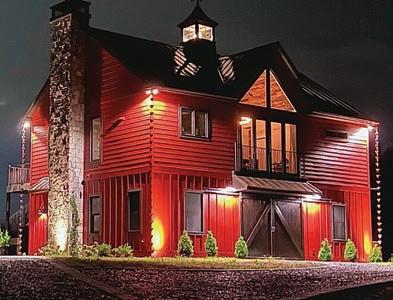
Call to schedule a visit today.




See how one small addition can make a big di erence “ e sky’s e Limit”
See how one small addition can make a big di erence “ e sky’s e Limit”
HOURS: Mon-Fri 8:00AM-4:30PM • Saturday by Appointment
HOURS: Mon-Fri 8:00AM-4:30PM • Saturday by Appointment 78 State Road, Dartmouth, MA • (508) 994-2119 • capecodcupola.com See how one small addition can make a big di erence “ e sky’s e Limit”
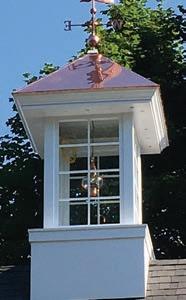
HOURS: Mon-Fri 8:00AM-4:30PM • Saturday by Appointment
HOURS: Mon-Fri 8:00AM-4:30PM • Saturday by Appointment
HOURS: Mon-Fri 8:00AM-4:30PM • Saturday by Appointment
78 State Road, Dartmouth, MA • (508) 994-2119 • capecodcupola.com
HOURS: Mon–Fri 8:00am–4:30pm • Saturday by Appointment
78 State Road, Dartmouth, MA • (508) 994-2119 • capecodcupola.com See how one small addition can make a big di erence
78 State Road, Dartmouth, MA • (508) 994-2119 • capecodcupola.com See how one small addition can make a big di erence
78 State Road, Dartmouth, MA • (508) 994-2119 • capecodcupola.com
78 State Road, Dartmouth, MA • (508) 994-2119 • capecodcupola.com
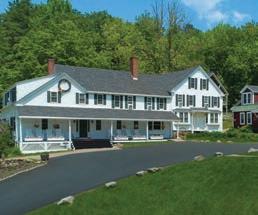

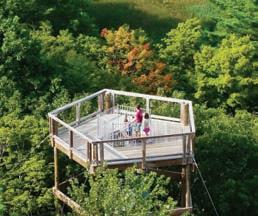
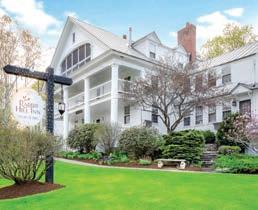
Christmas Farm Inn offers comfortable lodging, traditional New England dining, and a full-service spa as your perfect home base for nearby shopping and adventure. From weddings to couples retreats to family gatherings, maximize your White Mountains experience with us.
603-383-4313 christmasfarminn.com

HARTLAND, VT
The Boston Globe describes Fat Sheep Farm as “a magical place” offering amazing views from modern cabins. Soak in the sunset by the firepit, taste the farm’s bounty, try your hand at milking sheep, or attend a cheese-making or sourdough workshop.
802-436-4696
fatsheepfarmvermont.com
Return to The Wentworth, a charming inn located in the heart of Jackson, NH. Enjoy fine dining in our historic 1869 Dining Room or casual fare at the Alpine Tavern. Explore the breathtaking White Mountain National Forest, right at our doorstep. A timeless resort in the heart of New England.
603-383-9700 thewentworth.com
Visit the VINS Nature Center for an unforgettable experience for all ages. Explore our Forest Canopy Walk, adventure playscape, and scenic trails. Learn about wild birds through our live raptor programs, live bird enclosures, walkthrough songbird aviary, and special events.
802-359-5000 vinsweb.org

Experience the enchanting cottage that inspired Elizabeth Orton Jones’s Little Golden Books version of “Little Red Riding Hood.” Untouched by time, this is a mecca for gardeners, epicureans, and anyone looking for inspiration and relaxation. Have a Pickity day!
603-878-1151 pickityplace.com

When was the last time you touched the soft coat of a baby horse? Experience living history at this National Historic Site and University of Vermont teaching farm. Open MayOct. for guided tours and special events. 74 Battell Drive, Weybridge, VT.
802-388-2011 uvm.edu/cals/morganhorse farm
Nestled in Vermont’s pristine landscape, Rabbit Hill Inn beckons with luxury and charm. Unwind in premier accommodations, savor outstanding cuisine at 24 Carrot, and embrace outdoor adventure yearround. Your retreat awaits amidst mountains, streams, and New England’s tranquility.
802-748-5168 rabbithillinn.com
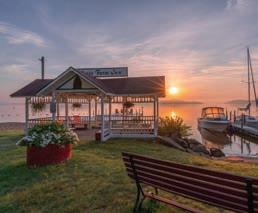
Enjoy a quarter mile of sandy beach and docks on the shores of Lake Winnipesaukee. Lakeside cottages, apartments, and rooms available. Great location for fishing, hiking, kayaking, boating, and more. Family owned and operated since 1890.
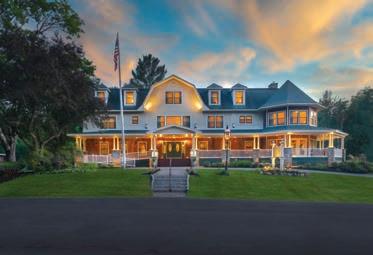
603-293-4321
amesfarminn.com
Reconnect with past Editors’ Choice winners and see for yourself why they received Yankee Magazine’s highest accolade.
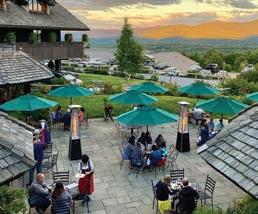
Celebrating 75 years nestled in Vermont’s scenic hills, the newly rebranded von Trapp Family Lodge and Resort blends Austrian charm with modern luxury. Guests enjoy cozy accommodations, outdoor adventures, gourmet dining, and stunning mountain views—all inspired by the legendary von Trapp family heritage.
802-253-5769 vontrappresort.com
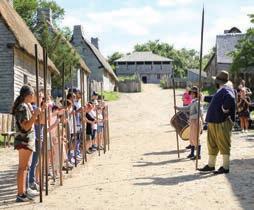
Explore America’s founding story in New England’s oldest town! Plimoth Patuxet Museums (formerly Plimoth Plantation) is a must-see destination, sharing the compelling history of the Indigenous Peoples and Pilgrims who met in 1620 and set into motion the great American Experiment in self-governance.
508-746-1622 plimoth.org

Rediscover luxury lodging at The Inn at Thorn Hill. From couples retreats to weddings, experience personalized accommodations, inspired dining, a private wine cellar, and several spa packages set amidst the majesty of the Presidential Mountain Range in Jackson, New Hampshire.
603-383-4242 InnAtThornHill.com

Nestled in the beautiful green hills of New England, the Bedford Village Inn & Grand is a four-diamond property that perfectly blends historical character with a luxury boutique ambiance. Its 64 gorgeously designed rooms retain the rustic charm of days gone by, while simultaneously offering everyday modern comfort and amenities.
800-852-1166
bedfordvillageinn.com

This beautiful family- and dog-friendly Inn, centrally located in the picturesque Lakes Region at the foothills of the White Mountains, offers the ultimate New England escape. Enjoy a delicious cooked-to-order breakfast, kayak, paddleboard, and swim at a nearby private beach, then unwind with s’mores by the campfire. Elopement services available.
603-968-7269 innongoldenpond.com

Sprawling across two floors and 7,000 sq ft, get lost in centuries past. It’s packed with vintage furniture ranging from colonial through Victorian, porcelain and silver tableware, heirloom jewelry, and restoration hardware. Our natural history collection includes geodes bursting with color.
802-732-8081 windhamantiquecenter vermont.com

Spanning 700 acres, this resort offers activities for everyone, from horseback riding to clay bird shooting and boat rides. With luxurious accommodations, an on-site spa and salon, and exquisite dining, it’s the perfect getaway destination. A short drive from home— made to feel like a world away.
802-483-2311
mountaintopinn.com

NORTH CONWAY, NH
New Hampshire’s Conway Scenic Railroad celebrates 150 years of rail operation over Crawford Notch! Between May and November enjoy a four-hour journey through the Mount Washington Valley aboard the Mountaineer, featuring classic 1950s streamlined railcars. Premium dome seats available.
603-356-5251
conwayscenic.com
















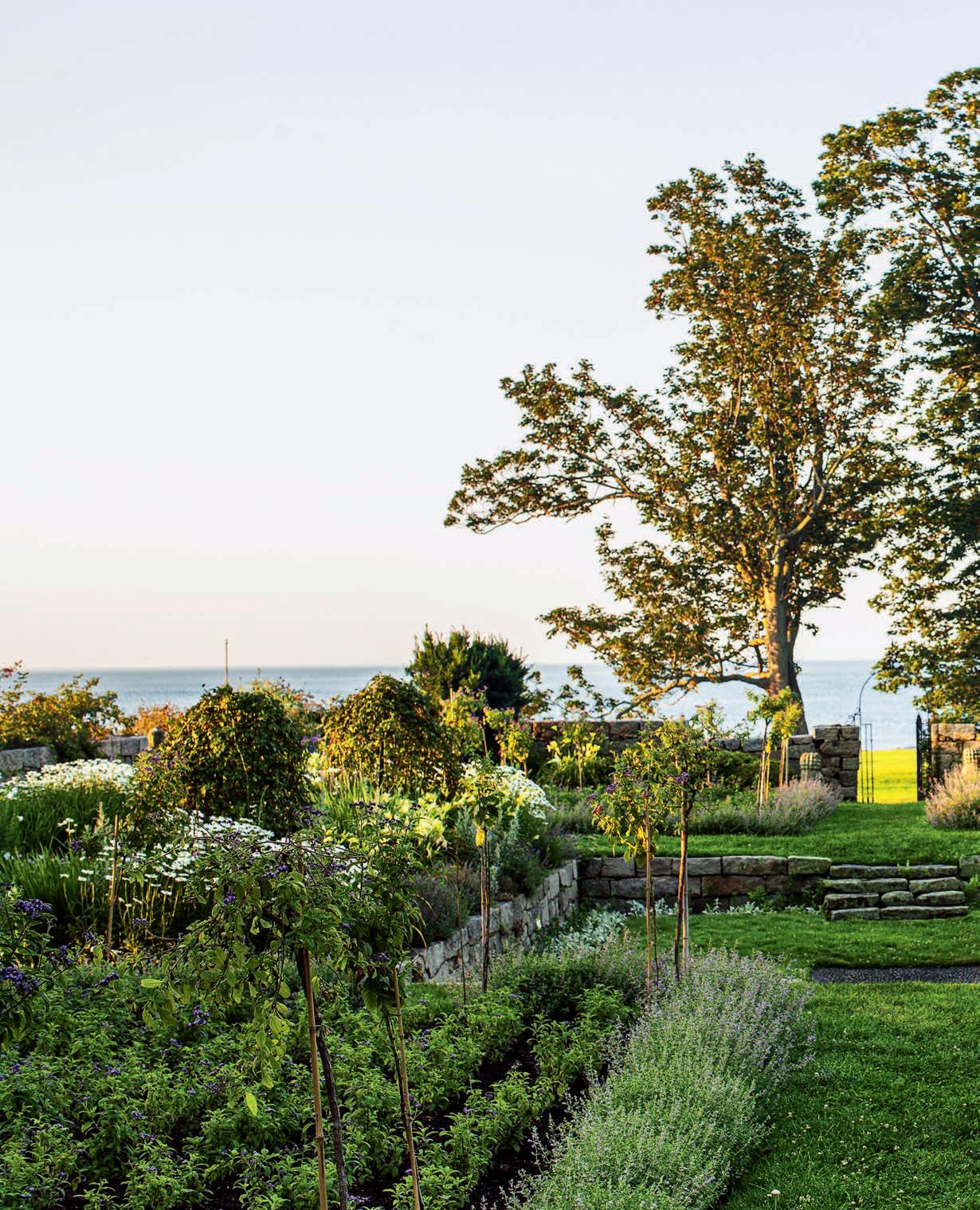
Cultivate your sense of wonder amid New England’s historic garden landscapes.
BY KIM KNOX BECKIUS
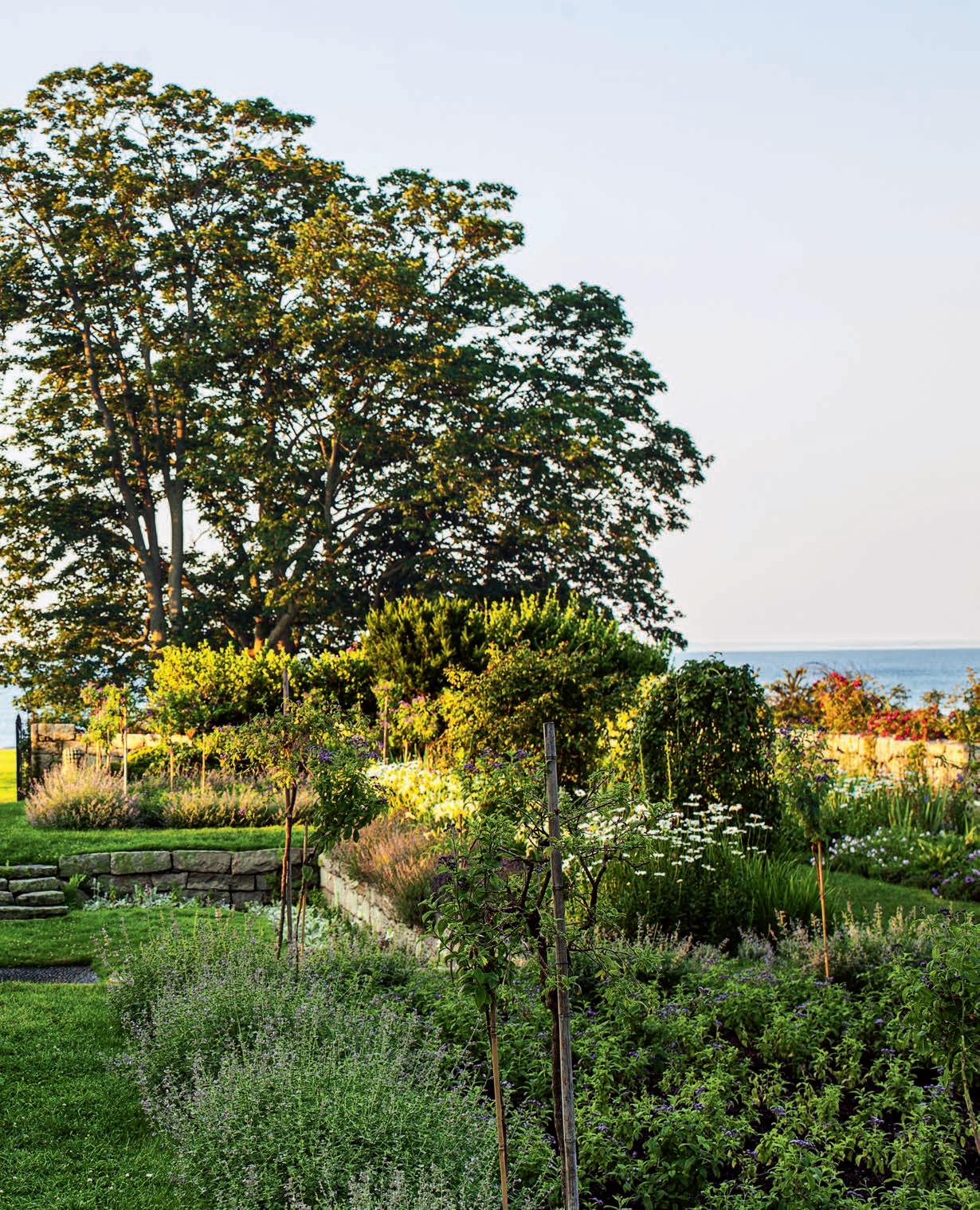
Visitors to Connecticut’s Harkness Memorial State Park can stroll the verdant grounds of a 1906 mansion known as Eolia, bequeathed to the state in 1950 by its last owner, the philanthropist and garden aficionado Mary Harkness. The property’s East Garden, shown here, is famed for its displays of

There was a time when I drove through the gates of a 434-acre Hudson River estate each weekday, down an allée of black locusts that heralded the arboretum’s grand specimens. In any moment of work stress, I could step outside my office into the finest example of Andrew Jackson Downing’s landscape ideals. Those vistas, formal grounds, and woodland paths were a cure-all.
Ever since, I’ve sought out historic gardens here in New England with power beyond their plantings. These blooming worlds with old “bones” were conceived to amuse and surprise, as open-air art and a backdrop for socializing. My favorites are waiting for you, a tonic in these less leisurely times.

“No red plants,” Mary Harkness instructed Beatrix Farrand, a famed early 20th-century landscape designer, emphasizing her distaste for scarlet flowers at her Goshen Point estate. Farrand shaped the Gardens at Eolia in Waterford, Connecticut’s Harkness Memorial State Park from 1919 until 1929, then returned annually to refresh them for almost two decades more. Only a handful of Farrand’s more than 200 American gardens survive, and this series of seaside installations, including an alpine rock garden, nearly vanished, too. It was saved by the Friends of Harkness, founded in 1991 to lobby for ambitious restoration.
Today, garden volunteers help with tasks ranging from pruning apple trees in March to winterizing roses in November. On any Wednesday, Friends members can show up at 9 a.m. and join this crew, learning as they help sustain Farrand’s legacy. All while breathing in the almondy scent of the East Garden’s famous heliotropes, enlivened by Long Island Sound’s salt spray.
With the state park’s Gatsby-era mansion and languid lawns, you may be more inclined to dream away your time here. Bring a blanket, and stop at Ivy’s Simply Homemade in Waterford for the makings of a perfect picnic supper. Evenings are when the west-facing Italian Garden, flowering in sunset shades of bright yellow, deep purple, and dusky orange—without a speck of red—takes on a glow that attracts portrait photographers. friendsofharkness.org/harkness-gardens
BEST TIME TO GO: Shop for heirloom heliotrope and other annuals and perennials at a massive annual plant sale, held the Saturday after Mother’s Day.
GARDENING TIP: “Fertilize roses in the spring with all-organic Rose-tone,” suggests Friends of Harkness horticulture chairman Randy Fahey, who nurtures 90-plus rose plants. “It’s really good stuff.” A half cup suffices, but you’ll want to use a full cup for a really showy rose.
In Seal Harbor on Maine’s Mount Desert Island, the Abby Aldrich Rockefeller Garden defies occasionally harsh coastal conditions with its explosive color clusters and contrasting foliage. In 1926, John D. Rockefeller Jr. and his wife, Abby, challenged Beatrix Farrand to marry their passion for Asian statuary with an Englishstyle cutting garden. Through letters, sketches, and photographs, the two women’s collaboration took imaginative turns, blending East and West and incorporating architectural features that frame scenes, like gilded wood ’round an Impressionist painting.
The public has been invited into this living museum on

the original
a routine basis only since 2018, when the Land & Garden Preserve took ownership of the property at the bequest of the Rockefellers’ son, David. Reservations are required to wander through outdoor “rooms” cherished by the Rockefellers. And the season here is brief: just nine weeks. Mid-July visitors see delphiniums like New Millennium Series ‘Pagan Purples.’ These born performers tower over annuals and perennials. Then come the Lilium hybrids with their overwhelming fragrance. Then dahlias and gladiolas. By the last few open dates in September, fallblooming perennials are in their yellow-and-orange glory.
All this comes with vistas of the mountains of Acadia National Park as you wander surrounded by centuries-old statues. You can stay for hours if you’d like, listening to the meditative music of water features and the splish-splash of frogs … walking the Spirit Path, with its watchful Korean funerary figures carved from granite … even venturing into the evergreen woods between the walled garden and a terrace that is all that remains of Eyrie mansion, pine needles cushioning and quieting your every step. gardenpreserve.org/abby-aldrichrockefeller-garden
BEST TIME TO GO: The Rockefellers retreated to their summer home in early August, and the garden has historically been considered to be at its dreamiest then, when lilies start to bloom.
GARDENING TIP: “Before I worked here, I never used tree branches as plant support,” says Cassie Banning, director of farm and gardens. As the Rockefellers’ gardeners did, her team artfully cuts gray birch branches and installs them around plants to keep them from leaning or breaking as flowers grow heavy and summer storms sweep through. These natural props are quickly camouflaged as snapdragons, phlox, and other stunners grow sturdily to three or even four feet tall.
While Edith Wharton was penning her scandalous breakout novel, The House of Mirth, she was also creating a home and gardens that she proclaimed her greatest achievement and a source of comfort through times of loss. At The Mount in Lenox, Massachusetts, you’ll come to understand a woman who left us with not just stories but also a nonfiction prescription for designing spaces—including outdoor realms—that satisfy our need for structure yet honor the unpredictable beauty in nature’s gifts.
The Mount allowed Wharton to put into practice the anti-Victorian style she and architect Ogden Codman Jr. espoused in her first book, 1897’s The Decoration of Houses. Stand on the terrace (or have lunch at the Terrace Café), surveying the French-style flower garden and
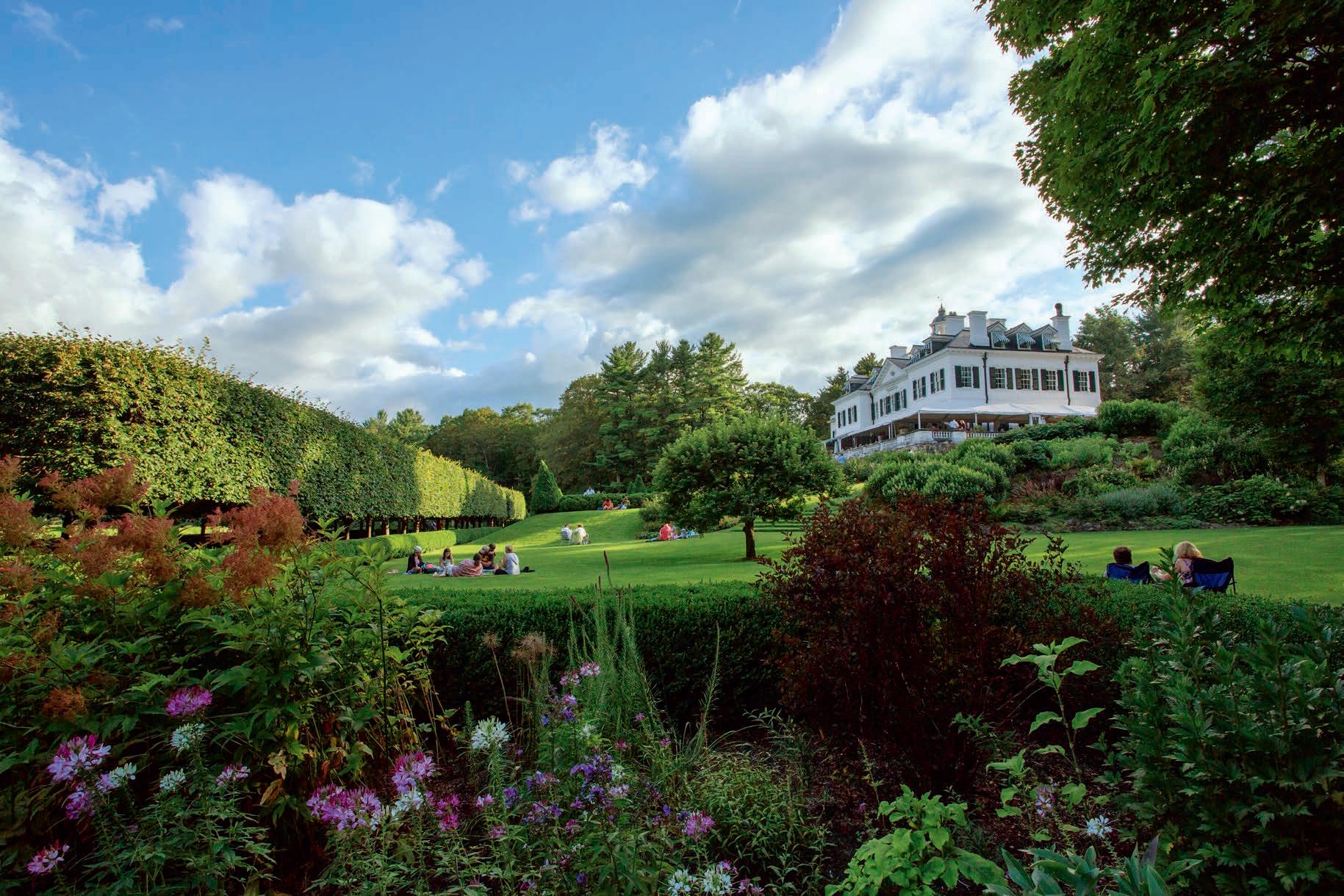
Italianate sunken garden, and you’ll notice that symmetry is among their dictates. In the Berkshires, spring arrives on its own timeline, but when the house opens mid-May, there will be tulips and the earliest annuals, as well as swaths of periwinkle-colored vinca, running as wild as the streams that give the grounds their musical score. Come late May, and on view through fall, a new selection of large-scale sculptures will accent the maple-lined entry drive, which Wharton’s niece, Beatrix Farrand, laid out. Daily garden tours at 1 p.m. are reserved for ticket holders, but the nonprofit behind this multifaceted

destination began offering free grounds admission during the pandemic; you can return whenever your spirit needs a boost. Wharton’s cherished gardens had grown over completely by the time a six-year restoration of mansion and grounds began in 1999, so pause, too, to appreciate how much effort went into ensuring her legacy has life beyond what’s nestled between book covers. edithwharton.org
BEST TIME TO GO: Wharton wrote a garden should have “a charm independent of the seasons,” but to be especially wowed, come in late June or early July, when
The first woman to be awarded the Pulitzer Prize for fiction, Edith Wharton was also well regarded as an arbiter of classical style and taste. At the author’s nearly 50-acre estate in Lenox, Massachusetts, it’s easy to see why.
the Italian Garden’s climbing hydrangeas have flowered, and the ‘Bridal Veil’ astilbe, planted along the outside of the parterre, blooms in dancing clouds of ethereal frothy-white.
GARDENING TIP: “You don’t really need a lot of flowers,” says Anne Schuyler, director of visitor services and interpretation. Only four or five plants, including the vines, give Wharton’s Italian Garden its dramatic atmosphere, beloved by brides. And don’t overlook posies that purists might consider weeds. Wharton mentions Michaelmas daisies among her likes, so although they grow naturally all through the woodlands, “our gardener has them in the formal flower garden, and they look great.”
Private Sakonnet Garden in achingly scenic Little Compton, Rhode Island, is the sort of secret place you never forget once you’ve found it. To be considered historic, a landmark must be 50 years old, according to Google. Which means this remarkable destination—the product of John Gwynne and Mikel Folcarelli’s decades of passion, labor, perseverance, and experimentation—just squeaks in. Gwynne, a landscape architect and pioneer in naturalistic habitats who headed exhibit design for the Bronx Zoo, has nurtured the lot adjacent to his family’s summer home since 1974. He soon gained an accomplice,
equally fascinated by and eager to tinker with plants, although Folcarelli’s background was in fashion retail.
To say the two have merged a Japanese stroll garden with a mini English estate garden oversimplifies. What started as a collection of plants in a deep thicket has become New England’s own Wonderland, and you are Alice. Once greeted, you’re off on an odyssey of shadow and light, through more than a dozen garden “rooms,” many named for their dominant tint: silver, yellow, pink. Folcarelli prefers to hand you a map when you leave, so embrace the sensation of feeling untethered in a world of eclectic specimen plants: even magnolias, camellias, and palms that push the limit of what can survive here. Rarest of all is a white Mertensia discovered by a plant hunter in the Pennsylvania woods—rare because Mertensia are all blue.
“Covid gave us a pause to think about how we wanted to share the garden,” Folcarelli says. In 2021, they began offering self-guided tours Thursday through Saturday from the first weekend in May through the first weekend in October, by online reservation. They’re compiling 50 years of observations and meticulous notes into what will be a glorious book of imagery and stories. And they continue to learn from the astonishing things outside their door.
“I think of it as a new garden,” Gwynne tells me, and while the prospect of a book delights him, he’s even more

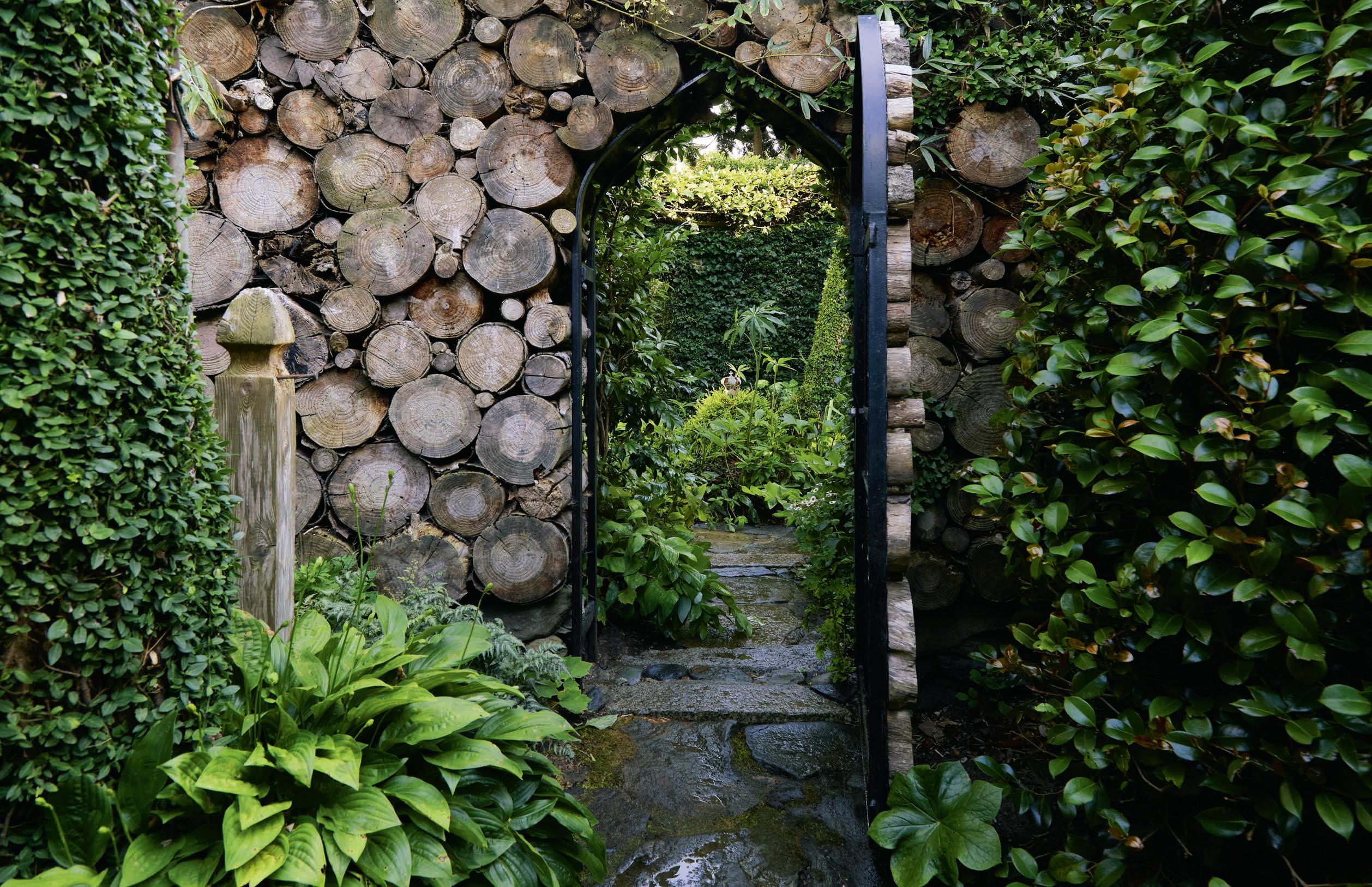
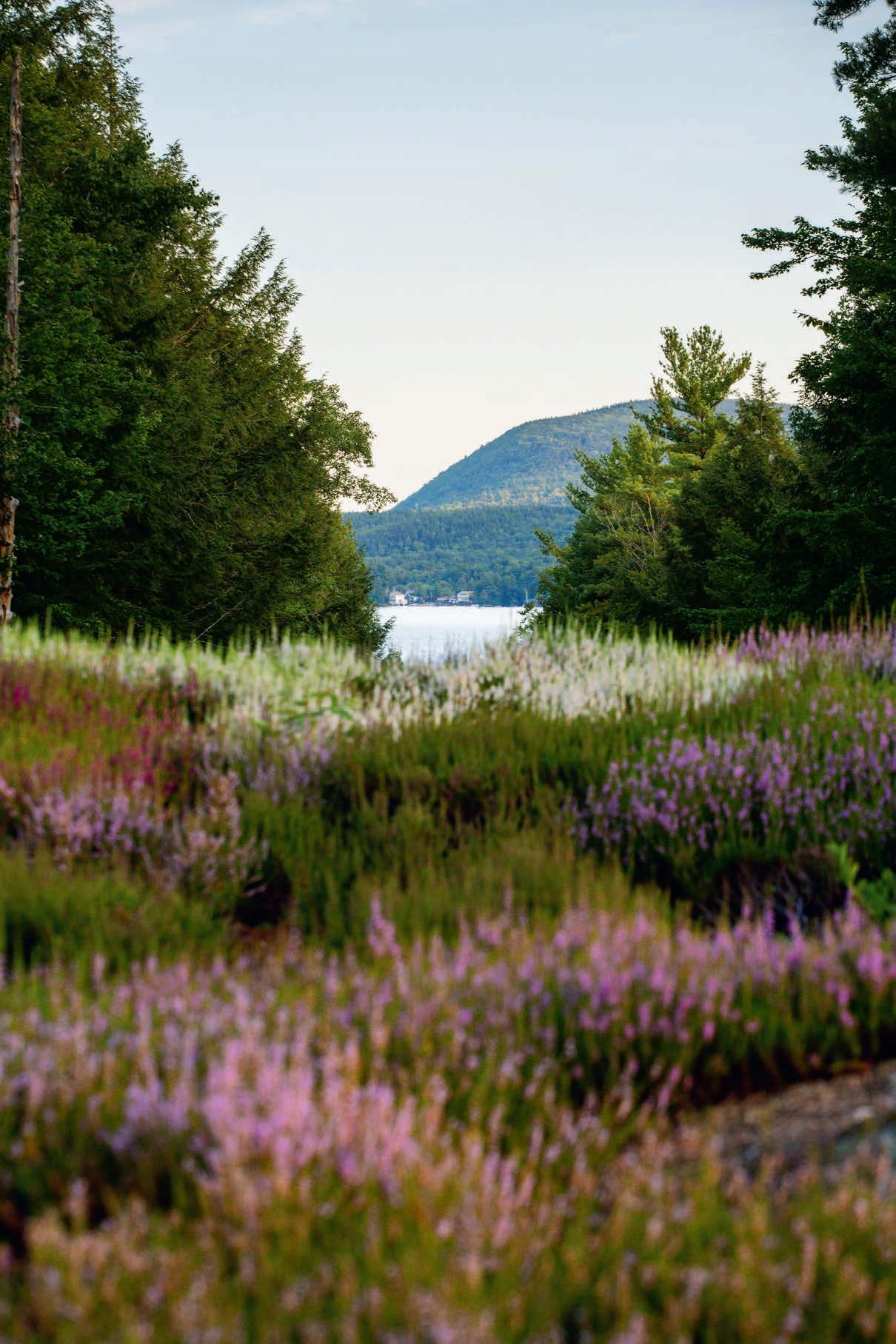
jazzed about ‘Felix Jury,’ a new young magnolia from New Zealand that, when mature, “will be a big hot-pink fantastic thing.” sakonnetgarden.net
BEST TIME TO GO: Rhododendrons bloom from the second week in May through the second week in June. Gwynne always brought armloads of cuttings home from gatherings of the Massachusetts chapter of the American Rhododendron Society. What you’ll see now are the hardiest, least fussy, and quite simply most amazing rhodies.
GARDENING TIP: If you’re at the beginning stage of garden installation, “start with the trees,” Folcarelli advises. They take longest to grow, and “you can always move them around.”
On sweeping acreage that slopes gracefully toward Lake Sunapee, Clarence and Alice Appleton Hay saw their garden dreams flourish. They’d inherited The Fells in Newbury, New Hampshire, in 1905 from Clarence’s father, John Hay, Abraham Lincoln’s private secretary, who later served as secretary of state under William McKinley and Theodore Roosevelt. Alice wanted formal gardens, so once Clarence completed a landscape architecture course at Harvard, they set to work filling a high-walled, sunlit space with bright perennials. Now known as the Old Garden, it’s become shadier—more hospitable to ferns, hostas, lungwort, wild ginger, and Lenten roses—as surrounding woodlands have marched toward the walls.

secret if you live in the Northeast,” says landscape director Holly Dunbar. While rhododendrons and hydrangeas thrive in New England’s naturally acidic soil, most ornamental plants do better when the pH is neutral. “Wood ash works similarly to garden lime and can raise the pH level,” she explains. “I recommend mixing clean ash from untreated wood into your beds in the fall.”
Formality continued to win out: They added the Rose Terrace and the Perennial Border. But starting in 1929, Clarence spent 10 years indulging his own desire to introduce rare alpine plants from his travels into a largestone-cobbled hillside facing south toward the lake. In the Rock Garden, with its lily pool ringed with irises and azaleas, the heartiest of these specimens survive. Clarence knew he was experimenting and wouldn’t be shocked to learn only about one-third of the original rockscape remains visible.
Now the nonprofit that manages The Fells is determined to restore and reinterpret the Rock Garden. The property needs all the human and financial capital it can muster. Your admission fee can help secure this notable garden’s future; your time and curiosity are even more valuable. thefells.org
BEST TIME TO GO: The grounds are open yearround, and even before buds appear, new greenery magically begins to erase brown soil and gray branches. Along a woodland trail, fairy houses built last summer need sprucing up—the perfect job for nature-loving kids.
GARDENING TIP: “Wood ash is the best-kept garden
From the aerial vantage point of Mary Harlan Lincoln’s sitting room, you can see how strikingly the formal garden at Hildene, The Lincoln Family Home resembles stained glass. Privet hedge that took root nearly 120 years ago forms shapes like soldered lead; flowers are the richhued glass. These days, the privet is sheared weekly to maintain its integrity.
Beginning in 1975, following the death of Mary
While the overall landscape design at Hildene was done by an Olmsted protégé, it’s the formal garden that commands attention. Designed in 1908 by Jessie Harlan Lincoln as a birthday present for her mother, Mary, it’s small as estate gardens go—but combined with its mountain backdrop, it’s a showstopper.
Harlan and Robert Todd Lincoln’s granddaughter, Peggy Beckwith (Abraham Lincoln’s great-granddaughter and Hildene’s final resident), the property spent several years in limbo. In the 1980s, overgrown privet was tamed, beds and pathways were restored, and then … a plan for the formal garden was discovered. Jessie Harlan Lincoln likely designed this area between mansion and mountains, but curiously missing from the drawing is the signature privet. The only photographs are black and white. Without documentation, those who tend the garden today are free to think sustainably and playfully, while still coloring within vintage lines.
To appreciate all that’s growing here, wander behind the coach house turned Welcome Center to the cutting and kitchen gardens. There’s a butterfly garden, too, planted to attract native species. Volunteers also tend Hildene’s Giving Garden, which supplies the local food bank. There are trails through wild meadows and a floating boardwalk through the wetlands. A visit to stillworking Hildene Farm is included with your admission.
Music from the original 1,000-pipe player organ beckons you toward the Georgian Revival mansion built in 1905 by Honest Abe’s only child to see adulthood. Before heading inside, stand within brick lines on the front lawn that illustrate the size of the cabin where the president was born. This contemporary landscape addition is a history lesson in a heartbeat, highlighting the contrast between Robert Todd Lincoln’s fortune and his father’s humble origins. hildene.org
BEST TIME TO GO: It’s hard to top the first few weeks in June, when 100 peonies’ 1,000 blossoms make a paleand-hot-pink splash. Among the peonies are two unique cultivars, recognized by the American Peony Society and named ‘Jessie Lincoln’ and ‘Hildene.’
GARDENING TIP: If you’re a peony “parent,” try the Hildene Star staking method. Horticulturist and greenhouse manager Andrea Luchini explains that this technique requires five sturdy stakes and jute twine— or a kit from the Museum Store. Create a star pattern connecting the stakes, placed equidistant around the plant, then continue wrapping the twine around the outside of the stakes to make a full circle. Can’t picture it? Luchini and colleague Eric Rose demonstrate on Hildene’s YouTube channel.
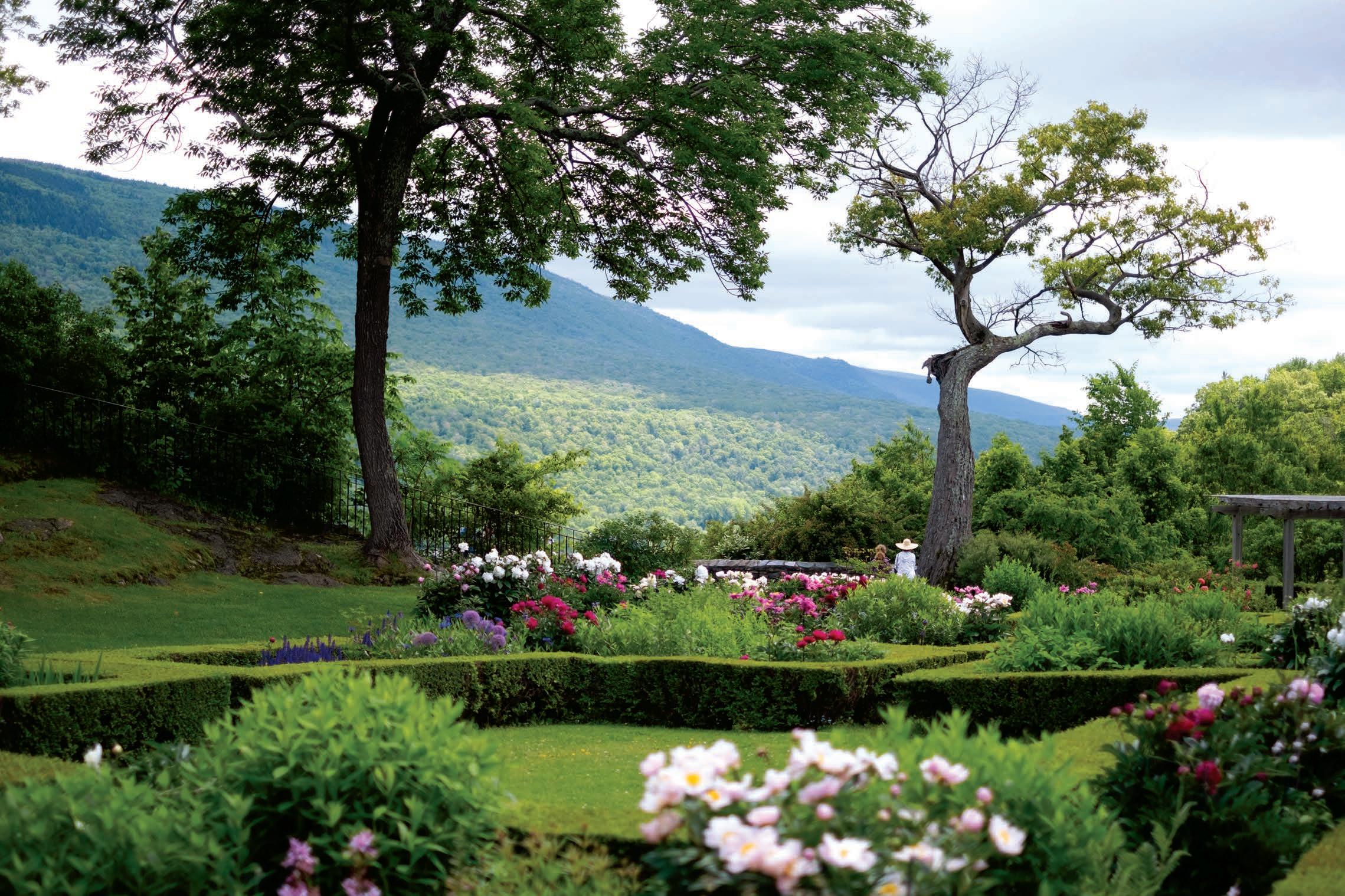

When it came to building a new genre of television, This Old House creator Russ Morash went DIY all the way.
BY BRUCE IRVING
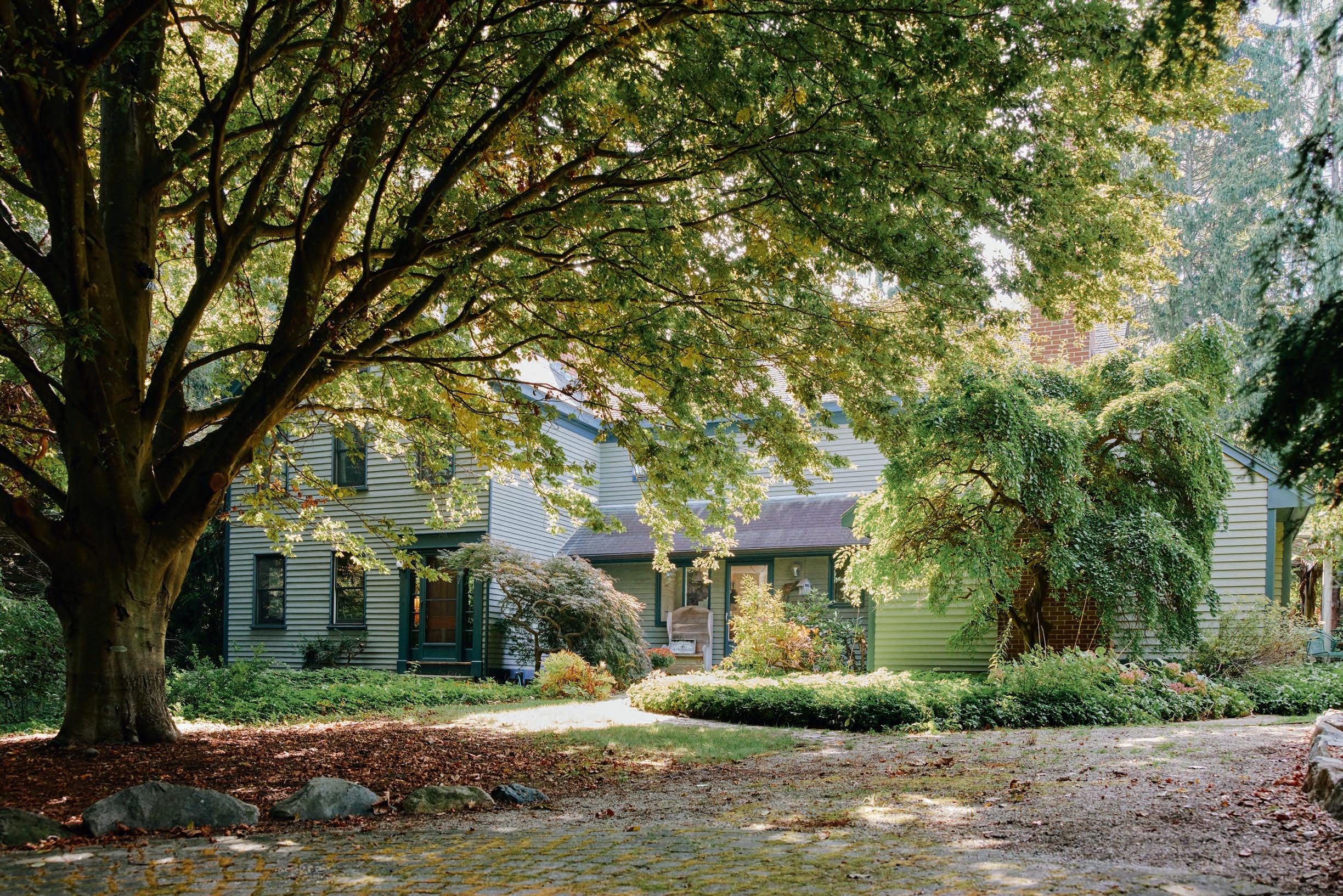
After buying this 1851 house in Lexington, Massachusetts, more than 50 years ago with his wife, Marian, Russ Morash renovated it for his family’s needs while also making it the hub for three beloved public television programs: The Victory Garden, This Old House, and The New Yankee Workshop.
INSET: A 2015 portrait of Morash taken by his grandson, Jack Cohen, on the set of The New Yankee Workshop
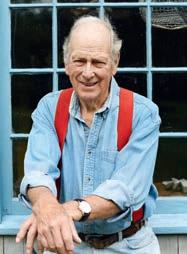

“Russ Morash, 88, died after a brief illness on June 19, 2024.”
I still can’t quite believe I’m writing that, having hung out with Russ and his wife, Marian, for this article only a few months before. at day, he’d been the same inimitable, avuncular, irascible, con dent, brilliant guy I’d known since we’d met in 1980, when I was 19 and working as a busboy in the Nantucket restaurant Marian had co-created, and he was 44 and had just launched is Old House, the show that would cement his reputation as a television pioneer.
A few years later, having graduated from college and working in Tokyo but wanting to live in Boston, I wrote to Marian to see if I could talk to Russ about a job.
ere was at that time precisely one full-time position on is Old House. It happened to be open, I got it, and I spent the next 17 years producing the show.
During my last visit to his house, Russ and I reminisced about our adventures from that time together. Highlights included shooting a scene atop the north tower of the Golden Gate Bridge, interviewing the Lady Chablis from Midnight in the Garden of Good and Evil, and helicoptering over an active volcano in Hawaii—all in addition to the dozens of house renovations we followed step by step through sun, rain, and snow, all across the country.
Along the way, we’d had most of the struggles a boss and a right-hand man can have. But we had put all that behind us years ago: He’d retired, I’d left the show, and we’d formed a brothers-in-arms friendship that glowed warmly as I interviewed him. My unsolicited advice: Stay close to the people you’ve shared the journey with, because you never know when your paths will diverge. >>

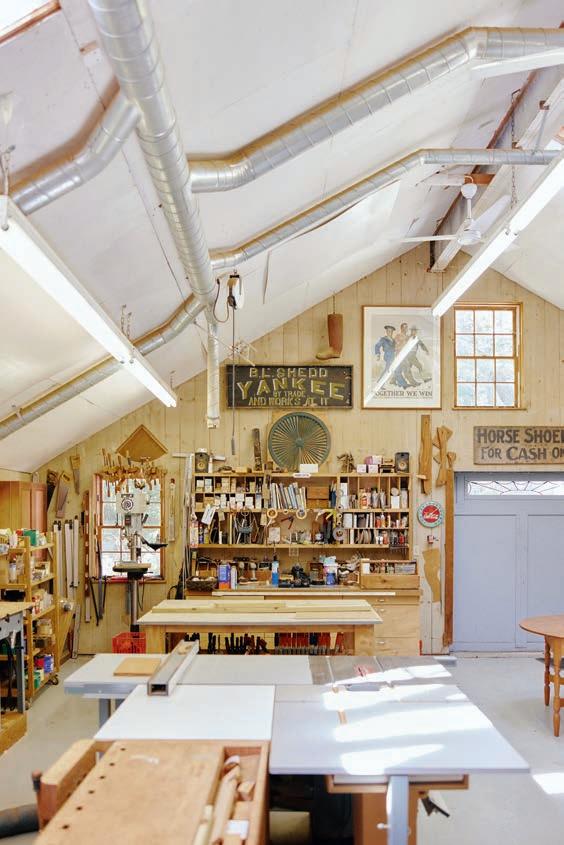
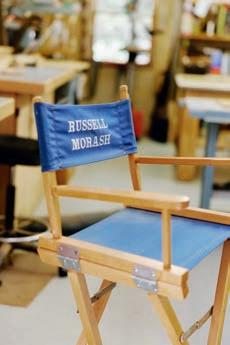
Reminders of Russ Morash’s long career can be seen throughout the home and grounds, including the tool-filled outbuilding where The New Yankee Workshop was filmed (BELOW LEFT AND RIGHT); Morash’s director’s chair can still be spotted there (ABOVE). The house also boasts several pieces of furniture crafted by that show’s host, Norm Abram, such as a Queen Anne–legged tiger-maple highboy featured in a 2005 episode. FAR RIGHT: The farmhouse as it looked before the Morash family moved in.
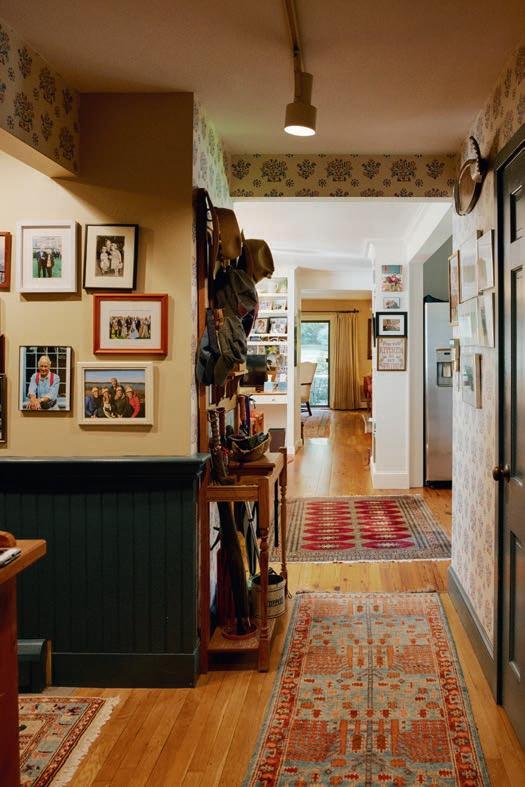
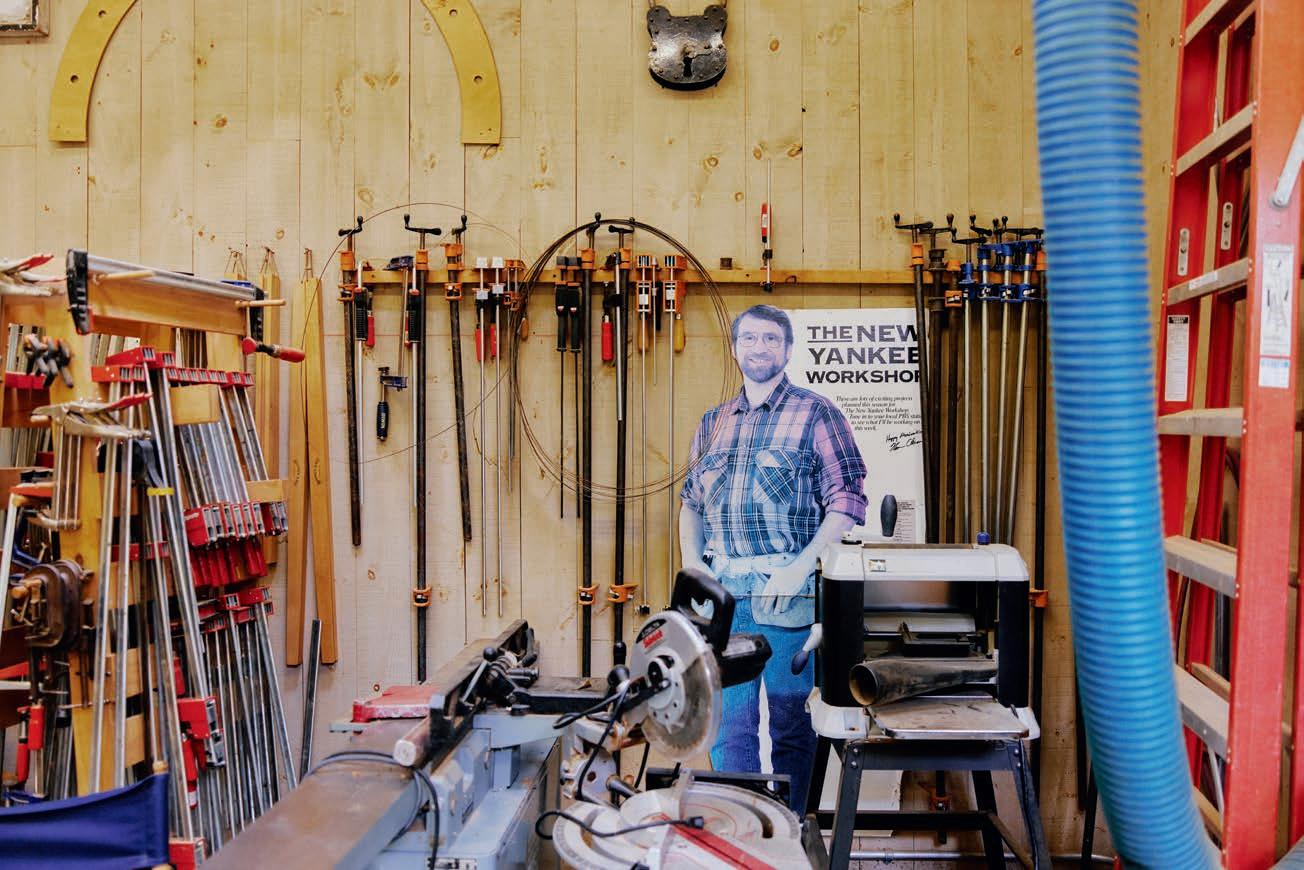


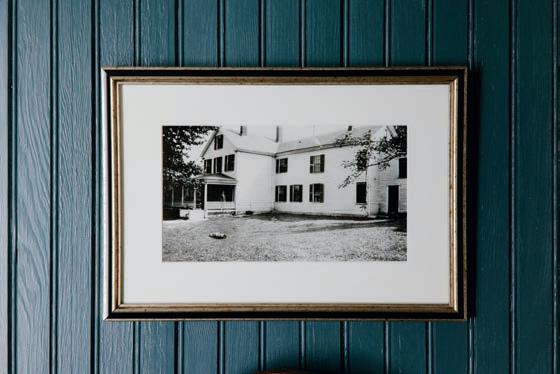
There’s an on-brand memento as soon as you enter Russ and Marian Morash’s renovated 1851 farmhouse: a framed black-and-white photograph that shows the building back in the old days, long before they bought it in 1974. It’s a classic “before” to the “after” they’ve built in a long series of improvements, like a six-decade episode of This Old House. The house, the workshop out back, and these two acres of New England soil have been background and foreground to three iconic American how-to television series—The Victory , This Old House, and The New Yankee Workshop supplying the visuals and content for at least two generations’ idea of the right way to grow, cook, and build.

In fact, it’s safe to say that without this slice of Lexington, Massachusetts, the entire genre of how-to TV would have looked a whole lot different—if it had come into being at all. That’s because Russ, now 88, essentially invented the concept, and if he’d stayed inside the studios of his employers at the Boston public broadcast station WGBH, he might have spent his career differently. Joining the fledgling station as a cameraman in 1961, the Boston University theater major cut his teeth on publicinterest shows like The Advocates, but it was his work with Julia Child on The French Chef that planted the seeds for what was to come.
Starting with omelets and beef bourguignon, showing how things get done step by step turned out to be his passion. Voice-overs, lots of edits, and other production fripperies didn’t interest him—as in theater, the immediacy of a long scene seemed right to him. “You want to ,” he says.
When he started a show about gardening in 1975, that meant turning a patch of greensward next to the station’s loading dock into a 75-by-75-foot working field. When that garden became a popular stop on station tours, he and his bosses knew he was onto something. And when Russ saw a guy measuring the plot and found out it was The Victory Garden would now be charged on a square-foot basis for use of the land as a studio, Russ knew it was time to decamp. He had his own land.
“You can’t know it till you grow it!” Russ would say. The talented plant people he employed—Jim Crockett, Bob Thomson, Roger Swain—helped him turn his backyard into a laboratory to show everything from how to build a cold frame to how to brew manure tea. A greenhouse came next, crucial to keeping a New England garden going and, as important, to extending the production season.
As the crops poured forth and the station started getting letters asking How do I cook that vegetable I just saw?, it was time to enlist Marian. A self-described home cook, she brought a cheerful you-can-do-it spirit to the screen, whipping up dishes in the Morash kitchen (which Russ and his father had built from scratch in their basement) and not leading with the fact that she was also head chef at a renowned Nantucket restaurant in the summer months. The unerringly useful Victory Garden Cookbook she published in 1982 has sold more than 350,000 copies.
Back at the old photo, Russ points to the rear ell of the house and describes how they kept the roof but removed everything else, rebuilding the structure to accommodate their growing family. Daughters Vicki and Kate grew up in this house, though Vicki was born when the Morashes lived in their first place, a modest cottage a few streets away. There, when the excavator Russ had hired for a new addition’s foundation broke down, he dug it himself, by hand. His father had been a house builder, and Russ wasn’t afraid of hard work—nor was he averse to the cost savings that come from doing things yourself.
Thrift is in his blood. “All the plywood we used here,” he says with some pride, “it came from the John Hancock Tower.” (When its windows began popping out during construction in the mid-1970s due to a design defect, the landmark Boston skyscraper removed all 10,334 of them, with their temporary replacements earning it the nickname the Plywood Palace. After new windows went in, the 20 acres of used plywood then went on sale for a buck a sheet. Russ pounced.)
A guy with a reverence for the past—victory gardens hark back to the world wars, houses are more interesting when they’re old, and Yankees have been in New England from its beginnings—Russ was equally focused on the new. Despite coming out of the theater world, he embraced the new technology of television, and he made sure his shows limned both tradition and the latest and greatest gizmos.
Lexington was his palette, a media-age working farmstead. The outbuilding that This Old House master carpenter Norm Abram built, in part to hold garden equipment for The Victory Garden, went on to be the set for the Abram-hosted The New Yankee Workshop, a mesmerizing mix of old-school craft and cutting-edge woodworking machinery, the shop brimming with laser-guide miter boxes and a table saw whose blade stopped the moment a finger touched it.
His father had been a house builder, and Russ wasn’t afraid of hard work— nor was he averse to the cost savings that come from doing things yourself.
A big European beech tree was transplanted in the yard when The Victory Garden wanted to demonstrate what a huge truck-mounted tree spade could do. When radiant heat became a thing in the early 1990s, Russ installed a warm-water pipe system in his driveway for snow-melting, trying out a new macadam containing recycled plastic at the same time. (Perhaps unsurprisingly, he never uses it because it consumes too much natural gas to heat the water.) When This Old House featured new energy-efficient windows with a heat-reflecting membrane suspended inside their thermal panes, he decided to install some in his Nantucket vacation home to test them. (He grimly reported later that their seals failed.) On the day of my visit, he was rebuilding a garage door whose composite bottom panels had rotted away, lamenting the way companies use “these new materials that have been tested in some lab for a couple of months.”
The Morash living room sits in the rear addition they put on in 1974. Light-filled even on a gray day, it looks out over the landscaped backyard, garden beds in the distance. It’s hard to miss the golden glow of the 14 Emmy statues in this room (Russ has another one, a prestigious Lifetime Achievement Emmy, out on Nantucket). Nearby stands Sam, a life-size cigar-chomping carved-wood cowboy with a stubble of nails. The house is tastefully replete with mementoes and antiques they’ve collected during the travels the show made possible—they picked Sam up during the This Old House project in Santa Fe. And everywhere are the works of Norm Abram. He made 236 projects during The New Yankee Workshop’s 21-season run, and most of them required a practice-run prototype.
“We just kept replacing our old furniture with these beautiful pieces,” marvels Russ. “How fortunate we are to live with this stuff.”
There are high-style examples, like the exquisite tigermaple highboy modeled on an original built in Connecticut in the early 19th century, and simpler pieces, like a threelegged Shaker candle stand in cherry. None escapes Russ’s wondering, wandering eye; he flips the candle stand to point out the triple through-dovetail joint holding the legs in place.
“You notice how there’s no wobble? There are no screws or nails holding it together. It’s perfect,” he says admiringly, “in all ways.”

ABOVE: Marian Morash (aka Chef Marian) in the kitchen where she demonstrated recipes for The Victory Garden. The author of two cookbooks inspired by the show, she also helped launch the Nantucket restaurant Straight Wharf.
BELOW, FROM LEFT: A backyard pergola at the Morash home sits amid the verdant landscape well known to fans of The Victory Garden; a handful of Russ Morash’s Emmys can be seen in a corner of the living room, behind a wooden cowboy dubbed Sam.


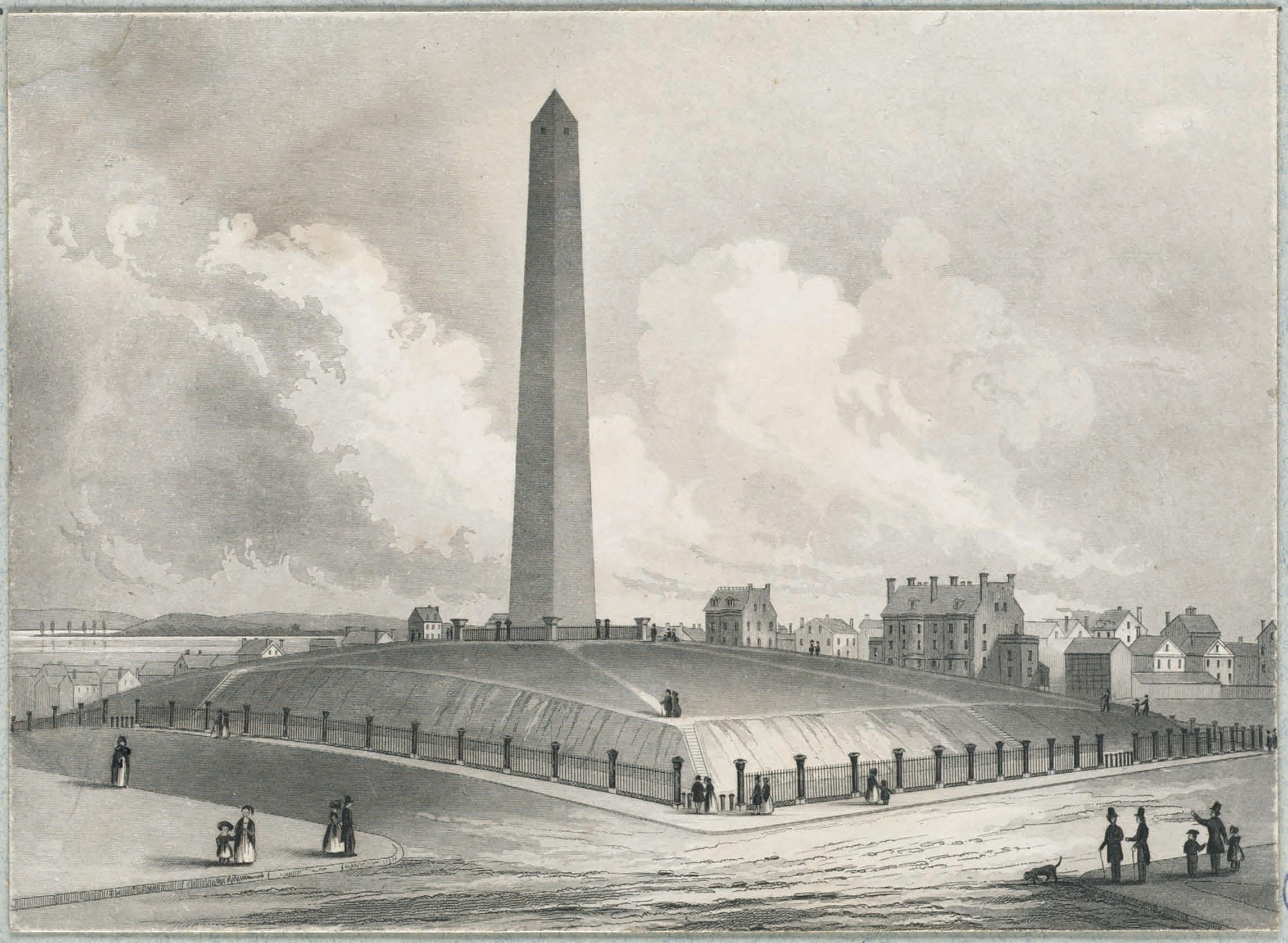
A detail of a period etching showing the Bunker Hill Monument as it looked when finally completed in 1842, after a 15-year span of stop-and-start construction efforts.
Up and up they go, following the 294 tightly twisting steps, big steps for a boy 4 or 5 years old.
“Was that hard?” his father asked him.
“Yes,” said David.
“Imagine how hard it was for the men fighting here,” his father said.
Years later, David realized how hard that climb was for his father, a veteran of World War II. “He served in the Navy and actually was badly wounded and wasn’t expected to survive, wasn’t expected to walk again. I didn’t recognize that as a child—that my father taking us up to the top of the monument was the closest thing to witnessing a miracle. His body was shattered, but his determination was greater than his disabilities.”
Tommy Hannigan wanted his son to know that “every American battle is connected to the battle fought here, and that every American who’s served their country is connected to the men who fought here.” That isn’t a line from a textbook; it’s what Tommy’s parents, who were Irish immigrants, taught him. Tommy’s parents “embraced everything that this country represented,” said David. “And I know that they expected their children to only ask one thing from the country, and that is to serve and nothing else. You had to protect the country and everything that it represents, defend the Constitution, defend the liberty of this nation. And I think my father was a very good teacher.”
It’s why David Hannigan has spent the past 10 years as a National Park Service ranger at the Bunker Hill Monument
in Charlestown, Massachusetts, near his own birthplace. “After my father’s death, I found that this would be a good way to serve the country, and battle against historical illiteracy. It’s the greatest evil.”
I’ve met him near the monument on the Sunday before Bunker Hill Day, June 17, 2024, the 249th anniversary of the battle. The weekend marks Charlestown’s own village holiday (“Townie Christmas, the best day of the year,” I’m told), with a big parade, family reunions, cookouts, and, presiding over it all—but at a distance, like the monument on the skyline—what is actually being celebrated.
The Battle of Bunker Hill was fierce; the losses were among the worst of any battle in the Revolution. The colonists’ defiance surprised King George III and impressed Europe. The king would send more men, tens of thousands of troops. It can be argued that the American Revolution, the fight that lasted from 1775 to 1783, started on this hill. It was “perhaps the decisive Day … on which the fate of America depends,” Abigail Adams wrote to her husband, John Adams, the day after the battle.
The nation has since known other decisive days, says Hannigan—December 7, 1941, or September 11, 2001— dates that mark before and after. “I try to indicate just the tragedy that was played out here in Charlestown, with hundreds and hundreds of lives being erased in a matter of minutes, the shock that is evident in statements by both British and American leadership,” he says. In two hours of combat, the British suffered a nearly 50 percent casualty rate, with 1,054 soldiers killed or wounded. The New England militia lost an estimated 441 soldiers—dead, wounded, or captured.
We’re standing at the Massachusetts Gate on the steps to the monument park. Visitors by twos and threes pause, hold up their phones, and smile for selfies. The monument itself looks crisp and pure in the background. Dog walkers stop to pose their dogs. (Fido on the Freedom Trail.) The neighbors are coming out, setting up chairs for the parade. The first runners in the Boys & Girls Club’s Battle of Bunker Hill Road Race stream by. It’s a Sunday in the park, as fine a June day as you’ll ever find.
Just up the hill, 30 men were bayoneted to death. General Joseph Warren, Boston’s favorite doctor, took a musket ball in the face; he was memorialized as one of the Revolution’s first martyrs. As the redcoats charged uphill on their third and final assault, the militia, out of ammunition, threw rocks and swung their muskets like clubs before they retreated. The British navy shelled Charlestown, setting it ablaze.
After the battle, a British lieutenant named John Waller wrote home: “I cannot pretend to describe the Horror of the Scene within the Redoubt [fort], when we enter’d it ’twas streaming with Blood & strew’d with dead & dying Men, the Soldiers stabbing some and dashing out the Brains of


others was a sight too dreadful for me to dwell any longer on.”
And today? A father tosses a Frisbee to his two little girls, a family sets up a table topped by a tower of pizza boxes. One sun worshipper lays out, lizard-like. This is the other monument: a day without war.
Men died where we picnic. The peace of the park buries the dead. Small memorial flags—the Stars and Stripes and the Union Jack, one for each fallen soldier—have been set out between the paths leading to the monument. It looks like a tulip bed, a nice touch of color.
The battle waged here was 249 years ago. And on this sunny, breezy June day, it may as well have been in the Pleistocene, the Ice Age.
ment that New England had led in battle and would lead in patriotic memory. The effort to remember rivaled what was being remembered. After construction began in 1827, the monument took 15 years to build. The first commercial horse-drawn railroad was built to move the obelisk’s massive granite blocks. Work stopped repeatedly when funds ran out. For more than five years there stood just a 37-foot-tall granite stump, a neighborhood eyesore. In debt, the Bunker Hill Monument Association sold two-thirds of the battlefield in the 1830s—a field they had saved from being cut into house lots.
The Bunker Hill Monument was born out of a worry that, 50 years on, America was losing touch with the Revolutionary War generation, a generation that was “united … in a common cause in defense of their rights,” as President James Monroe said on his visit to the battlefield in 1817. Monroe was seeking to unify the country after the divisive War of 1812, a war New Englanders hated.
The monument was an ambitious undertaking: a state-
Not everyone wanted a grand “national” monument. One veteran, Major Caleb Stark of New Hampshire, pleaded that those who served be given bread, not granite: “In room of giving them the bread that was solemnly promised, the debt is to be paid by a stone!!” (Service pensions were not extended to all veterans until 1832.) Others argued that an unadorned battlefield was the most powerful witness.
The battlefield, without the memorial, was a magnet.
(Continued on p. 106)
Fishing gear for sale along the roadside in Stonington, Maine, last summer. Earlier that same year, the town was hit by back-to-back nor’easters that damaged much of the fishing infrastructure, further challenging those trying to make a living in the epicenter of Maine’s lobster industry.
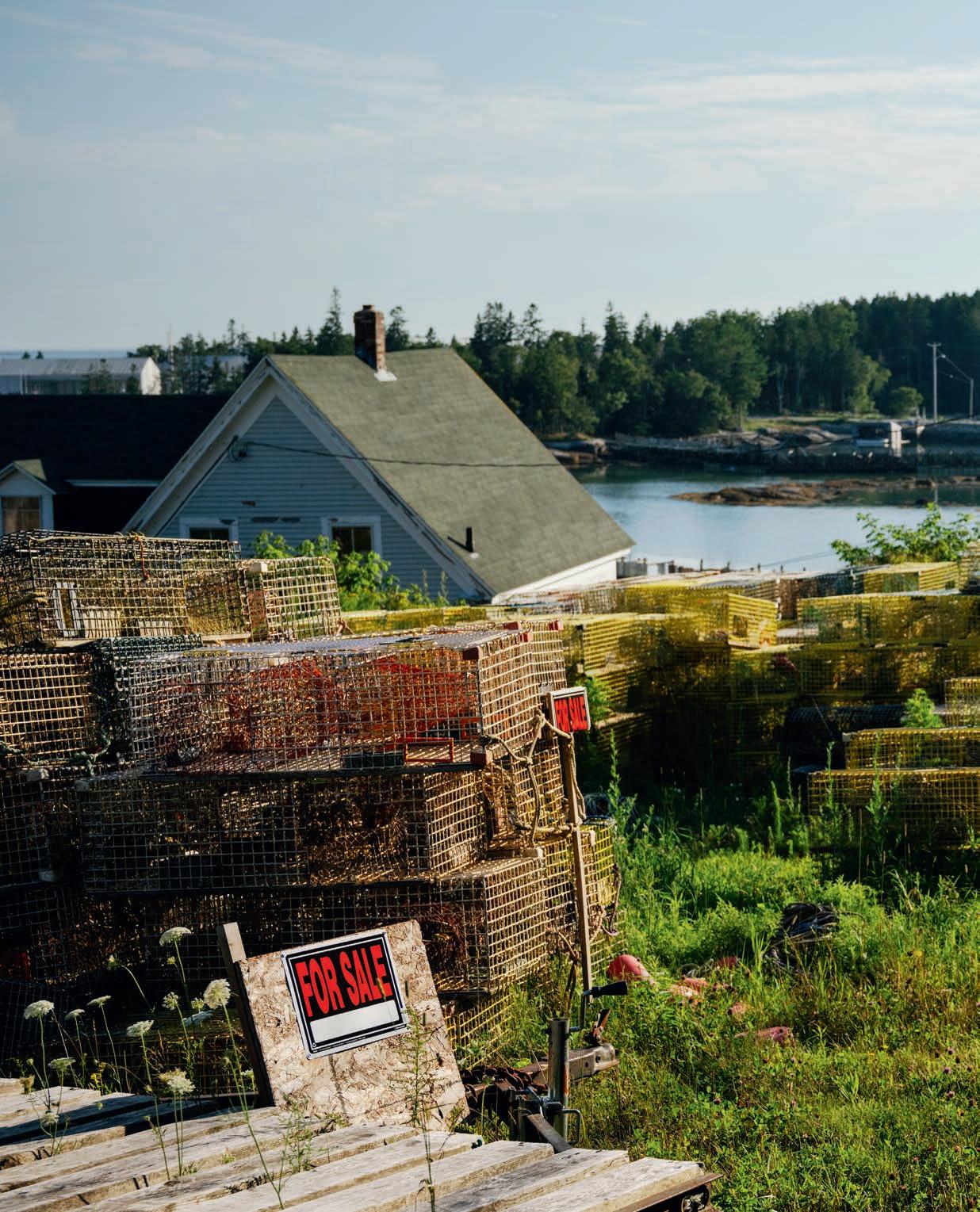
When you grow up with generations of tradition,
change can be both welcome and feared.
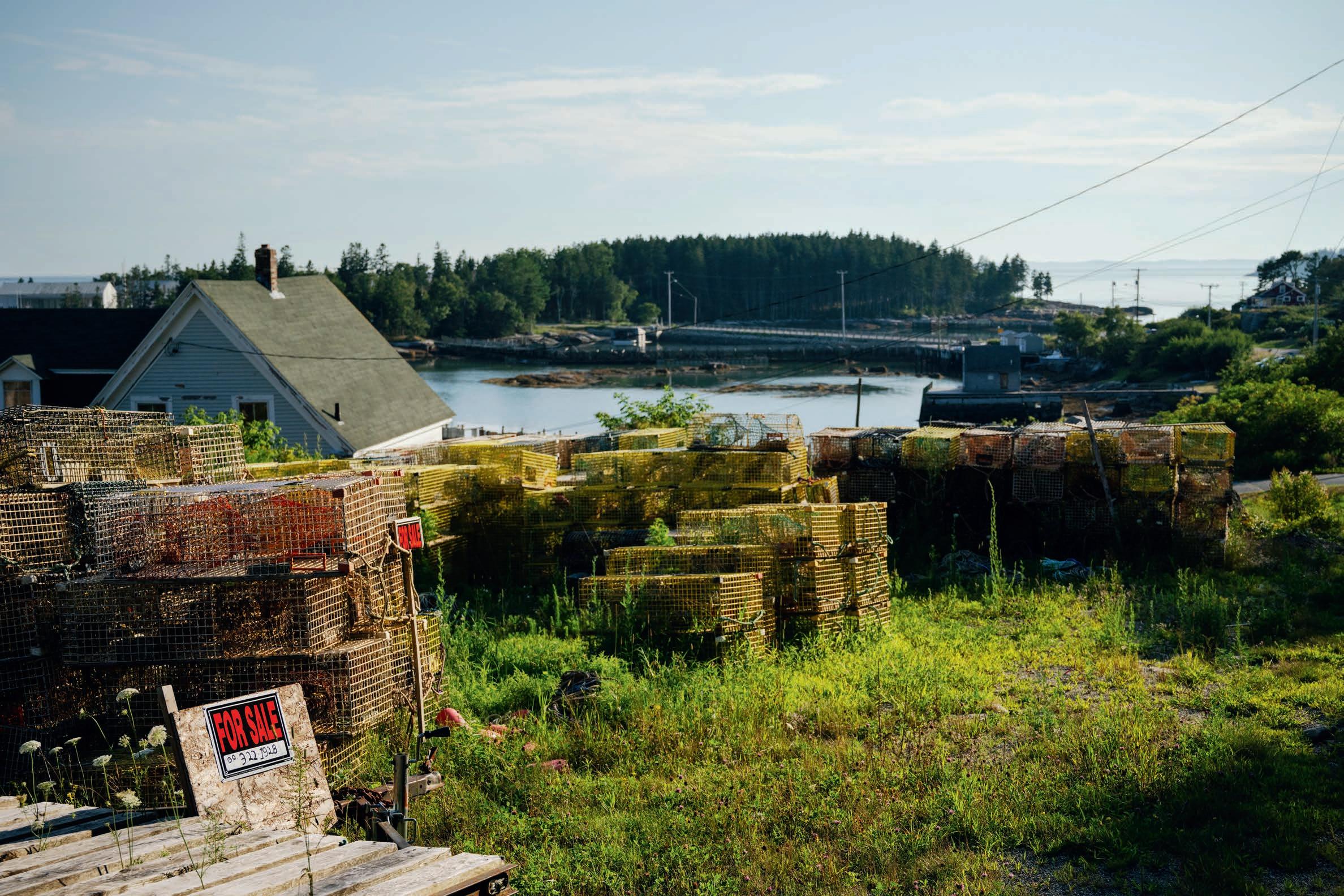
BY IAN ALDRICH | PHOTOS BY TRISTAN SPINSKI
I first visited Stonington, Maine, in the summer of 2003 to write a story for Yankee about the community’s proudly held identity as a fishing town. Even then, Stonington was an anomaly. While other main streets and harbors along the Maine coast had become the shiny domain of tourist shops and pleasure boats, here, on the rocky outermost tip of remote Deer Isle, lived just over 1,000 people whose

lives were still largely
built around what they hauled
The challenges Stonington faced back then—tighter regulations, increasing costs, wild swings in the price of lobster—still confront the town more than two decades later. But now it’s increasingly feeling the threat of climate change, too. Early last year, two powerful storms slammed into the island, cutting off Stonington from the mainland, devastating businesses, and swamping the public pier. The Gulf of Maine’s warming waters, meanwhile, are putting the very survival of the state’s signature lobster industry at risk. Even for a community long accustomed to dealing with headwinds, these latest developments beg the question: What will it take for New England’s largest lobster port to endure?
Last June, I returned to Stonington to find out.
∂
Robbie Eaton is ready to get on the water.
It’s pushing 5:30 on a Thursday morning in early June, and for the past half hour the 24-year-old has been prepping his boat, the Legacy, a mint-green 35-footer docked at the Stonington Fish Pier. It’s not quite summer but it’s starting to feel like it, warming up even at this hour, and the surrounding harbor is quiet, a testament to just how
from the sea.
early the workday starts around here. In Maine’s largest lobster port, many of its 350 boats motored off nearly two hours ago.
If Eaton were intent on chasing some of the season’s very earliest shedders, he would have joined them; however, his focus these past few weeks has been the state’s short halibut season. He’s licensed to catch 25 fish for the month, and with half of them already landed he’s determined to finish strong. The $12 a pound he’s fetching is decent, but the real value of the work is that it’s something different. When you lobster most of the year, it’s nice to break up the routine.
“I ain’t even got any of my traps set,” confesses Eaton, and takes a final swig from his can of Full Throttle energy drink. “I’ll start doing that next week.”
Eaton is a big guy who moves with the unrushed pace of someone who has spent most of his life working the ocean. Eatons have plied Stonington’s waters for generations, and in this tight-knit community of familiar names, theirs is one of the most well-known.
As Eaton prepares to launch his workday, his father, Mike, sits behind the wheel of his idling truck parked
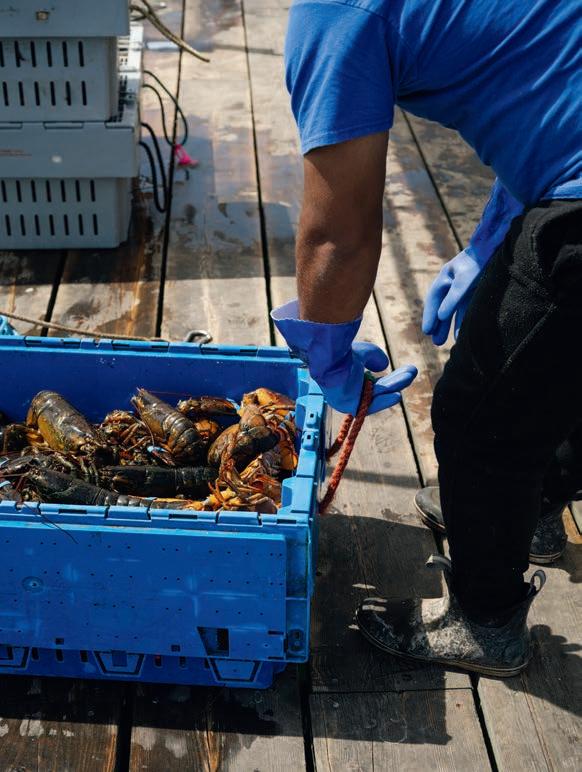
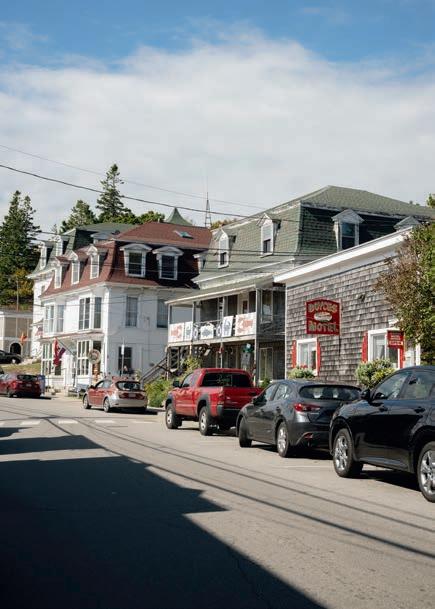
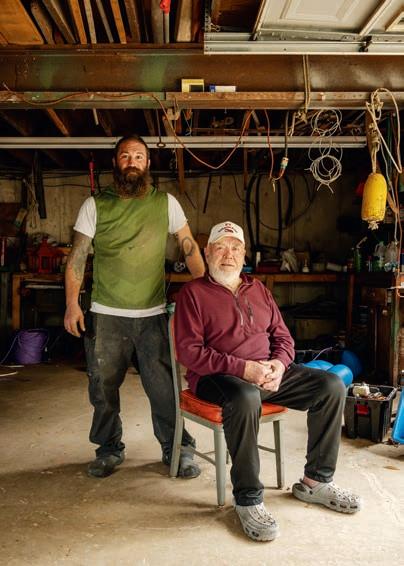

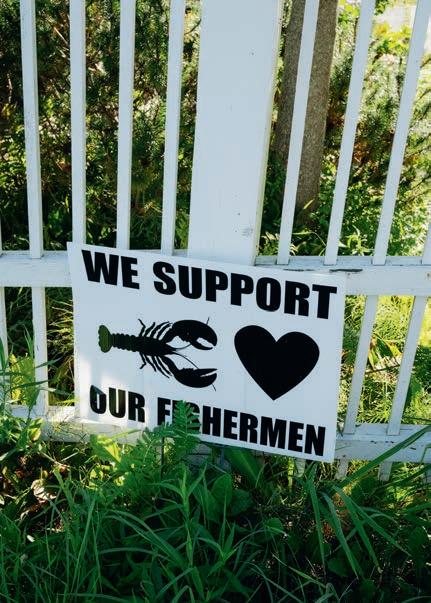
LEFT: Stonington lobsterman Tyler Cousins, captain of the Breezy , with his grandfather, Dick Bridges, who taught a young Cousins the trade of lobstering and who is still hitting the water himself at age 80; a yard sign speaks to the Stonington community’s strong ties to the fishing industry and those who make their living from it; Travis Fifield, who left a lucrative out-of-state corporate job to join his sister, Christina, in running Fifield Lobster Co., founded in Stonington by their greatgreat-grandfather more than eight decades ago; boats in Stonington’s harbor, home to the largest lobster-fishing fleet in Maine; Stonington town manager Kathleen Billings in her Town Hall office; setting lobster traps; Boyce’s Motel, a family-run business dating back to the early 1960s, anchors a strip of Main Street in Stonington; fresh-caught lobster on the dock at Fifield Lobster Co.
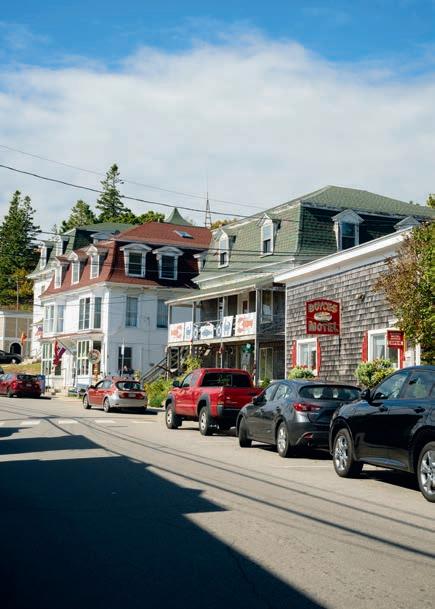
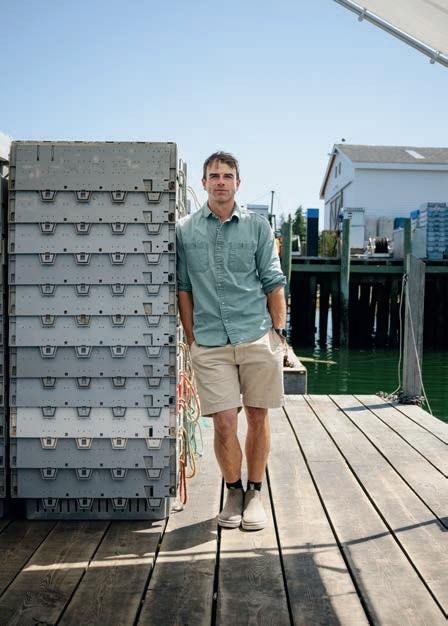


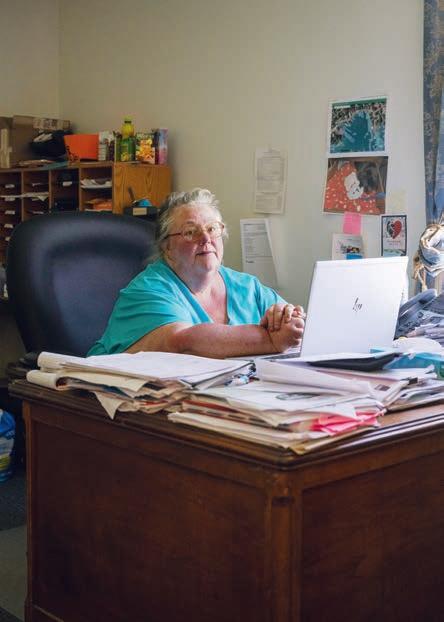
nearby, chatting with Casey Soper, a local bait dealer.
“I’ve not stopped this week,” Soper says. “Spruce Head three times. Rockland three more times. Boothbay. All over. I’m running bait everywhere.”
“At a high price,” says Mike, with a laugh.
“Goddamn right!”
Mike turns his attention to his son. “Hey, Robbie! Grab another fish box in the back of Casey’s truck.”
Eaton lifts out a final batch of bait and climbs down to his boat. Soon, he’s cruising the still waters of Stonington Harbor under a streak of sun that has finally broken the clouds. The two older men take in the moment.
“I’m staying put today,” Mike says, as his eight-weekold black Lab climbs over his lap. “I’m just going to play with her. I’m sort of semi-retired at this point.”
“More like just tired,” Soper cracks.
Even amid the men’s banter about this year’s incredible pogie run, and chopping it up over Mike’s father’s oncedominant lobster boat racing (“He had big horsepower and the balls to drive it,” Soper recalls), more serious topics can’t be avoided. A decade ago, Mike was regularly fishing six days a week, hauling 800 traps. Today, he’s reduced his schedule by a third and cut his trap load to 600.
“Honestly, I hate lobstering,” he says. “It’s become such a cutthroat business. The price of bait is high. Fuel is high. And the atmosphere around it has changed. People have gotten greedy.”
Soper jumps in. “How long have you been on your own?”
“Thirty-five years.”
“And how much has the price of lobster changed in those 35 years?” (Though the figure has, in fact, gone up and down over that time, Soper’s point is well taken: In 2023, the most recent year for Maine’s catch data, lobster averaged $4.95 a pound—a little over 30 cents more than what it fetched in 2005.)
“Everything else has gone through the roof,” Mike says. “We can’t set our own prices, because it’s considered price fixing. If you said, ‘I’m not selling my lobsters for that amount,’ the buyer would just say too bad and go on to the next boat. But then when the pandemic hit, it got to be $8 a pound. They showed their real hand.”
These are hard facts that complicate what Mike wants for his son, Robbie, and his older daughter, Sara. Both are committed to making their living on the water. But perhaps for the first time in the family’s long Stonington history, the older generation would prefer the younger one didn’t follow in its footsteps.
“It’s not like you get to really enjoy your time on the water,” Mike says. “You have to fish hard all summer and through the fall just to make it through the winter. When I look at the kind of future my kids may have, I’m not sure they have one.” He sighs. “But it’s all they want to do. There’s no sense in talking to them about doing something different.”

In one of the last working fishing ports left in the Northeast, the very identity of Stonington is being put to the test in both familiar ways and new ones. By a housing shortage and the increasing real estate prices it helps fuel. By wealthy second-home owners. By climate change. So, what becomes of a community when its core industry can no longer support the families that depend on it?
“I have nothing against a place like Boothbay, but when you go there it’s not even the same place that it used to be,” says Stonington’s longtime town manager, Kathleen Billings. “Same thing with southern Maine. Did [a tourist economy] really benefit Maine much? I just don’t think it did. When you start losing your natural-resource-based economies, you lose so many other things, whether that’s inland or on the ocean. I think Maine needs to take a really hard look at itself and decide if it still wants to be Maine or Vacationland.”
∂
For much of its existence, Stonington’s remoteness has been more of a virtue than an impediment. This is not a town you just stumble across. Three hours north of Portland and 60 miles from I-95, Stonington sits on the southern half of Deer Isle, an island about two-thirds up the Maine coast and the gateway to Merchant’s Row, an expanse of water running five nautical miles long and one of the centerpieces of Maine’s $400-million-a-year lobster industry.
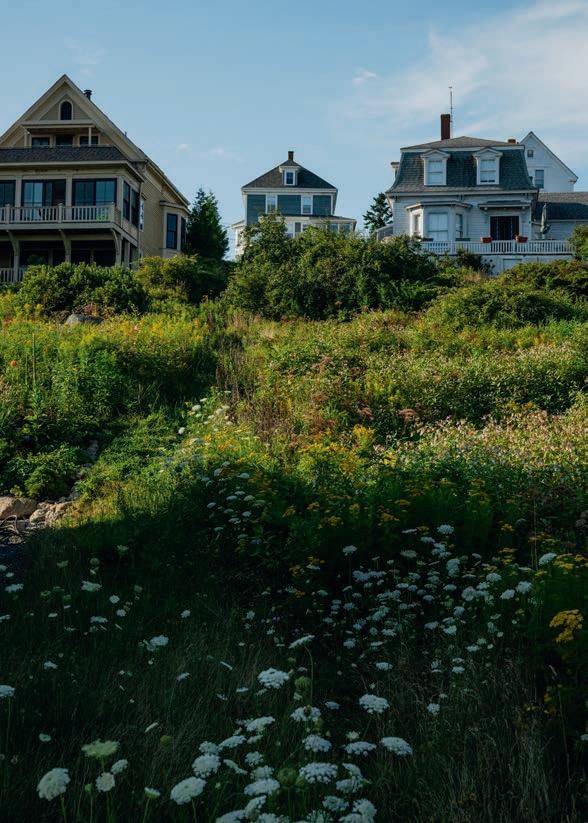
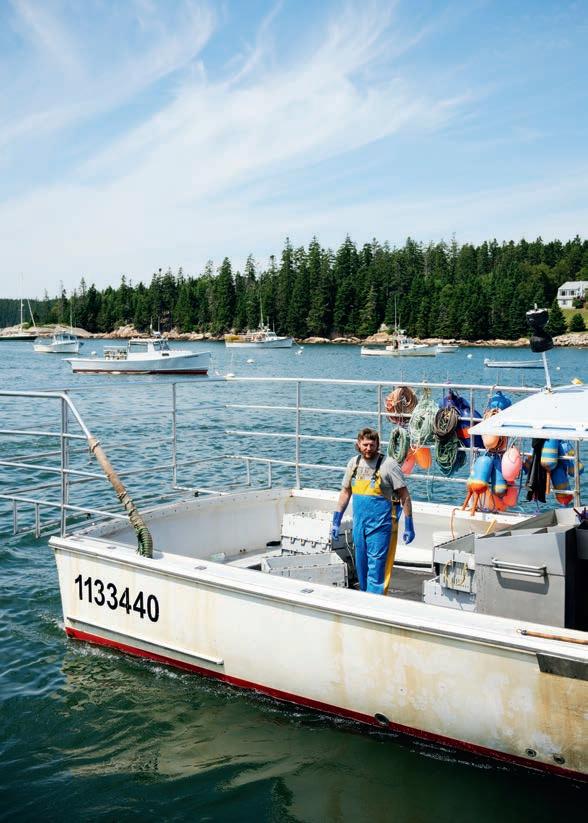
“Being nestled between Bar Harbor and Camden, we often get skipped over,” says Travis Fifield, a town selectperson and the fourth generation to run the family seafood dealer, Fifield Lobster Co. “You figure when it comes to a coastal town this pretty, you’re going to drive down a Main Street filled with gift shops and bright signs. But it’s really unexpectedly quiet and it feels manageable. At times, when you’re driving around, you’re on this remote stretch by the water and it can feel like you’re at the edge of the world.”
In recent years, though, that allure has reached a broader audience, and Stonington’s rising profile has affected who can now call it home. Median house prices, fueled by the weekly-rental market and second-home ownership, have shot up to over $400,000. The lack of affordable housing has gnawed at the community’s very ability to sustain itself: Contractors are starved for local plumbers, electricians, and carpenters. The local schools struggle to retain teachers. Meanwhile, the predawn hours bring a steady stream of commuting lobstermen from the mainland.
On a prime summer morning, often as early as 3 a.m., Richard Turner Jr. is a part of that commuter traffic. During my first visit to Stonington in 2003, I spent a full day on the water with Turner, then 36, and his father, with whom he’d worked since age 13. Turner spoke with awe of men like his father, hardworking captains who’d built
With so much of Stonington’s income dependent on the sea, what’s at stake is not just a single industry, says town manager Kathleen Billings, but a community’s whole way of life.
successful lives and raised families doing the only thing they ever wanted to do. “All my heroes were fishermen,” he told me then. “Sometimes I wish I had done something else, but as a kid I couldn’t stay off the water.” He was skeptical, however, that the same life his father had forged would be accessible to him. “In 20 years, I don’t believe working people, normal people, will be able to afford to live here,” he said.
He had no idea how right he’d be. He’s 56 now, and in the warmer months he lobsters with his cousin, Hilton, before hooking on with a scallop boat in the winter. For the past several years he and his girlfriend, Faye, have split their time between two locations: Stonington in winter, when rentals are less expensive, and a mobile home park in Orland, a good 50 miles from his hometown, in summer.
Orland is where I meet Turner on an early June afternoon. It’s been just a few days since he moved from Stonington, and he is still settling into his summer routine. We sit at a picnic table at the mobile home park, and as we talk, Turner, a gray baseball hat perched atop his head, picks away at a pack of Montego Reds.
“I miss the salt, I miss seeing Isle au Haut,” he says. “Don’t get me wrong, it’s pretty here. We can walk to a lake from where we are, but a lake doesn’t do much for me.” Turner raises his hands and holds them a foot apart. “I’m not interested in catching fish this big. I used to catch sharks as big as this table. You see these guys posting a pic of themselves on Instagram holding up a brook trout and I’m like, I’m proud of you, buddy, but to me that’s just not exciting.”
Health issues have slowed Turner down over the years, and he fears that he may only have another season or two in him. “I just can’t keep up with things the way I used to,” he says. “I’m getting slower. My reactions are slower. My eyesight isn’t what it was, so I miss things. You gotta be in your 20s to be doing what I’m doing. Every second
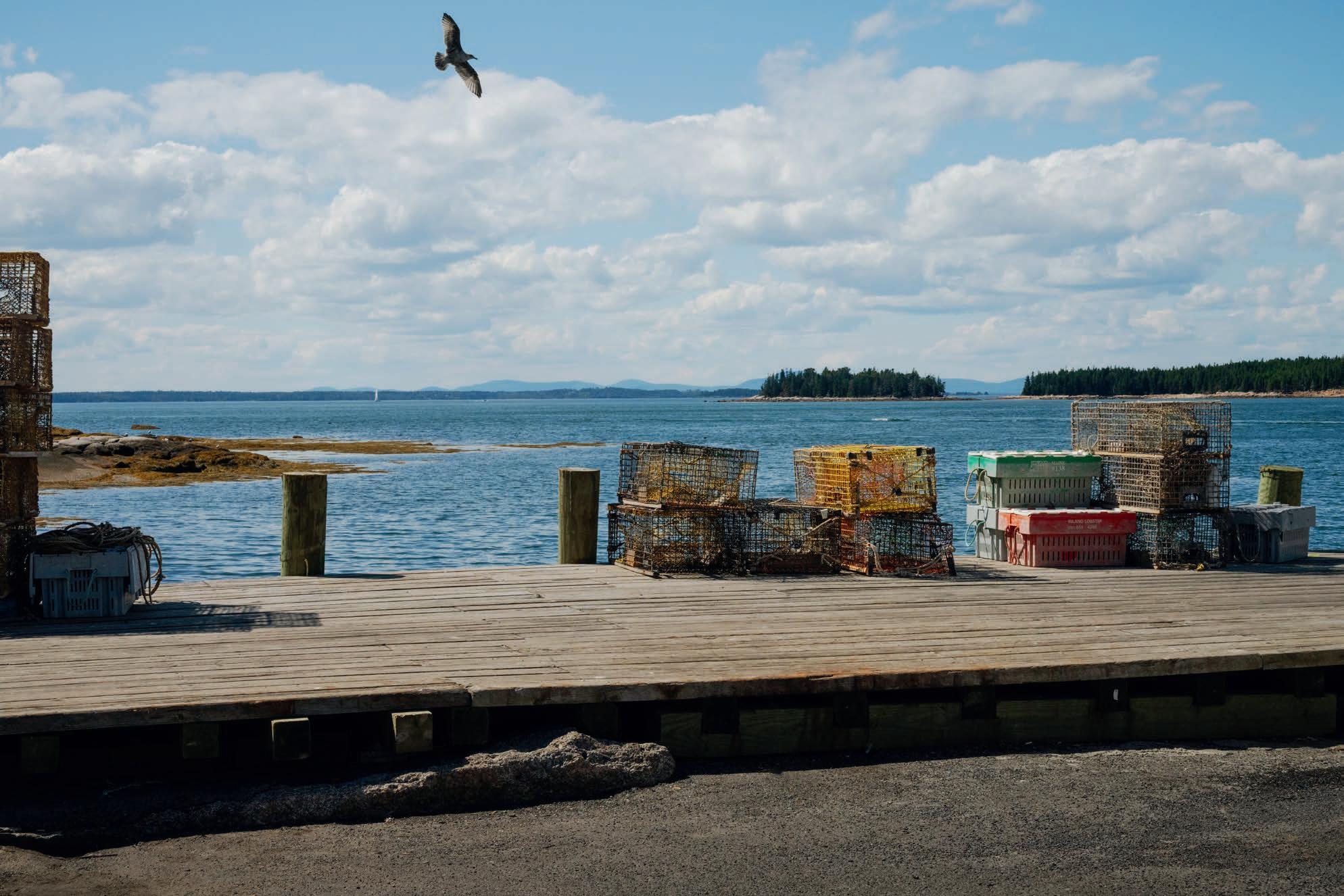

counts—and if you step in the wrong spot with the rope, you’re in a mess.”
Turner has mixed feelings about what’s happened to his hometown. In part, he feels like a casualty of its success— that in missing out on the early years of a lobster boom that began to take off in 2009, he missed the opportunity to create his own nest egg. An influx of younger lobstermen and people “from away” means he also doesn’t recognize many of the faces in town.
But as Stonington has built and attracted fortunes, he also sees a town that looks prettier and more upscale than it used to. Main Street has a few new restaurants, the Opera House theater has been refurbished, and many of the homes don’t appear as tired as they once did.
“When I was a kid, a family would fight over who would get the house after someone died and it would sit empty for a bunch of years,” he says. “Now those houses are fixed up. I think it’s been pretty positive for the town.”
As someone who’s always called Stonington home but now can’t afford to live there, Turner is remarkably sanguine. He recalls a piece of fishing advice he received years ago from an old-timer.
“I had this place where I was catching a lot of scallops, and one day after I’d been off the water for a few days, I went back and didn’t catch a thing,” he says. Turns out, the few friends he’d told about the spot had gone and cleaned it out. “This guy just told me, ‘It’s eat or be eaten. Don’t take it personal.’ And it’s the same thing with this housing market. Hey, if I could have afforded [the houses in Stonington], I’d have bought them up, too. Maybe I’d have bought every last one of them. Who am I to complain?”
Latin pop music blares from a speaker as Tyler Cousins motors his boat, the Breezy Dawn , to the docks of Stonington’s largest seafood dealer, the Lobster Co-op. Waiting for him are three men from Puerto Rico who had traveled north for the $18.50-an-hour jobs that Maine twentysomethings no longer want to fill. The trio includes a 32-year-old nurse named Luis, a new father who says the pay is better than anything he could earn back home at a hospital. “Maine is beautiful and I like the work,” he tells me. The men arrived in May, live in housing right on the dock, and will return home in December.
Cousins bops his head to the music as he powers his boat down. It’s still early in the lobstering season, and the 36-year-old Stonington native is taking the day off after hauling in a few hundred pounds yesterday afternoon. Though his head is shaved, he sports a long beard, and he wears camo shorts, a red T-shirt, and a pair of sandals that do little to slow him as he moves briskly around the boat’s stern, offloading empty traps. At the same time,
(Continued on p. 108)












On April 12, 1934, Mount Washington was slammed by winds that set a jaw-dropping world record. Nearly 90 years later, one writer ventures to the summit to discover what that might have felt like.
BY RACHEL SLADE
ount Washington stands only 6,288 feet high, yet it’s said to have claimed the lives of more people per vertical foot than any other peak in the world. Set in the heart of the White Mountains region of New Hampshire, Mount Washington sees often-violent shifts in temperature, precipitation, and wind, making it exceedingly perilous. Dawn might find the peak calmly welcoming the sun’s warmth; by noon, fierce wind might rush up its slope every minute, carrying ice-laden clouds so thick that visibility nears zero.
Mount Washington’s notoriously changeable climate, however, makes the summit an ideal location for studying the wonders of our restless atmosphere. And in 1934, three men stationed there were doing just that when they experienced some of the most extreme conditions ever recorded.
The country was still in the depths of the Great Depression when Salvatore “Sal” Pagliuca, Wendell “Steve”
solid, such as the cup of an anemometer, or an antenna, or a scientist’s beard. The water molecules crystallize, accreting into dainty spears that point accusingly in the direction of the wind. Weighted with rime and pummeled by hurricane-force gusts over long periods of time, meteorological instruments break, freeze up, fly away. Even today, the observer’s job includes breaking the ice with a sledgehammer if necessary, and sometimes hourly under the most challenging circumstances.
In 1934, just as today, there was always something to fix or tweak on the mountaintop. Fresh from earning his engineering degree, Stephenson was a born tinkerer who earned his keep fixing anything and everything. McKenzie, meanwhile, was a recent Dartmouth grad who developed some expertise working the complex radio equipment of the time, as maintaining communication with others in the region was a key feature of the weatherreporting operation.

Stephenson, and Alexander “Mac” McKenzie accepted the $5-a-week job of monitoring the wind, rain, and snow atop Mount Washington while sharing a small timber-framed cabin literally chained to the rocky peak. Pagliuca, a former electrical engineer with GE who had emigrated from Italy, led the effort. He spent his time carefully calibrating and recalibrating their anemometer, which was customdesigned to withstand the elements. Even so, the instrument, set on the roof of the cabin, needed constant care.
The biggest obstacle was rime ice, a phenomenon that transforms the barren summit of Mount Washington into a fantastic frosted confection. Rime occurs when supercooled water molecules carried by the wind hit something
These being hard times, the trio would have been satisfied to have a bed, a roof, food in their bellies, and meaningful work. But they were also experienced mountaineers, drawn to the edge of life where beauty and death intensify each other. They were eager to test themselves in the unforgiving climate of Mount Washington.
ALMOST 90 YEARS LATER, I DECIDED TO immerse myself in that same environment. I headed to Mount Washington from Boston on April 11, 2023. I chose the date because it was on the next day in 1934 that the three weather observers atop the summit recorded the highest wind speed on earth, an astonishing 231 miles per hour. It was a record that would not be broken for another 62 years, and still remains the fastest wind ever observed at a staffed weather station.
In hopes of experiencing something like that myself, a ferocity of wind I had never known, I would be spending the night at the Mount Washington Observatory (MWOBS). Unlike the 1934 trio, I’d be living in relative luxury in a bunker-like reinforced-concrete structure built in 1980 with modern conveniences. Having timed my excursion with the weekly observatory shift change and reprovisioning, I would reach the summit in a snowcat with three weather observers fresh from a week off, plus a married couple who had volunteered to prepare all the meals for a few weeks.
The observatory was having a banner year for extreme conditions. Two months earlier, on February 4, the temperature dipped to 47 degrees below zero, matching a
(Continued on p. 112)


More access to best-in-class healthcare services
More opportunities to live well.
More experiences to enhance your quality of life.
More possibilities to try something new.
More freedom to live life on your terms.
More support to meet your changing needs.
More care delivered with compassion and expertise.


More comfort in a place you’ll love to call home.
More assurance knowing help is always close by.
More time to focus on what matters most to you.



Give your loved ones the exceptional memory care they need with the comfortable, yet stimulating, lifestyle they deserve at Kimball Farms Life Care. Our residents enjoy expert, personalized support alongside opportunities to soak in the


Quarry Hill offers it all: a gracious, maintenance-free home with easy one-floor living and priority access to the fullest spectrum of care.
Enjoy all the beauty and cultural sophistication of Camden, Maine and discover your best future.








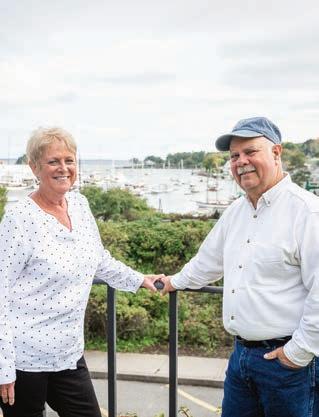







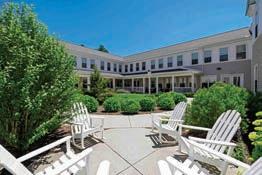

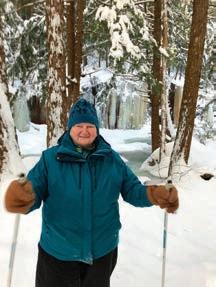

(Continued from p. 44)
and Essex, Massachusetts, where excellent littleneck clams grow in the nutrientrich mud flats and estuaries of the Great Marsh. Michael is an avid cyclist, and when he opened his Boston restaurant, Little Whale, as an ode to New England clam shacks, he found inspiration for his recipes while riding his bike on the North Shore, home to the Clam Box in Ipswich and Woodman’s in Essex.
Note: This recipe calls for 50 littleneck clams, which happens to be the number found in most bags sold at supermarkets and fish markets. There’s no substitute for the flavor you get from steaming clams in white wine, rather than buying a package of pre-shucked clam meat.
Kosher salt for the boiling water, plus more to taste
2 cups dry white wine, such as pinot grigio
50 littleneck clams, washed
3 tablespoons extra-virgin olive oil
12 medium garlic cloves, thinly sliced
4 tablespoons salted butter, divided
1½ pounds linguine pasta
Zest of 1 lemon
2 tablespoons fresh lemon juice
½ cup lightly chopped fresh parsley
2 sprigs oregano lightly chopped (dried or fresh)
Freshly ground black pepper, to taste
Crushed red pepper flakes, to taste
Chopped parsley and clam shells, for garnish

Set a large pot of salted water (2 tablespoons for every 6 quarts) over high heat and bring to a boil.
Meanwhile, put the wine and clams in a large Dutch oven. Cover and set over high heat. Bring wine to a boil, then reduce heat to a simmer and steam the clams until they pop open, 5 to 7 minutes. (To avoid overcooking, keep a close eye on the clams and transfer
them to a bowl as they open.) Remove the last clams from the pot, then strain and reserve the liquid, avoiding any sand at the bottom of the pot. Remove the clam meat from all but 10 of the shells (reserve those for serving). Chop the clams very lightly, as you still want big pieces.
Set a large (14-inch) skillet over medium heat and add the oil. Add the garlic and sauté until it just begins to turn golden. Add 2 tablespoons of the butter, melt, then add 1 cup of the reserved clam broth. Simmer the broth until reduced by half, then remove from heat.
Cook the pasta in salted boiling water according to package instructions until it is still firm in the center. Add the pasta to the pan with the garlic over medium-high heat, along with about ¾ cup of the cooking water. Simmer until slightly reduced, then add another cup of the reserved clam broth. Continue to cook until the pasta is just tender and the broth is fairly thick (add the remaining clam broth as needed). Now stir in the remaining 2 tablespoons butter along with the lemon zest and juice, parsley, and oregano. Add the black pepper and crushed red pepper flakes






























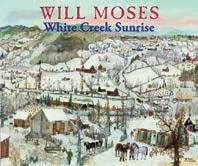

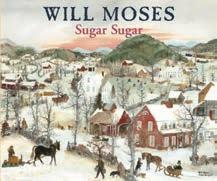



to taste. Add kosher salt if needed, then toss the pasta. The sauce should not be watery, but wet enough to coat all the pasta well.
Sprinkle the clams over the pasta and let them briefly warm. I like to serve the pasta right from the skillet, decorated with a light shower of parsley and accompanied by the reserved clam shells, but you can also plate the pasta individually. Yields about 6 servings.
To pull off the kind of clambake that chef Jennifer Backman and her team prepared for us at Newport’s Castle Hill Inn, you need a fire pit, mounds of lobsters, clams, chouriço, potatoes, corn, and seaweed—plus a team of waitstaff trained in silver service, myriad side dishes, wine pairings, and a sunset to backlight the parade of sailboats drifting past Castle Hill Cove. If you don’t happen to have any of that on hand, you can enjoy the experience for yourself at the occasional clambakes that the inn offers to the general public each summer (call for reservations). Short of that, keep an eye out for the Castle Hill Inn segment on season 9, and make yourself a pan of chef Backman’s fantastic cornbread to go with it.
2 cups buttermilk
1½ cups medium-grind cornmeal
1¾ cups all-purpose flour
2½ tablespoons baking powder
1½ teaspoons salt
½ teaspoon baking soda
3 large eggs, lightly beaten
½ cup granulated sugar
½ cup brown sugar
¼ cup melted butter, plus more for the pan
Preheat your oven to 400°F and set a rack to the middle position.
In a large bowl, whisk together the buttermilk and cornmeal. In a medium bowl, whisk together the all-purpose flour, baking powder, salt, and baking soda. Add the dry ingredients to the cornmeal mixture and stir to combine. Add the eggs, granulated sugar, and brown sugar and whisk until smooth. Stir in the ¼ cup melted butter.
Brush a large (12-inch) skillet with melted butter and fill with the batter. Bake until a toothpick inserted into the center of the pan comes out clean, 20 to 25 minutes. Serve warm or at room temperature with butter and honey. Yields 12 servings.
GOULD HILL FARM’S APPLE CRISP
At Gould Hill Farm in Contoocook, New Hampshire, the apple crisp is made in such massive batches that I had to scale the recipe back by a factor of ten to make it suitable for the home kitchen. That’s because this farm boasts the most dramatic views of any apple orchard in New England, as well as more than 100 apple varieties, and draws large crowds throughout the season. Between the views, the fruit, the bakery (and cider doughnuts), and the on-site Contoocook Cider Company, this is a fall experience for anyone’s bucket list.
10 large apples
1½ cups all-purpose flour
1 cup rolled (old-fashioned) oats
½ cup granulated sugar
½ cup brown sugar
½ teaspoon kosher salt
14 tablespoons cold, salted butter, cut into small cubes
Cinnamon for sprinkling (optional)
Preheat your oven to 350°F and set a rack to the middle position. Peel, core, and slice the apples into ¼-inch-thick slices (an old-fashioned apple corer/ peeler is perfect for this). Pile the slices in a 9-by-13-inch baking dish.
In a large bowl, whisk together the flour, oats, granulated sugar, brown sugar, and salt. Sprinkle the butter cubes over this mixture, then use a pastry cutter or your fingers to work the butter into the dry ingredients until you have a sandy-looking mixture with pea-size bits of butter. Distribute the topping over the prepared apples and sprinkle with cinnamon, if using.
Bake until the top is golden brown and the apple juices are bubbling, 50 to 55 minutes. Serve warm, with a scoop of vanilla ice cream, if you’d like. Yields 8 to 10 servings.
“This is the second time I’ve purchased these sheets and they’re the only ones I’ll use. They are soft, lightweight & last & last. Nice investment.”
BENITA, SPRINGTOWN, TX




A-C |
Polyester microfiber is soft to the touch and
Machine wash. Imported. 24 colors. See BrylaneHome.com for extra deep sheet set in solids or prints.
A | SOLID SHEET SET 1580-10501-0838
Twin 39” x 76” 3-pc. set was 49.99 NOW 14.99
Twin XL 39” x 80” 3-pc. set was 49.99 NOW 14.99
Full 54” x 76” 4-pc. set was 59.99 NOW 16.99
Queen 60” x 80” 4-pc. set was 69.99 NOW 19.99
King 78” x 80” 4-pc. set was 79.99 NOW 22.99
Cal King 72” x 84” 4-pc. set was 89.99 NOW 24.99
B | PRINTED SHEET SET 1580-34584-0838
Twin 39” x 76” 3-pc. set was 54.99 NOW 16.99
Twin XL 39” x 80” 3-pc. set was 54.99 NOW 16.99
Full 54” x 76” 4-pc. set was 64.99 NOW 19.99
Queen 60” x 80” 4-pc. set was 74.99 NOW 22.99
King 78” x 80” 4-pc. set was 84.99 NOW 24.99
Cal King 72” x 84” 4-pc. set was 94.99 NOW 27.99
C | TAILORED BEDSKIRT 1580-10514-0838
Not available in prints. Twin 39” x 76” was









In April, it reopens after a brief winter’s nap. On your mark, get set, go! Instagram


collections of lighting, pillows, pots from Connecticut’s own Ben Wolff, and more. pergolahome.com
VIVID HUE HOME, Farmington. Preppy style is alive and well in this jaunty shop specializing in Palm Beach and Chinoiserie. Behind the fuchsia door is the curated lifestyle brand of Heather Grahling, who started as a blogger and soon knew from her devoted following that she was onto something. Coastal-grandmother types may want to keep walking, but if you’re looking to “live a vivid life,” as the shop’s tagline declares, you’ve found your design home. vividhuehome.com
WALKER LODEN, Madison & New Haven. This local chain of two stand-alone shops plus the Sandpiper Gift Shop in the Madison Beach Hotel has built a solid rep for carrying quality clothing, gifts, and antiques. Shelves are lined with a varied selection, including New England–based brands such as Chandler 4 Corners (Vermont) and Swedish Dream Sea Salt Soap (Rhode Island). Nuts about the Nutmeg State? Handcrafted mugs, T-shirts, and other items emblazoned with shoreline town names await. shopwalkerloden.com


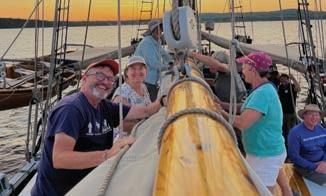

BLISS, Ellsworth. At this “creative lifestyle boutique”—a groovy retail space/studio where they also make soaps and lotions in-house—you’ll find T-shirts, jewelry, ceramic pots, air plant holders, and (insert record scratch) ukuleles! The music section has string instruments including guitars and banjos, plus accessories like strings, straps, and picks. Proud Mainers, they also carry assorted state-themed and locally made gifts. bliss93.com
CALLUNA FINE FLOWERS AND GIFTS, Ogunquit. It always feels—and smells—like springtime at this flower and gift shop, courtesy of owner Heather Battagliese’s weekly trips to the New England Flower Market. Alongside fresh posies and plants, discover an assortment of specialty items, whether they’re home and garden accents, jewelry, paper products, or signature offerings like their own room and linen spray. callunafineflowers.com
FARM + TABLE, Kennebunkport. Shoppers who enjoy a sense of place as much as what’s for sale can’t do better than this big red barn with a cherry-red pickup truck parked out front. Nestled in Cape Porpoise, a fishing village in Kennebunkport, the shop is a treasure trove of home goods and gifts from small-batch makers and creators.
HEARTH & HARROW, Camden. This artistowned shop in the heart of downtown is the outpost of Casey Everett, who in partnership with husband Michael (he runs the screen-printing) makes organic hand-printed tea towels and napkins at her Rockport studio in a big blue barn. If that isn’t dreamy enough, Hearth & Harrow also sells goods that pair with Casey’s simple aesthetic; find rows of glassware, pottery, and baskets while you contemplate moving to Camden. hearthandharrow.com
J.DECOR, Bridgton. Julie and Rick Whelchel describe their journey as business owners as “a dream to showcase the historic 1873 H.O. Moses Apothecary.” As mindful stewards of that architectural gem on the hill, they’ve created a shop whose identity takes its cue from the property. Their tagline of “Uncorked Style” is fitting, as the inventory is a thoughtful mix of furniture and home decor—often discovered during the couple’s travels—plus an array of wines. Cheers! jdecormaine.com
MAINESCAPE, Blue Hill. Suffering insomnia trying to locate Amsonia or on a mad quest for magnolia? Pregame a visit by using this nursery and garden center’s online Plant Library to assemble a list to bring along; staff will help track down your choices or suggest alternatives. This useful tool is among the many reasons that locals have trusted Don and Althea Paine’s growing business with their landscape essentials. Watch for special events held in the glass greenhouse. mainescape.com
THE MILL, Freedom. For fans of all things Erin French and the Lost Kitchen, there’s a way to experience her famed restaurant’s setting sans reservations lottery: shopping at the historic mill in which the eatery is located. Inside the cozy space you’ll find a range of carefully selected, on-brand products and provisions—jams and maple syrup, textiles, etc. And if you’re lucky, French herself may be there in her Breton shirt, ready to sign one of her books. findthelostkitchen.com
FLORA HOME, Dartmouth. Less than 15 minutes from New Bedford, the village of Padanaram is an IYKYK destination. Within a brief stretch this waterfront enclave has inviting places to eat and shop, including Flora Home. The atmosphere is that of an upscale department store’s home section, with displays of candles, books, and chocolates; cubbies stuffed with pillows; and stylish brands such as John Derian. flora-style.com/flora-home
GUS & RUBY LETTERPRESS, Boston*. Revel in springtime despite any fickle forecasts by festooning your mantel with a felt flower garland, hanging a brand-new wall calendar, and amassing a fresh stack of notepads. All these and more can be found at Gus & Ruby, a stationery store that also sells jewelry, body products, and garden-themed art prints. *Additional locations in Portsmouth, NH, and Portland, ME; store.gusandruby.com
LES FLEURS, Andover. Anthophiles and Francophiles, Les Fleurs est pour vous Twenty miles north of Boston is the Frenchinspired outpost of Sandra Sigman, floral designer and author of 2023’s French Blooms
A full-service florist, Les Fleurs has a home and garden section reminiscent of a Paris flea market, with antiques, paper goods, and more. lesfleurs.com
THE MAYFLOWER, Chatham . Since 1885, adults seeking refuge from family vacations on Cape Cod have fled to The Mayflower. Look for the green-and-white awnings on Main Street, and enter to find a warm hug of a store chock-full of home accents, gifts, hobbies, toys, and books. Folks still feeling the loss of wandering the Christmas Tree Shops will enjoy perusing in a similar way the higher-quality cornucopia here. themayflowershop.com
MORRICE FLORIST, Vineyard Haven
Established in 1940, Morrice Florist may be a Martha’s Vineyard institution, but it isn’t your nana’s flower shop. Since taking ownership in 2014, islander Emily Coulter has transformed the expansive property into a haven of serenity. Thanks to her eye for color and texture, you can find things like hand-thrown speckled stoneware mugs, signature Castile soap and bath salts, beeswax candles, and tablescape inspiration for days. morriceflorist.com
NUNAN FLORIST & GREENHOUSES, Georgetown. Once that first crocus sparks your annual springtime garden-center trek, make a full day of it at Nunan’s. This place has everything: a scratch-kitchen café serving a farm-to-table menu, an ice cream parlor, a mini golf course, a flower shop, a chatty Macaw named Jacob—and that’s even before mentioning the greenhouses. Delight in gifts, gadgets, wild-bird supplies, indoor and outdoor plants and flowers, and more. nunans.com
OAK + MOSS, Salem. When a shop uses the category “weirdo plants,” you know you’re sure to dig it. Oak + Moss is a must for plant parents and the people who love them. A short walk from the Witch History Museum, the bright green flags signal you’ve arrived. In addition to houseplants of all shapes and sizes, peruse quirky gifts like mini gnomes to keep your potted friends company. oakandmoss.com
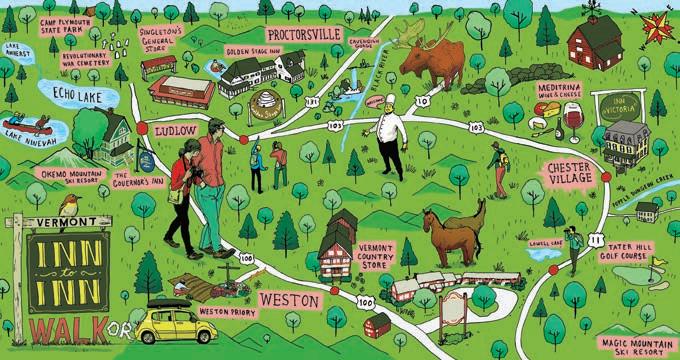
■ We transport your bags to the next inn.
■ Walking routes are on back-country gravel roads.
■ If the length of the route is too much for you, we are happy to give you a ride part way.
■ Drive the route if you wish . . . we’ll give you touring info.




ERIN CLAIRE, Dover. Like so many New England cities, Dover has a river running through it, with mill buildings turned mixed-use spaces, a growing culinary and arts scene, and cool shops like Erin Claire. Not far from the Cocheco River, the mission-based store is filled with quality products, many of which are either locally made or support a community or cause. Stunning stock organized by color makes it a breeze to find just what you didn’t know you needed. erinclairedover.com
FOREST + ASH, Exeter. What happens when two friends who also happen to be interior designers start a business together? You get a studio and shop with a fresh aesthetic that runs across both enterprises. A peek at the portfolio of New England homes designed by cofounders Robin Drunsic and Hanna Schaffer echoes the same subtle palette and clean lines of the brands they carry. forestandashdesign.com

Join Yankee travel editor
KIM KNOX BECKIUS for the

You and your BFF will enjoy an unforgettable, all-inclusive escape featuring healthy meals, spa services, activities, exclusive goodies, and luxury accommodations. Book now! CANYONRANCH.COM/BESTIE
LEMON TREE, Hanover. With its sunny shopgirl vibe and devoted clientele, Lemon Tree is one of those stores where being in a brick-and-mortar space is part of the fun. A mini department store, it’s a one-stop for gifts on the go—for babies, kids, women, men, and even fourlegged friends—with gift wrapping and shipping services, too. Located in the same town as Dartmouth College, it boasts plenty of NH-made home decor, too. joanna-revers-e1de.squarespace.com
PENTIMENTO, Littleton Housed in a great big 1884 Victorian, this boutique is where to load up on home and garden decorative accents, stationery (attention, Cavallini Papers & Co. lovers), and more. It’s the dream come true of Philippa Evans, who named the shop after the Lillian Hellman book, noting that it’s what she was reading when she met her husband (who can be found modeling goodnaturedly on Pentimento’s entertaining social feed). Instagram
VIKING HOUSE, Concord . Personality shines through every aspect of this store, which not only stocks goods from nearly a dozen countries but also plans and hosts trips! Whether or not you can partake in this spring’s visit to France and the United Kingdom, you can purchase European decor, toys (Maileg!) and games, and clothing and accessories. There’s even a grocery section to supply your cupboard with treats, no passport required. vikinghouse.com
WENTWORTH GREENHOUSES, Rollinsford
For more than 50 years, locals at the New Hampshire/Maine border have relied on this family-owned biz to help beautify their indoor and outdoor spaces with plants and herbs. The expansive property boasts
six-plus acres of production greenhouses, over 40,000 square feet of retail space, and bucketloads of friendly advice. Keep an eye out for crafty workshops and farmers’ markets, too. wentworthgreenhouses.com
DAISY DIG’INS, Barrington. When Lois Coppolino started her business in 1977, it was exclusively a flower shop. But when supermarkets started selling florals, she pivoted to expanding her inventory beyond blooms. Fast-forward to today, and the store has grown into two side-by-side spaces (and a discount shop a couple of streets over) brimming with everything needed to outfit one’s home and self, from tabletop to outerwear to personal gifts like jewelry and perfume. daisydigins.com
THE FARMER’S DAUGHTER, South Kingstown
Imagine an outdoor shopping village of greenhouses, each filled with plants, florals, gifts, pottery, or supplies, and all presented so beautifully that every turn elicits a gasp. This sprawling enterprise, owned by actual farmer’s daughter Sarah Partyka, is considered a happy place by many. Even those who can’t grow mold will leave inspired—and with a parcel or pot, to boot. thefarmersdaughterri.com
GRASMERE, Bristol. Jörg-Peter Gresch and Beth Siqueland-Gresch fill their brick-andmortar shop with items from independent artists and fair-trade makers sourced at U.S. and Northern European trade shows. Alongside houseplants and unique pottery are works from a who’s who of Rhode Island artsy all-stars, including Michelle Phaneuf (teeny bowls), Sema Gurek (jewelry), Meredith Brower (photography), and Holly Wach (paintings of birds). grasmeretheshop.com
THE GREENERY, Warren. When Bridget Tierney returned to Little Rhody from the Big Apple after working as an electrician for clients like MTV, little did she know when she bought a flower shop on a lark that she’d eventually celebrate 20 years in business, and then some. Originally in Scituate, Tierney relocated lock, stock, and bouquets to Warren in 2010. The retail space brims with fair-trade stationery, soaps, and gifts for gardenistas. thegreeneryri.com
GROUNDSWELL GARDEN + HOME/ GROUNDSWELL TABLE + PROVISIONS, Tiverton. When a shop describes itself as a “verdant haven for gardening enthusiasts and beginners alike,” aesthetes with green thumbs know they’re in for a treat. Groundswell Garden + Home will have shoppers swooning over its artful displays of utilitarian objects—e.g., heirloom seed packets arrayed in open drawers, parades
of plant misters, and more. Can’t find what you’re looking for? Step into Groundswell Table + Provisions, which specializes in home goods and entertaining supplies and, like its sister shop, reflects the refined tastes of its owners, landscape architect David Fierabend and his husband, John McDowell. groundswellguild.com NAVA, Providence. When you’re looking to make major design changes to your home, you head to a furniture store; when you just want to zhuzh things up for spring, you head to an indie like Nava. This charming mainstay on eclectic Wickenden Street has assorted gifts, all picked by tasteful owner Ali Burns-Nachwalter. Signal spring with a pack of floral facial steams, flower tea, flower exfoliant, or glass tumblers with blue flowers. shopnava.com
ADDISON WEST, Middlebury & Waitsfield Monique “Mo” Bonner long dreamed of owning her own business, but it wasn’t until a pandemic-propelled pivot that she traded her career as a marketing exec for being the proprietor of a home and lifestyle store. Today there are two locations of her
stylish creation, Addison West: the Stone Mill Public Market building in downtown Middlebury, and the flagship and design center in Waitsfield. theaddisonwest.com
GOLDEN HOUR GIFT CO., Burlington, Colchester & Winooski. Naming a shop after the most glorious part of the day shines some light onto the aesthetic of this mother-anddaughter-run business. Staying true to their tagline of “brighten your day,” Nicole and Lyn Carey stock the shelves with everything from the artisanal to the whimsical, and even devote a section to Swifties. Look for staff picks and Vermont-made goodies at all three locations. goldenhourgiftco.com
HOME & GARDEN VERMONT, Burlington. The sight of the brick facade with architectural details may cause a flutter even before you’ve stepped inside this quadruple threat stocked with fresh flowers, home goods, gifts, and souvenirs. Southerners will be delighted to learn that H&G was founded by Jack and Jana Qualey, who opened the Bluffton General Store in South Carolina before moving to the Green Mountain State to be closer to their family. homeandgardenvermont.com
MAGPIE & TIGER, Montpelier. The sweet spot of this “modern mercantile” is cool office
stuff. Whether it’s a sleek stapler or writing instruments from Japan, stationery fans are sure to enjoy perusing what’s on offer here. The “Magpie” comes into play with a steady stream of antique and vintage finds making their way onto the sales floor—and since you just might leave with an antique typewriter or vintage chair, plan accordingly and clear the trunk. magpieandtigervt.com
THE ROOTS FARM MARKET, Middlesex . Let your nose lead you to fresh produce from local growers, fragrant blooms from nearby von Trapp Flowers, and hot-from-the-oven baked goods. Along with commodities from 120-plus regional producers, makers, and artists, check out the grab-and-go dinners. Did we mention the cheeses, wines, and gifts? therootsfarmmarket.com
SHACKLETONTHOMAS, Bridgewater. Charles Shackleton is a furniture maker and designer; Miranda Thomas is a potter. Together, the industrious couple founded ShackletonThomas, a combined workshop and retail space in the sleepy town of Bridgewater. In addition to their own handiwork, available in a range of sizes and price points, fine wares from friends and similarly minded brands are for sale. shackletonthomas.com



(Continued from p. 83)
Marquis de Lafayette, hero of the Revolution and “Guest of the Nation,” visited twice on his triumphal tour of America in 1824 and 1825. The Frenchman was greeted everywhere with parades, banquets, and toasts. Temporary arches were erected for him to parade under. Temples were built out of flowers. Old veterans came forth to be greeted and embraced; Lafayette remembered their names. Congress granted him $200,000 in stock ($6.5 million today) and an entire township of land. He was the last living general of the Continental Army, the last living link to George Washington. He visited Mount Vernon and exited Washington’s tomb in tears. We have no comparable heroes.
Lafayette’s tour revived interest in honoring the Revolution by saving Independence Hall (it had been partially demolished, and the rest threatened to come down) and preserving the battlefields at Yorktown and Bunker Hill. His first visit to Bunker Hill was emotional, said witnesses. “Sir, I tread this holy ground,” said Lafayette, “where the blood of American patriots … early and gloriously spilled, aroused the energy of three millions, and secured the happiness of ten millions, and of many other millions of men in times to come.” In Paris, Lafayette’s coffin is surrounded by soil gathered from this battlefield.
To consecrate this “holy ground,” Lafayette returned to lay the cornerstone for the monument, even though there was no design yet and the foundation would wait another two years. Almost 100,000 turned out—double Boston’s population at the time. As Lafayette rode in a long parade, his passage was marked by the crowds on the street, in windows, on roofs and chimneys, waving white handkerchiefs. Lafayette’s tour had relieved the country from a fractious presidential campaign. “All the discord” was forgotten, said James Fenimore Cooper, “and nothing was thought of but Lafayette and the heroes of the Revolution.”
leaders of the militia, and conclude by pointing the way to the years of fighting to come.
Day after day they build the monument. They do what the 7,000 tons of granite piled up in the obelisk can’t do: They tell a story. “My grandparents came from Ireland,” says Hannigan, “and a saying in Ireland is ‘The dead are only dead if we stop talking about them.’”
THE LOSSES WERE AMONG
When the Bunker Hill Monument was finally dedicated in 1843, Daniel Webster, the great orator and statesman, said it had one meaning. It stood for “one country, one constitution, and one destiny.” That was the wish; that was what these Americans, in the decades before the Civil War, were trying to conjure. Webster’s sentiments, it was said, were “the very household words of a nation.”
The monument’s architect got the first—and really the last—word on his design. Horatio Greenough was a Harvard student barely in his 20s when he entered the competition to design the monument. Among the 50 entries there were many towering classical columns and columns with urns, but Greenough chose an obelisk, an Egyptian form considered the proper way to proclaim the eternal memory of the dead. He would go on to study in Italy, becoming America’s first sculptor. (His Washington statue, exposing the founding father’s torso, was scandalous.)
Several days a week in the summer season, hourly from 11 a.m. to 3 p.m., visitors gather in front of the monument to hear a park ranger talk about the “Decisive Day.” The rangers will talk to two people or 200—no matter. They will welcome the group by asking where they’re from, then deftly sketch the prelude to war, the costly battle, and what it all means. They will set out a battlefield map, and a map showing the shoreline of colonial Boston. Talking for just a few minutes they will build a timeline, introduce some of the
Greenough’s design, as built, is spare—there are no names, no laurels in stone, no urns, no statues or busts. The Bunker Hill Monument Association considered adding names but decided that plain stone was a better collective tribute: All the soldiers, living and dead, were united in one cause, the new republic, out of many, one.
Greenough said, “The obelisk has to my eye a singular aptitude in its form and character to call attention to a spot memorable in history. It says but one word, but it speaks loud. If I understand its voice, it says, Here! It says no more.”
The Bunker Hill Monument just marks the spot—Here. It doesn’t tell us what to think, or even offer a line of narrative. The story of Bunker Hill and the Revolution has to be earned, in each generation, just as David Hannigan’s father taught him, step by step.
MASSACHUSETTS 250: While America’s much-anticipated 250th anniversary doesn’t arrive until July 4, 2026, the birthplace of the American Revolution has already kicked off the celebration. Throughout this year and next, the statewide initiative Massachusetts 250 will highlight the Commonwealth’s central place in the founding of our nation, commemorating the Revolutionary War through hundreds of cultural and community events ranging from the Berkshires to the Cape & Islands. To learn more, go to: massachusetts250.org







Never touched a trowel in your life? Been gardening at home for decades? Gardeners of every skill level always bene t from having trusted knowledge at their ngertips.
Never touched a trowel in your life? Been gardening at home for decades? Gardeners of every skill level always bene t from having trusted knowledge at their ngertips.
The Old Farmer’s Almanac’s Gardener’s Handbooks are loaded with advice and inspiration to guarantee success for every gardener.
The Old Farmer’s Almanac’s Gardener’s Handbooks are loaded with advice and inspiration to guarantee success for every gardener.

• step-by-step guidance on growing more than 30 vegetables or flowering plants
• step-by-step guidance on growing more than 30 vegetables or flowering plants
• planning advice to minimize maintenance and maximize harvests, color, and fragrance
• planning advice to minimize maintenance and maximize harvests, color, and fragrance
• pages for notes and records
• pages for notes and records
• tips for seed-starting and best timing for transplanting
• tips for seed-starting and best timing for transplanting

• the lowdown on disease and pest prevention (and, if necessary, how to combat)
• the lowdown on disease and pest prevention (and, if necessary, how to combat)
• fun and informative anecdotes from fellow gardeners
• fun and informative anecdotes from fellow gardeners
• charts and tables for ready reference
• charts and tables for ready reference
• and much more to help you achieve the gardens of your dreams!
• and much more to help you achieve the gardens of your dreams!
(Continued from p. 91)
he’s coaching one of the dockworkers, John, who’s still learning how to use the motorized lift that transfers the traps onto a trailer.
Cousins watches one trap dangle in front of him. “You take my teeth out and I won’t be happy,” he tells John, and laughs.
Several minutes later, Cousins is back behind the wheel of his boat to make the slow, short motor through the harbor to fuel and bait up for tomorrow’s run. In a town where a lobster license is practically a birthright, Cousins learned his trade at the hands of his grandfather, Dick Bridges, who was running his first boat before the age of 10 and even now, at 80, still fishes every day.
Despite Cousins’s best efforts to leave lobstering behind, “I realized early on that living on land, getting a paycheck, dealing with people— that wasn’t for me,” he says. “I went to school for hydraulics and diesel mechanics and even moved out to San Diego at one point and worked at a marina: lived on a boat, had a great life, but I was bored. I came back.”
He slows as he approaches the bait dock. “I like the chaos of never knowing if the job is done. Everything is up in the air: the weather, the lobsters, the mechanics.”
Gliding to a stop, he looks up at the two men on the dock. Both are familiar faces. “You got anything special?” he barks.
They drop down six 40-pound bags of frozen redfish. “You sure you can lift those bags in front of your friend?” teases one of the workers. Cousins smiles, waves him off, then rumbles over to the fueling station. That’s $188 for the bait and another $667 in diesel.
“The expenses pile up fast,” says Cousins. “During the heat of the season, you can be up around a grand a day. But I haul alone, so the good days are really good. I can’t haul as much as I’d like, but I don’t have the headaches of teaching someone the system
or the problems of just working with another person.”
He cocks a grin. “And to do the same job others do with two people, that makes me kind of a badass.”
Cousins is at an interesting point in his life. He’s not so old that he can’t just break off and start a new career. He’s watched friends leave lobstering for good and heard others talk about doing the same. But just as quickly as doubts begin to enter his mind, they go away.
“I’m building a business,” he says. “And I’m getting better at it every year. There are lobsters out there. There are always lobsters out there. You just need to know where to look to find them.”
In mid-January of 2024, back-to-back nor’easters clobbered Stonington. High winds, heavy rain, and a rarely seen high tide wreaked havoc on the waterfront, pulling wharves from pilings, hurling debris out to sea and
Services, all in the name of addressing what had happened and accounting for what could happen next. The uncertainties unleashed by climate change leave no other options. Unless, of course, Stonington ceases to be Stonington.
“People say, ‘Well, just retreat,’” Travis Fifield later told The New York Times . “We can’t retreat. We have to be here.”
Stonington town manager Kathleen Billings was at her home in North Deer Isle when the first and more powerful of the two storms rolled up early on the morning of January 10. “Everything got racked,” she says. “That surge came in and tore all the docks up. It was just devastating, but I also think it opened the eyes of a lot of people that these kinds of storms are real.”
Building resiliency is layered into every part of Billings’s job, and her office reflects the different projects
“People say, ‘Well, just retreat,’”
Travis Fifield told The New York Times. “We can’t retreat. We have to be here.”
onto land, and flooding roads, businesses, and homes. Down at the town fish pier, assistant harbormaster Dana Webb watched as a four-foot wall of water rushed past his office building, flinging a boat onto the landing and relocating a pair of dumpsters. The pier’s main generator was swallowed whole by seawater.
Elsewhere in town, the waterfront’s electrical system was wiped out, while the Deer Isle Causeway was submerged by 18 inches of water, isolating islanders from the mainland. Private businesses also took a beating. At Fifield Lobster Co., a wharf that had been raised and rebuilt just two years earlier was overtaken by stormwater and had to be reset. Across Stonington it was much the same, with upgrades and rebuilds slated for the docks at both the Lobster Co-op and Isle au Haut Boat
that compete for her time. Desks and tables are stacked with blueprints, maps, and memos. There are grants to complete, project bids to pore over, and a schedule of meetings that at times can feel relentless. “It can be a lot,” says Billings, who has worked for Stonington since 1997 and been its town manager for the past 18 years.
Billings’s family were among Deer Isle’s original European settlers, and today their name is etched into various parts of its economy—notably Billings Diesel & Marine, one of the biggest full-service boatyards between Boston and Nova Scotia. But Billings’s perspective on her hometown isn’t colored by nostalgia. She speaks in meaty paragraphs about the toll that federal regulations have taken on the local fishing economy and the threats it also faces from climate change and cost of living.
Few Maine towns of this size have been as proactive around these issues as Stonington. Over the past year, Billings’s office has spearheaded town discussions about workforce housing, sea-level rise, land management, and aquaculture. A recently established town-administered resiliency fund uses donations from seasonal residents to purchase private waterfront and make it accessible to fishermen. Restrictions on short-term rentals earned voter approval in 2023, and even before last January’s storms, plans were drawn up to raise the fish pier.
With so much of Stonington’s income dependent on the sea, what’s at stake is not just a single industry, Billings says, but a community’s whole way of life.
“We are a fishing town, and it’s important we maintain that—not just for the fishermen but for everyone else who benefits from it,” she says. “But we only have so much working waterfront, and with the sea-level rise and the storms, how many times do you think these guys can rebuild? Once that waterfront goes to hotels and restaurants, you’re never going to get it back. It’s gone forever.”
And what fills that void, says Billings, is not a one-for-one replacement. A viable Stonington, she argues, is not a tourist-heavy Stonington, whose harbor is stocked with pleasure boats and an economy that relies on a 12-week window to make most of its money.
“I’m all for diversity, but I don’t think a seasonal economy is the answer,” Billings says. “It’s really hard to have stable families, to have a school and other businesses that can subsist and spin off from that. I know some people don’t always see it that way. But if we are going to stay a strong community, we need to sink our teeth into year-round jobs that can help people.”
Whether those year-round jobs can reliably be built long-term off or around the lobster industry is another question. In 2021, Stonington pulled in a record-setting $76 million worth of lobster—nearly $21 million more than Maine’s next-largest port, Vinalhaven—undergirding the state’s record haul of just over $724 million. But
those numbers are seen as an anomaly. A near-decade-long boom that began around 2009 has given way to a series of uneven years.
“We have seen a decrease, but I’m not sure you can say that’s a biological signal yet,” says Carla Guenther, chief scientist for the Maine Center for Coastal Fisheries in Stonington. “We’ve had a lot of demographic changes in the fishery and how the fishermen are participating [in studies]. But there’s definitely been a slowing of the catch. There was a time when you pretty much couldn’t avoid catching lobsters. You’d pull up a trap and it was full. But you talk to the experienced lobstermen and they’d say, ‘What goes up must come down.’ For others, the thought was, Let’s just ride this high.
“I wish we’d asked as a community if this boom was real,” she says, “because I think there may be a breaking point.”
Michael Joyce is hedging his bets against whether that breaking point might come. He’s 21 and, like Robbie Eaton, grew up here and hails from a long line of fishermen. But he hasn’t staked his future to the water. Instead, he completed an HVAC degree from Eastern Maine Community College, and over the past two years he’s been deep into a 4,000-hour apprenticeship to be an electrician. His mentor is Dana Webb, a veteran electrician as well as assistant harbormaster, and together they worked for much of last year to rebuild the fish pier’s electrical service.
“I still want to fish, but slowly make it a hobby,” Joyce tells me as we sit in Webb’s office, a small building located at the head of the pier. “I want to keep it fun but still make the money. I look at guys I know, and I just see a lot of them just surviving, just making their payments. I don’t want to fall into that rabbit hole.”
For a time, Joyce thought he might have it in him to make fishing his life’s work. He started in the business at age 7 with his grandfather. A decade later, he had a 29-footer with an inboard engine large enough to haul 500 traps. “There’s
a freedom to being on the water all day that is hard to beat,” he says. Webb, 74, nods in agreement. He also grew up in Stonington, and while he worked 40 years as an electrician at the Bucksport paper mill, he always had a little boat with some traps to run on the side. “[Joyce] and I both talk about how nice it is,” he says. “Just to be out there, there ain’t nothin’ like it. But to do that job, you gotta have drive and you gotta love what you’re doing.”
“One hundred percent,” Joyce says. Joyce lobstered most of 2021, when Maine shattered catch records. He talked to his parents about pursuing an offshore permit, but his family pushed back; his mom, in particular, lobbied him hard to create some options for himself. So, he enrolled in college and then watched as the lobster boom began to soften. In the time since, Joyce has straddled two versions of the future: one that is still “fully invested” in lobstering, and another that wants “protect” his years ahead.
“I really want to have [security] for my family and stuff, and I think [the electrician] trade is never going to go away,” he says.
Among Joyce’s buddies, “I have friends who are diehards,” he says. “They have the 40-foot boats and they’re all in. But I can tell they’re worried. I have [another] friend, he went to school for electrical engineering and he’s fishing, but he sees the same scenario [I do]. He’d like to start a business before long.”
Over the next several minutes, Joyce and Webb’s conversation becomes a highlight reel of the challenges that the fishing industry faces. But it’s still impossible for either man to shake his reverence for it. You can hear it in their voices. Joyce likes electrical work just fine—the order of it, the demand for precision, and, of course, the consistency of the paycheck—but something in him needs to be on the water. It’s who he is. It’s what he does. It’s where he truly prefers to be.
“You’re your own boss,” he says. “You’re watching the sun rise, then you pull up these traps, and they’re full of lobsters. It’s really something special.”
















Animal Art/Garden Elements www.ditarando.com























Roger’s sculpture covers the gamut from ne art to whimsy, including functional garden elements, weathervanes, birdbaths, gates, fountains and more.
Given the sculptures unique eclectic qualities, they work in sophisticated to comfortable environments.








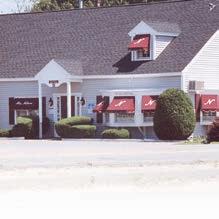




“Your house for all occasions”
“Your house for all occasions”
“Your house for all occasions”
Candies! For over 50 years we have used only the finest ingredients in our candies—cream, butter, honey, and special blends of chocolates. Call for a FREE brochure. Long famous for quality candies mailed all over the world. Treat yourself or someone special today.
Candies! For over 50 years we have used only the finest ingredients in our candies—cream, butter, honey, and special blends of chocolates. Call for a FREE brochure. Long famous for quality candies mailed all over the world. Treat yourself or someone special today.
Candies! For over 50 years we have used only the finest ingredients in our candies—cream, butter, honey, and special blends of chocolates. Call for a FREE brochure. Long famous for quality candies mailed all over the world. Treat yourself or someone special today.
292 Chelmsford Street • Chelmsford, MA 01824 For Free Brochure Call: 978-256-4061 < >
292 Chelmsford Street • Chelmsford, MA 01824 Call 978-256-4061 for Free Brochure Visit our website: mrsnelsonscandyhouse.com
292 Chelmsford Street • Chelmsford, MA 01824 For Free Brochure Call: 978-256-4061 < >
292 Chelmsford Street • Chelmsford, MA 01824 For Free Brochure Call:




(Continued from p. 94)
record that had held for nine decades. During that bitter-cold day, 127-mileper-hour wind gusts produced an impossible-to-imagine windchill of minus 109 degrees.
In preparing for my visit, I carefully followed the daunting packing list compiled by the MWOBS staff, creating my own small mountain of snow pants, hats, long underwear, goggles, mittens and gloves, snow boots, and a sleeping bag on my living room floor. The century of product development since 1934 was reassuring: Unlike the trio’s “Byrd cloth” parkas and pants, which were made of a densely woven cotton cloth promoted by polar explorer Richard Byrd, my gear was fabricated from light-but-tough synthetic fabrics filled with very fine strands of polyester microfibers.
During the week leading up to my trip, I had tracked the mountaintop forecast via the observatory’s website, and there were some promising signs that a storm might come through. But when we finally reached treeline in the snowcat, I saw that much of the Mount Washington Auto Road had been cleared of snow in anticipation of opening in late May. As we climbed, we encountered some sections that were still frozen, and I felt grateful for the spiked tractor treads that rumbled under us, sinking their steel teeth into the thick ice.
Arriving at the summit at noon, we were greeted by wind blowing up to 100 miles per hour—a sustained rush of air, like an indomitable river. To prevent the duffels and boxes of dried pasta, canned beans, and jars of peanut butter from being blown away, our driver backed the snowcat up to the service entrance of the MWOBS building so we could unload in its shelter.
I followed the staff down into the bowels of the building and tossed my duffel onto one of the two bunkbeds in my assigned room, named after McKenzie. It was like a ship’s cabin,
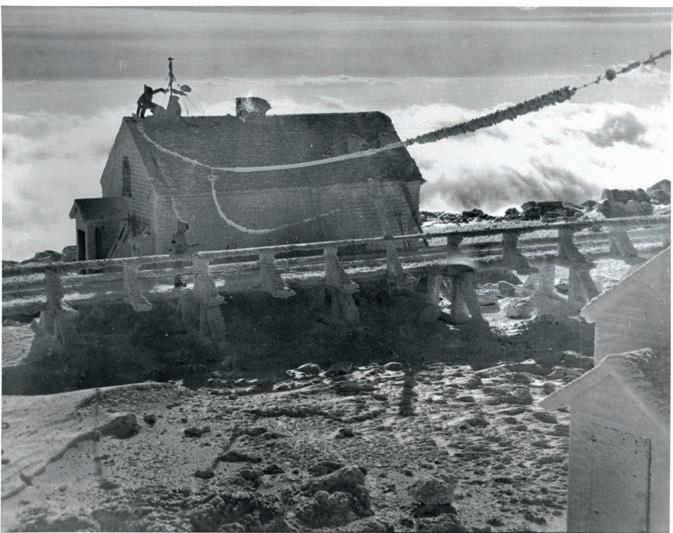
ABOVE: A weather observer takes readings atop the building that served as the Mount Washington Observatory’s winter home in its earliest years.
RIGHT: The “Number 2 Heated” anemometer, which measured the world-record wind of April 1934, is shown in the hands of late1930s weather observer Aubrey Hustead.
cramped and dark. It was impossible to see through the cabin’s small, heavily reinforced window; like nearly all the rest in the building, it had long been sandblasted by rushing winds and the debris they carried.
The room was chilly. I snuggled down into my sleeping bag and began re-reading World Record Wind: Measuring Gusts of 231 Miles an Hour, McKenzie’s 1984 account of that incredible day. The slim volume is filled with log entries made a century ago, when he and the other observers felt, heard, and recorded a wind like no other. As I read, I listened to that constant, muscular, unearthly wind, like the dull roar of an airborne ocean.
ington’s official winter occupation in the 1930s was a call by the Second International Polar Year Commission to “record continuously the variations of all the meteorological elements” at high altitudes around the planet. Scientists hoped that by logging the conditions and analyzing data “at levels
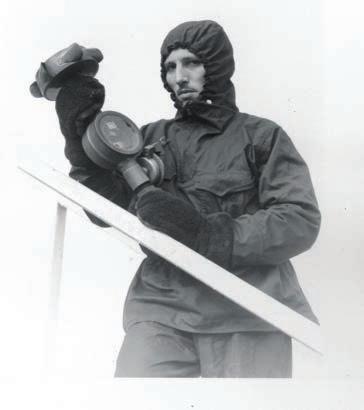
uncontaminated by local irregularities and peculiarities on the earth’s surface,” they would unlock the secret of the atmosphere in its entirety.
But if there was something significant happening a couple of miles up, only mountaintop observers would be close enough to gain a clear picture of the engine driving the planet’s weather. Mount Washington was a particularly desirable location for a weather station because it was accessible: close to civilization, with a cog railway and an auto road that could facilitate provisioning the weather observers with coal, gasoline, kerosene, and food.
At the time, scientists understood little about the larger forces that create droughts, hurricanes, and del -
uges, but some were gathering clues. In 1926, Japanese scientist Wasaburo Ooishi had published a report about a phenomenon he had observed while launching weather balloons near Mount Fuji. When released, the balloons would float up thousands of feet, then inevitably be swept east by a powerful and consistent westerly that appeared to blow more than 200 miles per hour—faster than any wind yet recorded on the planet.
By the 1930s, more accurate weather forecasting was seen as a way to build a more robust economy. While aviation was in its infancy, people were already imagining an era of passenger flights, which of course would be vulnerable to atmospheric shifts. Better weather forecasting would also benefit agriculture, trade, and shipping.
It took World War II for meteorologists to understand the general workings of the earth’s atmosphere. Pilots flying at high altitudes not only confirmed what Ooishi had discovered (and the Mount Washington observers had recorded), but also offered a picture of its strength and magnitude. There was a river of air up there, they said, with such a strong current that when they flew against it, they practically stood still.
What the pilots found was the jet stream, the heartbeat of the world. That rush of air that sends hats flying and forest fire smoke billowing across the sky is part of a complex system of ever-changing air pockets pushed around the globe by four serpentine currents that ring our planet: one near each pole, and two closer to the equator. These are the whooshing, spinning spirit of the world, forever moving about us, nourishing and cleansing the earth. There’s simply nothing else that so completely ties us together, everywhere, all at once.
Sitting at 44 degrees north, the Northeast’s highest peak feels the direct effects of this mighty river, as the northern polar jet stream meanders north, south, and over its location. And because Mount Washington lies in the path of major storm tracks traveling west to east across
North America, those winds can pick up remarkable speed as they race unchecked over roughly 1,500 miles before charging up the northwestern slope of the mountain.
One more fascinating reason that Mount Washington experiences
a wind stirred from the southeast, sending ice crystals sweeping across the blue sky in the form of wispy cirrus clouds. The idea of a weather “front” was brand-new, its nomenclature an artifact of its discovery right after World War I. The phenomenon
All night, the wind assaulted the cabin, sending the anemometer pen zigzagging madly across the record sheet and shaking the door in its frame.
some of the world’s worst weather: When that massive volume of wild air howls up to the summit, it finds itself squeezed under the tropopause, the invisible boundary between the two lowest layers of our atmosphere. Compression then compounds the wind’s speed, similar to what happens when you put your thumb over the end of a garden hose. As a result, winter winds atop Mount Washington regularly exceed 100 miles per hour and the temperatures drop well below zero. And because the jet stream also sweeps up all manner of small, local weather systems in its path, storms can barrel into the White Mountains seemingly without warning, surprising unfortunate climbers who looked up an hour ago and only saw blue sky.
ALL THAT WINTER OF 1933–1934, Pagliuca, Stephenson, and McKenzie recorded the mountain’s many moods. They kept their equipment running, jotted down their findings, and sheltered adventure seekers who had braved the elements to reach the summit. They also spent an inordinate amount of time feeding kerosene and coal into their stove and generator.
On April 11, there was much life inside their minuscule cabin. The trio had been joined by two friends of Pagliuca who’d climbed the mountain the day before, plus three cats and five newborn kittens (feline residents have remained a constant presence at the summit ever since).
Throughout that day, the weather gave ominous signs. In the morning,
was first proposed by Norwegian scientist Vilhelm Bjerknes, who argued that weather was dictated by the movements of cold and warm pockets of air swirling around the planet. When they banged up against each other, he wrote, that’s when we experience all the gifts and punishments of the skies.
Bjerknes’s observations and mathematical analyses of these systems had shifted meteorologists’ interest from the barometer to the sky, and Pagliuca read the clouds as portents. On that morning, he stood on the summit of Mount Washington, gazed clear to the Maine coast, and pronounced it an “emissary sky.” A few hours later, stratocumulus clouds gathered into a dome above the mountain, then settled down and enveloped them.
Carried from the east by high winds, these clouds brought “rough frost,” wrote McKenzie. Quite different from the dry rime to which they were accustomed, it created a dangerous dampness for the men going about their chores on the exposed mountaintop. Rough frost, McKenzie wrote, “tended to permeate our garments and then freeze into a thin ice armor.”
Throughout the day, McKenzie maintained radio contact with colleagues at the Blue Hill Observatory in Massachusetts some 180 miles away, as well as amateur radio enthusiasts following the weather in the surrounding country. The barometer
(Continued on p. 117)




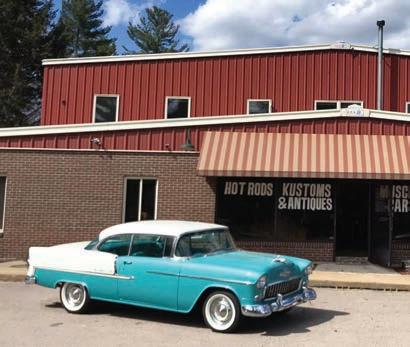
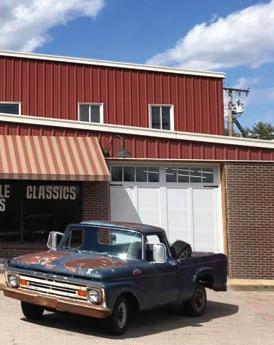



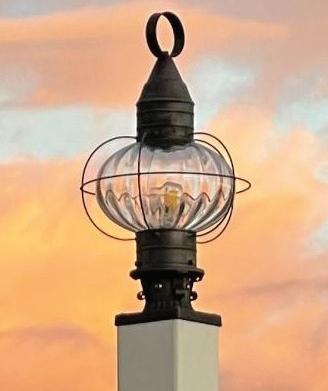


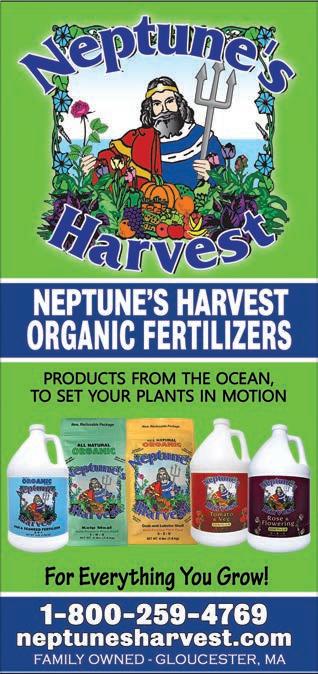
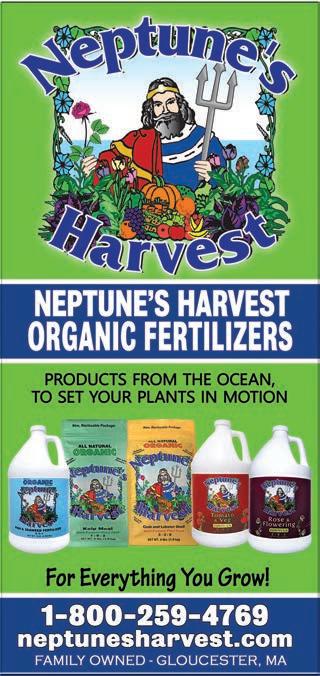




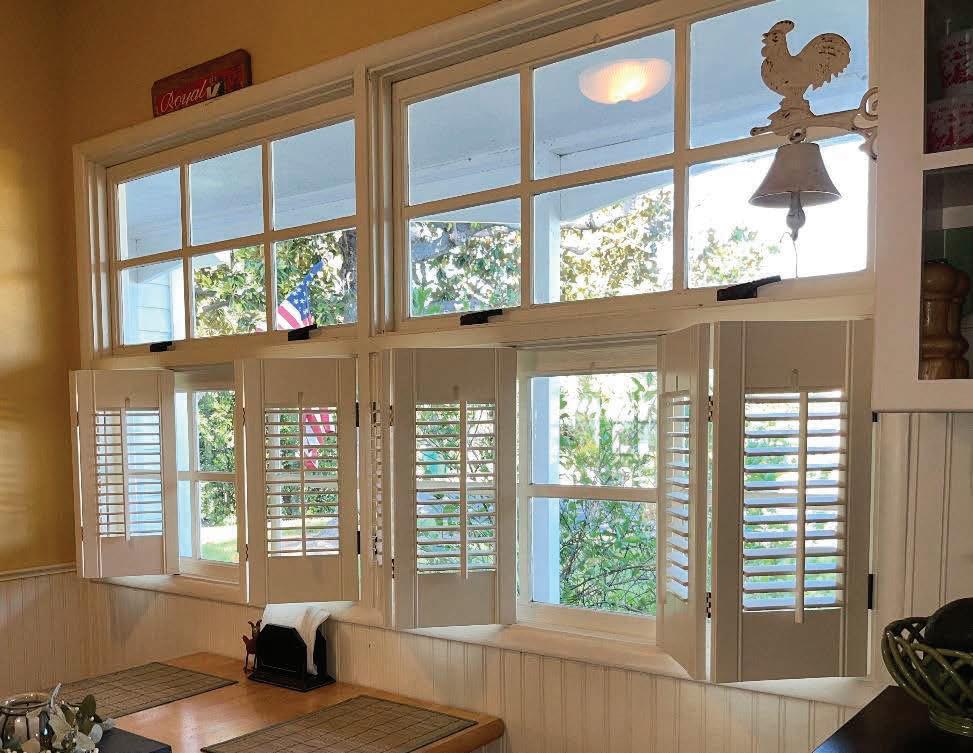































EnergAire continuously puri es up to 4,000 cubic feet (a large room) of air and makes it breathable and invigorating. Restores natural ion balance to unhealthy environments caused by industrial pollution, automobile exhaust, central airconditioning, and heating, smoke, dust, pollen, animal fur. . . removes microscopic pollution particles not removed by any other method of air puri cation. EnergAire was rated Number One for speed of removal of cigarette smoke by the leading U.S. consumer protection magazine. It has no noisy fan, no costly lter, and requires no maintenance. Uses less than 2 watts. 9" high. 3" diameter. Weighs less than 1 pound. $69.95

RODAR is the super-powerful professional ultrasonic pest repeller with up to 60 or more times the power of other devices — and power is what makes RODAR so e ective. RODAR ultrasound equals a jet engine — noise unbearable to pests but at frequencies humans and pets cannot hear. RODAR units are completely safe. RODAR drives pests out and keeps them from getting in. Handsome simulated walnut cabinet 5-5/8" high. Weight 1-1/2 pounds. Uses less than 5 watts. $99.95


90-day money-back guarantee — 12-month warranty.To order: Send cost for unit(s)





NewEngland–Acadian Forest explores how conifers have influenced the course of human history.
Order at www.umasspress.com and use code YANKEE at checkout to save 25%










(Continued from p. 113)

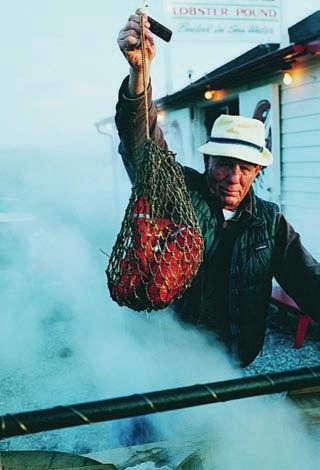
in the cabin continued to drop, and wind speeds increased to 124 miles per hour. The men were both anxious and excited to see what this storm had in store for them. After evening chores, everyone but McKenzie climbed into the attic to nestle under blankets close to the warm stovepipe.
All night, the wind assaulted the cabin, sending the anemometer pen zigzagging madly across the record sheet and shaking the door
himself as usual for the northwesterlies, he found himself face-down in the snow. A southeasterly blast had upended him from behind. Stephenson recovered and, with great effort, climbed to the roof of the cabin with a wooden club he used to knock the anemometer free of ice. The moment he loosened his grip on his stick, the wind swept it away.
A hurricane-style storm was well under way. Later that morn -
“We had measured ... the highest natural wind velocity ever recorded officially anywhere in the world,” Pagliuca wrote, before adding, “Will they believe it?”
in its frame. Arctic blasts splintered through cracks in the window sash; the stove struggled to give warmth. The cats, the smartest of all creatures, piled into a cozy feline mound in a box on a shelf behind the stove.



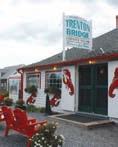
The wind shook the building with every gust, threatening to tear it from its mooring and hurl it into the ether. Although experience had taught the men to trust their shelter, now insulated with a foot of ice all around, they listened even in their sleep for the terrifying sound of a snapped chain.
Before dawn on the morning of April 12, 1934, Stephenson awoke, acutely aware of the bellowing wind. His instruments claimed it was blowing at only 105, but the sounds outside were like nothing he’d heard before. Ice must have built up on the anemometer overnight, disrupting accurate recording. He had to knock it free.
Fumbling in the dark and cold, Stephenson climbed into his snow suit, tucking the inner skirt of his parka into his snow pants. Wearing thick, gauntlet-like gloves, he tugged at the handle of the cabin door, but the rushing wind created a vacuum so strong he had to fight to open it; when he finally stepped outside, bracing
ing, Pagliuca wrote in his diary that they’d logged several 172-mile-perhour gusts. While he was riveted to the wind speed recorder, the rest of the crew kept busy. There was work to be done, a welcome distraction from that confounded wind and the chilling thought that the cabin might, at some point, be blown to smithereens. The stove in the kitchen was rigged to generate electricity to help keep the anemometer free of ice. It gulped kerosene, so the volunteers chipped the 55-gallon drum free of ice to refill it.
As the day wore on, everyone was “beginning to be a bit edgy,” wrote McKenzie. Cabin fever was setting in, compounded by the relentless wind. Before noon, he was astonished to see the highly reinforced window behind the stove bulging inward during gusts. They were now timing speeds of 220 and occasionally 229 miles per hour. No one knew how long the cabin could stand against that kind of force.
Then, at 1:21 p.m. on April 12, 1934, the extreme value of 231 miles per hour out of the southeast was recorded. “Twice I yelled the time so that [my companion] could put it down on paper,” wrote Pagliuca in the official logbook. He then seized his slide rule to extrapolate

A modern-day Mount Washington Observatory intern battles against a wind on the observation deck that, while not shattering records, threatens to sweep the summit’s inhabitants off their feet. his calibration curve once again and confirm what he had witnessed. It was true.
Pagliuca could not contain his awe. “We had measured by means of an anemometer the highest natural wind velocity ever recorded officially anywhere in the world.” He added, “Will they believe it?”
I AWOKE WITH A KNOCK. COCOONED in my sleeping bag, I’d slept away the afternoon, dreaming of the smoky cabin half-buried in snowdrifts. Jay Broccolo, director of weather operations, was ready to take me into the wind, and again I became aware of its pervasive drone. I zipped and fastened layers upon layers of gear, then huffed and puffed up the concrete silo’s three-story ladder, following Broccolo to the roof. As we climbed higher, the entire structure shivered and groaned with pressure of the wind. At the top of the ladder, Broccolo pulled open the small exterior door, and I crouched to follow him through.
When I stood up, I was relieved to see that a waist-high wall protected the outdoor walkway that skirted the silo. Without it, I’d be pinned against the wall. Even so, all my senses recalibrated to withstand the blast. Broccolo had told me to put my ski goggle strap over my hat, which was the only reason both were still on my head. I gazed northwest, straight into the wind, then west where the horizon glowed faintly from the last rays of our distant sun. Broccolo motioned for me to follow him around to the lee of the silo, and in that sheltered place, I barely heard him as he called out the snowy mountain peaks before us.
Then he pointed up one half-flight to the highest point of the observatory, where two pitot tube anemometers stood in the wind on slender legs, like sandpipers. He motioned that I should go up to experience the full force of the wind.
I hesitated, then seized the ladder and stepped onto the first rung. When I reached up to shake hands
with the wind gods, they knocked my arm back. Determined now, I kept going, crawling onto the three-footwide platform, girded with a circular handrail. With difficulty, I stood up, grabbed hold, and faced straight into the winds.
They rushed by, as they have for hundreds of millions of years. In their embrace, I felt the sublime, like stargazing on a cloudless night, shivering in the absolute freedom that I am nothing, of no consequence. The winds raced on, over and around me—a mere twig in their path—on their journey across oceans and continents. I stood there for an eternity, marveling at the force of creation.
To learn more about the Mount Washington Observatory’s weather work, complete with web cams and daily logs, go to mountwashington.org.
(Continued from p. 120)
of it, anyway—was sold. My Aunt Deanna built a house on the handful of acres she’d held on to, but my cousins had long since moved away, and my life had become the complicated thing that almost anyone’s life becomes, and so I’d not returned to my mother’s birthplace in the intervening years. Nor, in fact, had my mother.
Until this summer, when my mom, approaching 84 years of age, expressed her desire for one last visit. She is in fine health except for hearing loss that turns casual conversation into a cacophony of raised voices and comical misunderstandings. She also has declining cognition that mostly presents as short-term memory loss, but it seems likely to progress into something more challenging.
She had an uncomplicated and rather ordinary agenda: to visit the cemetery where her parents and brother lie, and to see the place that had shaped her so profoundly. Certainly, to walk the old lane that led down to the cropland that had provided for her family, and perhaps to drive the narrow roads she’d ridden thousands of times as a child—to school, to aunts’ and uncles’, to town, to church.
We landed in Iowa on a clear, cool day. My father, who at 81 is as terrifyingly nimble of mind as ever but arguably past his prime traveling years, had come along, and soon the three of us were speeding across that uniquely Midwestern landscape, where the horizon is forever receding, the sky and land meeting at some distant point that seems attainable but, try as you might, you can never quite arrive at, like trying to locate the end of a rainbow.
We stayed for three days and did all the things my mom wanted to do, and a few more besides. We drove to the Mississippi and stood at the edge of the water, and marveled at the sheer size of it, a mile wide in spots, forever coursing its way downstream. We tried to drive past her high school, in a two-road town a few miles east of the farm, but the building was gone
and there was only grass, short and sparse. Beyond that, corn stood tall, ready for harvest.
One of my cousins came down from Chicago with her daughter for a day, and we passed many hours sitting around the kitchen table and talking, drinking endless cups of coffee, just the way it had been at my grandparents’ house a half century ago: endless pots of Folgers and reminiscing about nothing that would seem the least bit important to anyone but those who were gathered there. My mom, I could see, was ecstatic, and it occurred to me that the very ordinariness of the visit, and the many ways it resembled life on that farm all those years ago, was exactly what she’d wanted.
I think often about how a place shapes a person. What parts of my mom—what parts of anyone?—are the way they are simply because they were raised in a particular place? Of course, every place has its people, and those people make a culture, and there is always the influence of that. But what about the land itself? What
might it do to a person to live where the horizon is forever receding, where in many places corn is all you can see for as far as you can see? Is this why my mother is always so curious, why her mind—even as it’s now shifting (perhaps especially as it’s now shifting)— remains so open, like the landscape of her childhood?
I think of my own love for the winding gravel roads of Vermont that have been central to my life since birth, and how they relax me. How they help me think. I think of the hardwood forests surrounding my home, especially the ones along the mountain ridge I can just catch a glimpse of through my kitchen windows. In the winter, I ski that ridge almost daily, and as inhospitable as it can be—10 below zero, the wind raw and unforgiving, the trees gnarled and hardened by age and weather—I think it might be the place I feel most at ease. I think it might be the place that, when I’m 84 and I can no longer pretend that my time isn’t nearing, I’ll ask my sons to help me visit one more time.















Some places we never leave, but instead carry with us all our lives.
ILLUSTRATION BY TOM HAUGOMAT
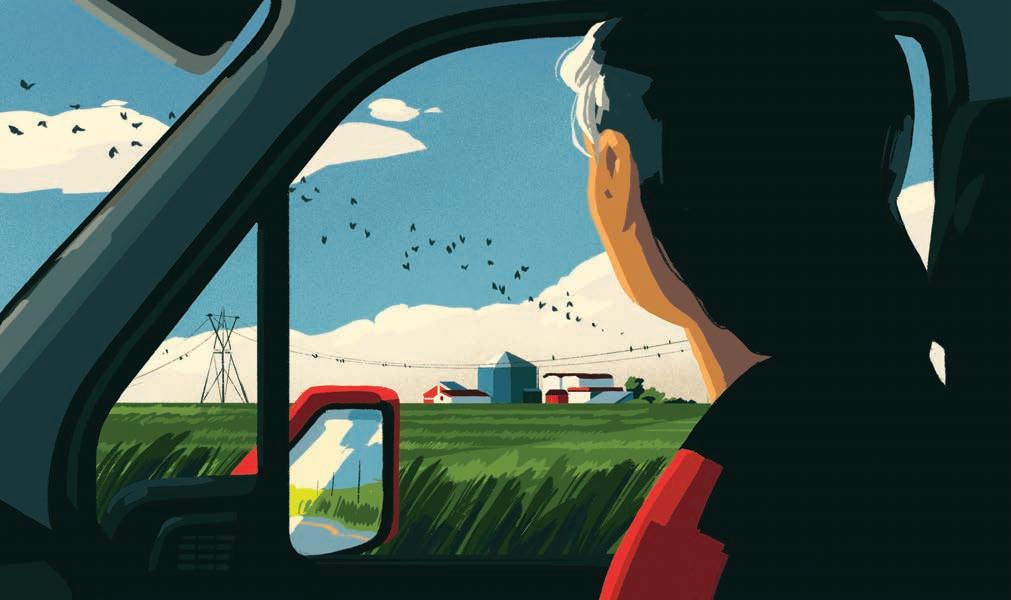
My mother was raised on a farm tucked into the southeast corner of Iowa, barely spitting distance from the Mississippi River to the east and the Missouri state line to the south. Her mother was one of 12, her father an only child, and she had two younger brothers with a proclivity for bolting engines onto homemade contraptions that seemed engineered to navigate directly to the nearest emergency room.
We traveled to my grandparents’ farm frequently when I was a child. Often, we’d stay for weeks at a time. I’ve written before of how much I
looked forward to these visits: There were my cousins, three girls, all vaguely mysterious to me in the way girls are to a boy with more fingers on his hands than years in his lived experience. There were my grandparents—my grandmother eager to spoil me with a freezer full of Schwan’s ice cream push-ups and trips to the mall for new jeans at JCPenney, my taciturn grandfather offering rides in the combine and, if I was really lucky and our visit coincided with the annual harvest, the grain truck. There was also a color television (with a remote control!), and if it was winter and there was snow on
the ground, my Uncle Jake would tow my cousins and me in a sled behind his Honda “Big Red” three-wheeler.
It’s astounding to realize that it’s been 45 years or more since I rode in my grandfather’s grain truck, or sledded behind my uncle’s ATC, or tore the paper off the top of a Schwan’s ice cream push-up. I’d last been to Iowa in 2006, following my grandmother’s death; my grandfather had died seven years before, my Uncle Jake would die nine years later, and somewhere in the midst of all that, the farm—or most
(Continued on p. 119)

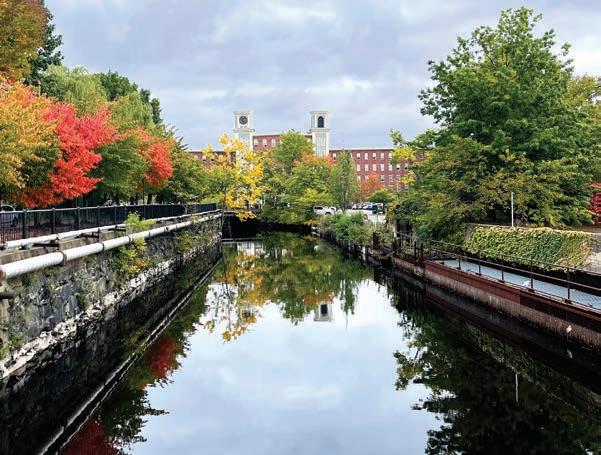
Download your free digital guide, and discover how captivating this scenic and easy-to-navigate region is year-round.
